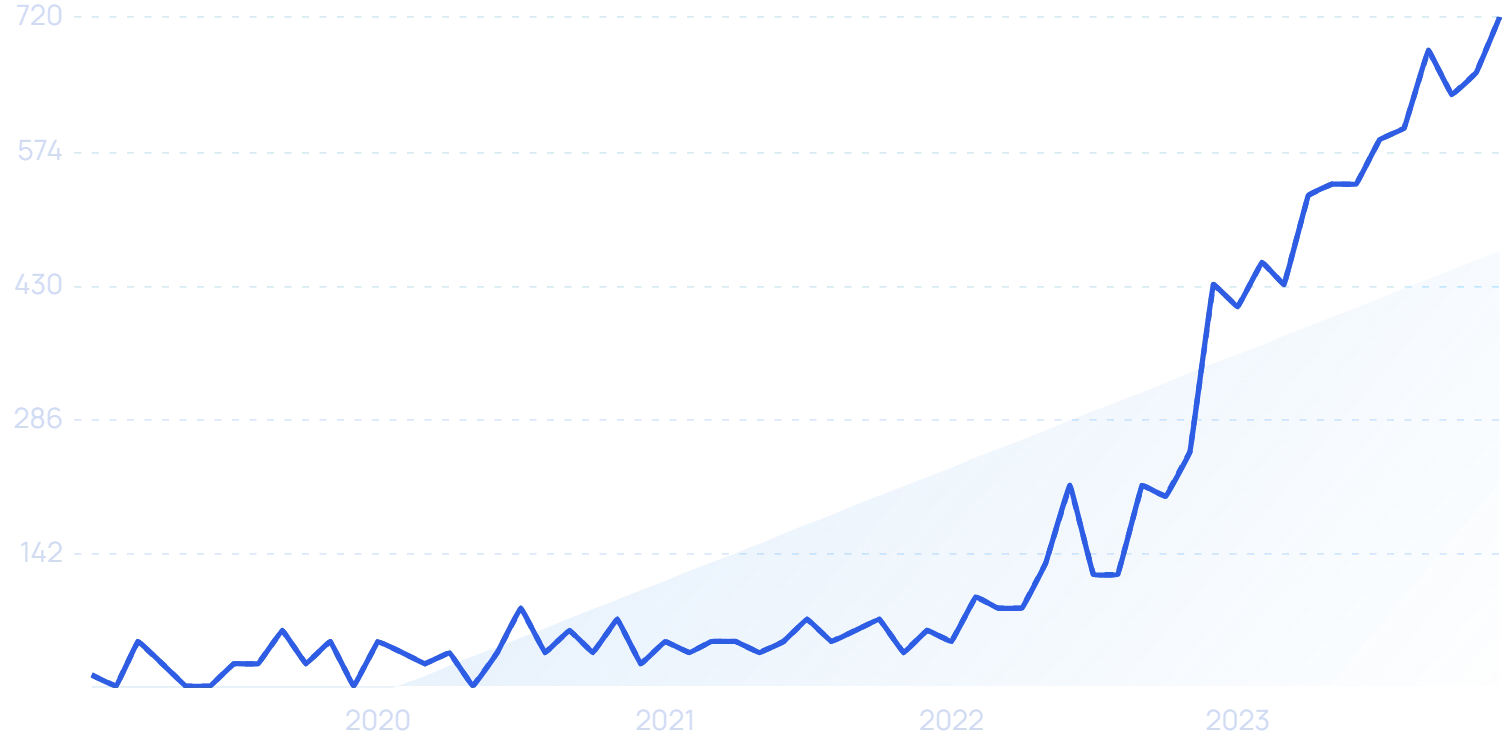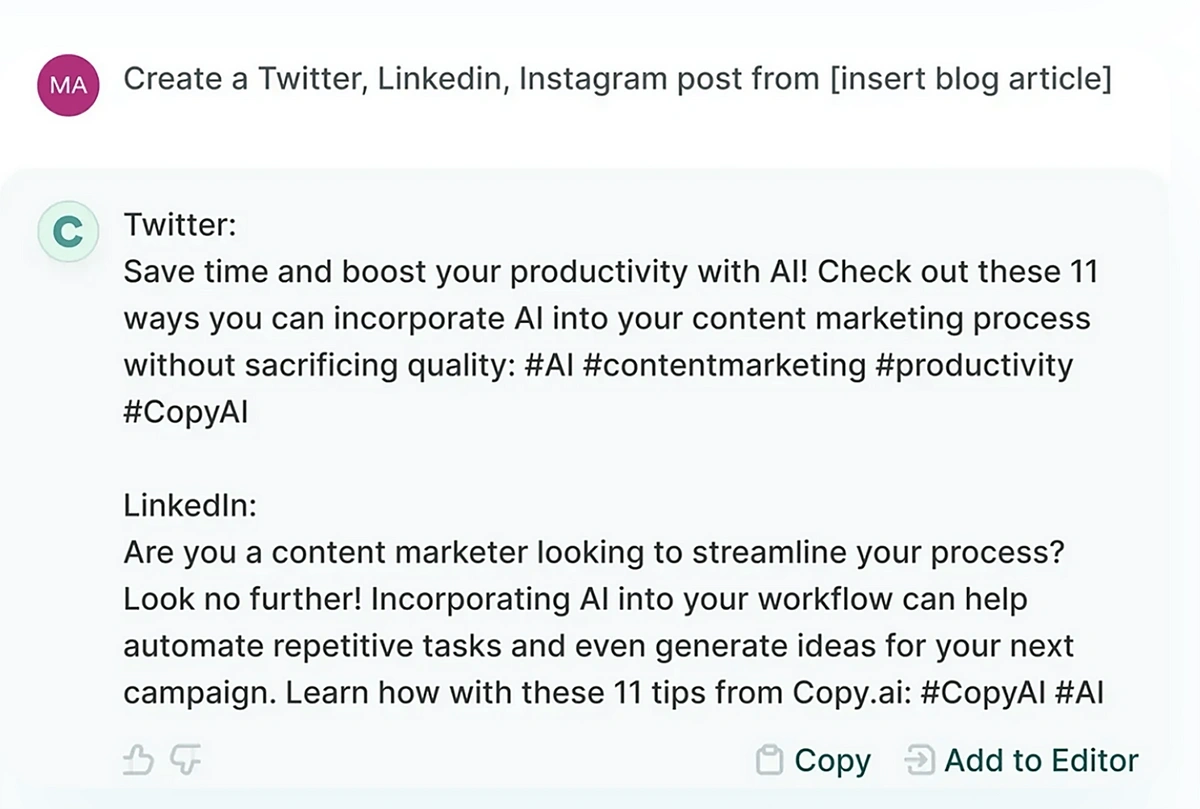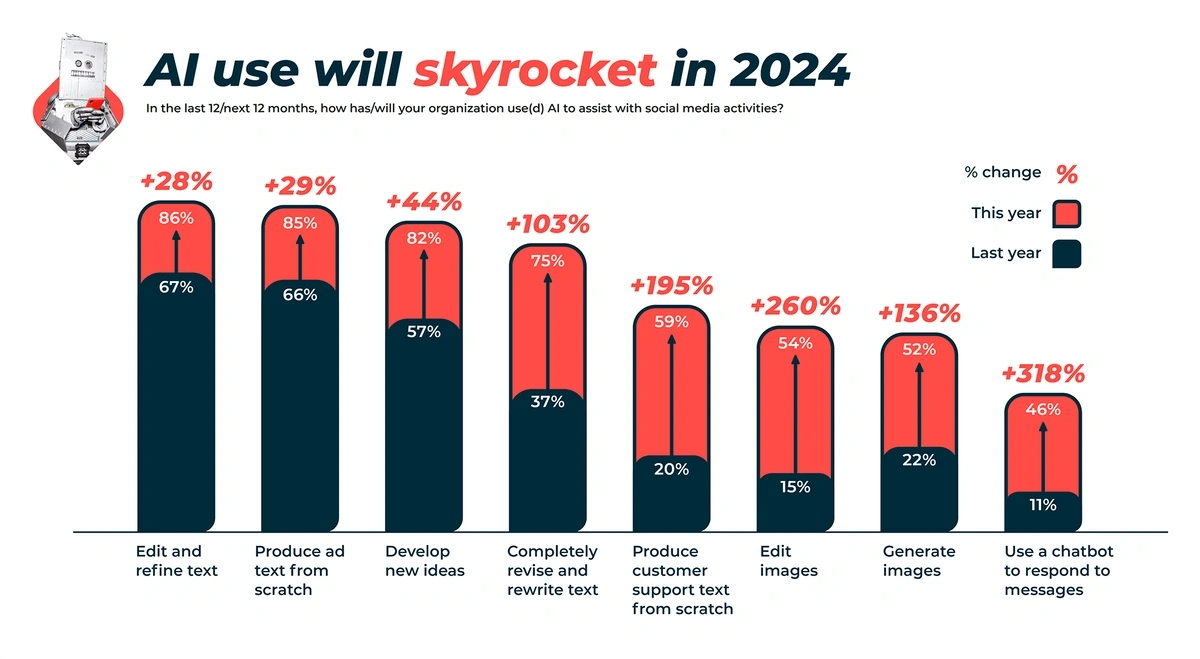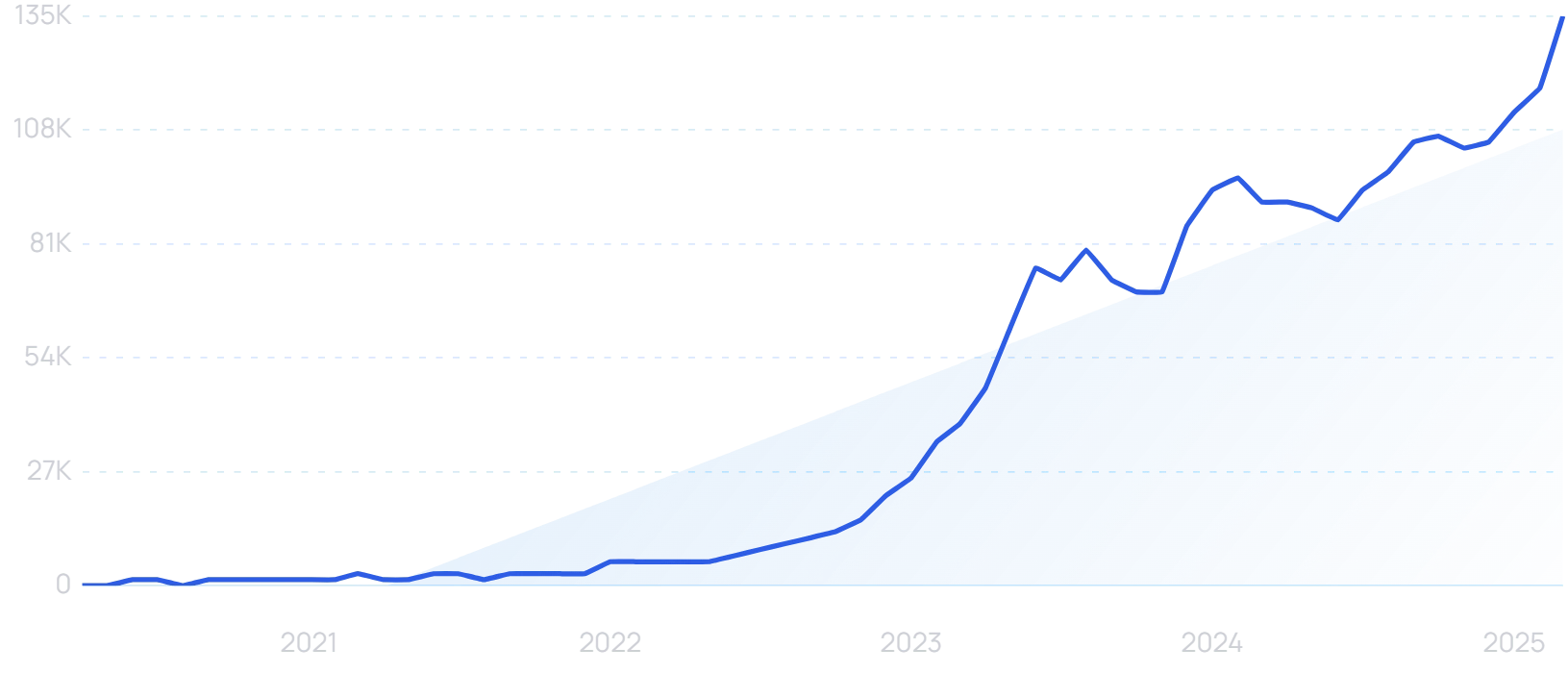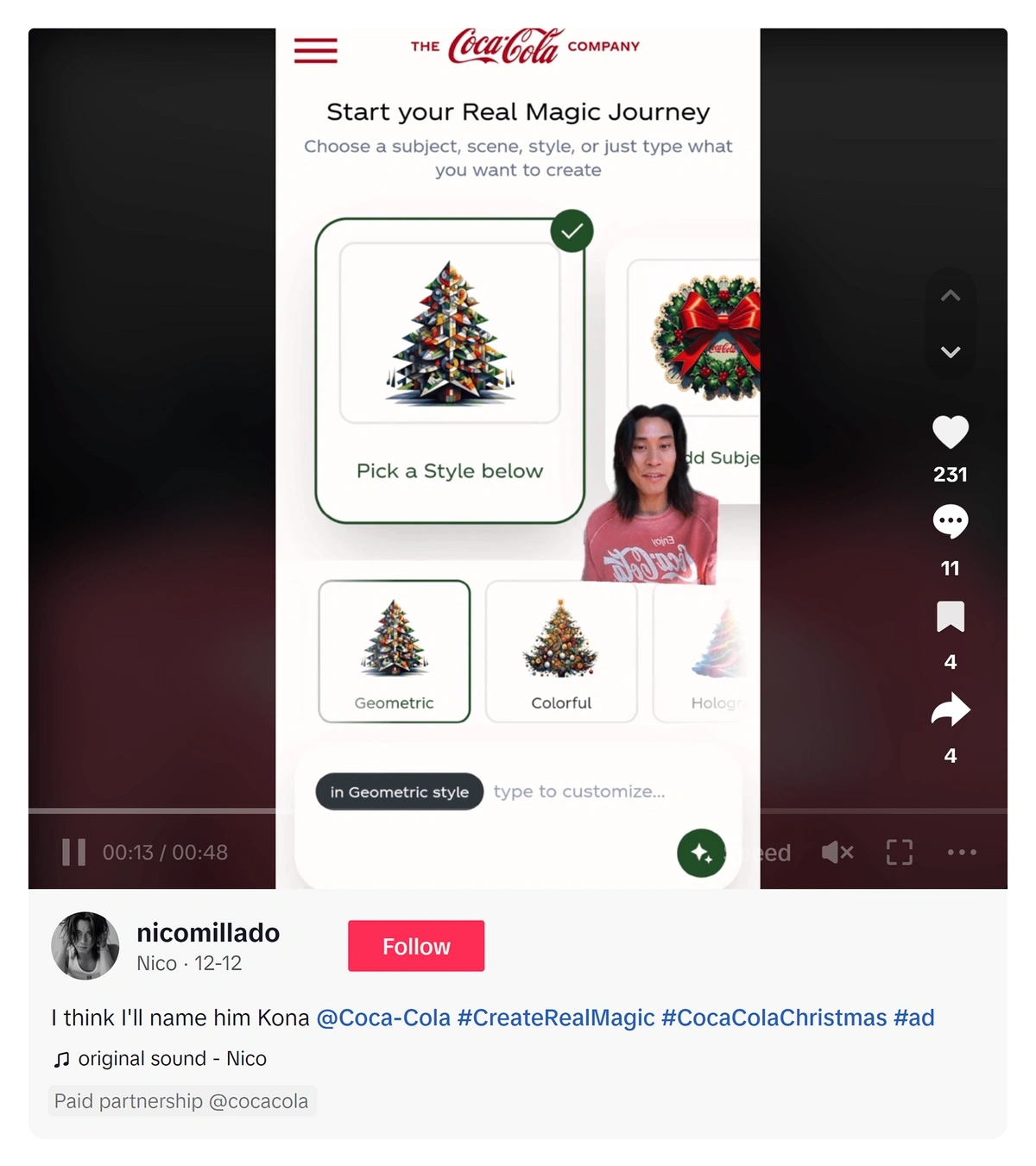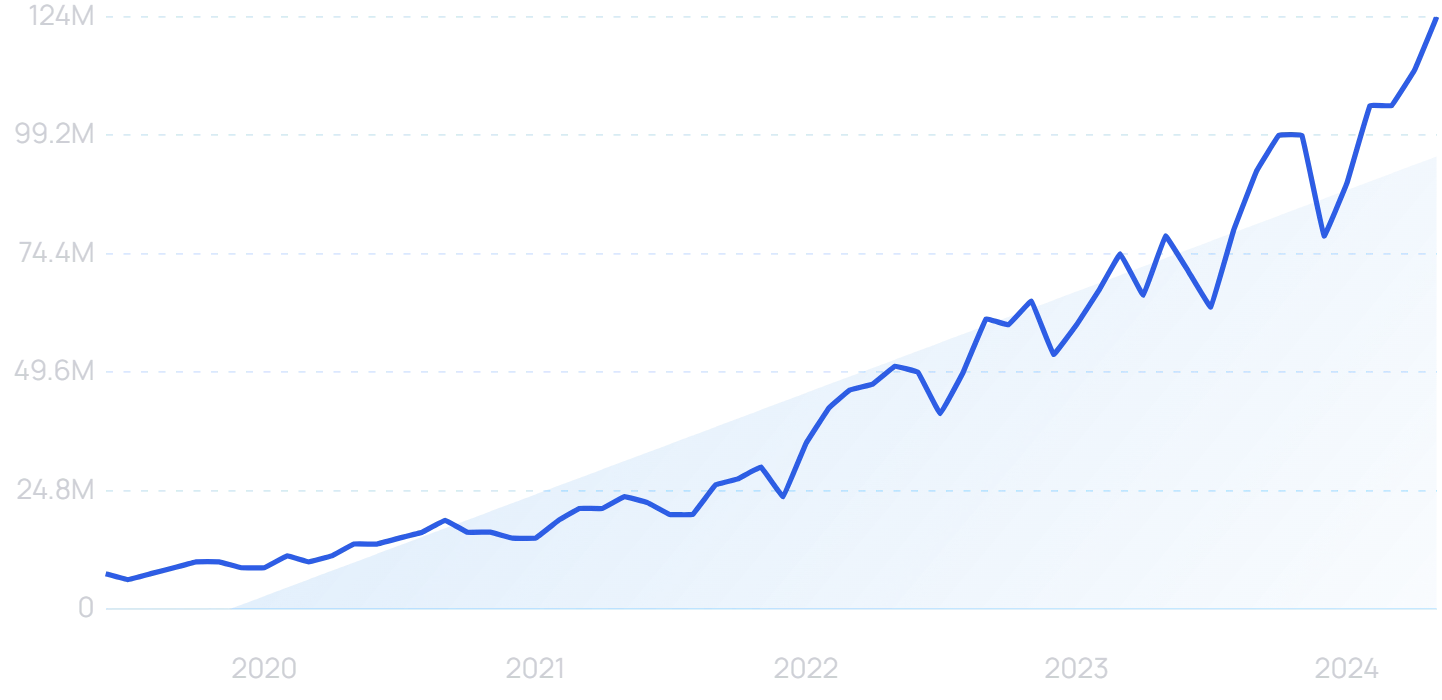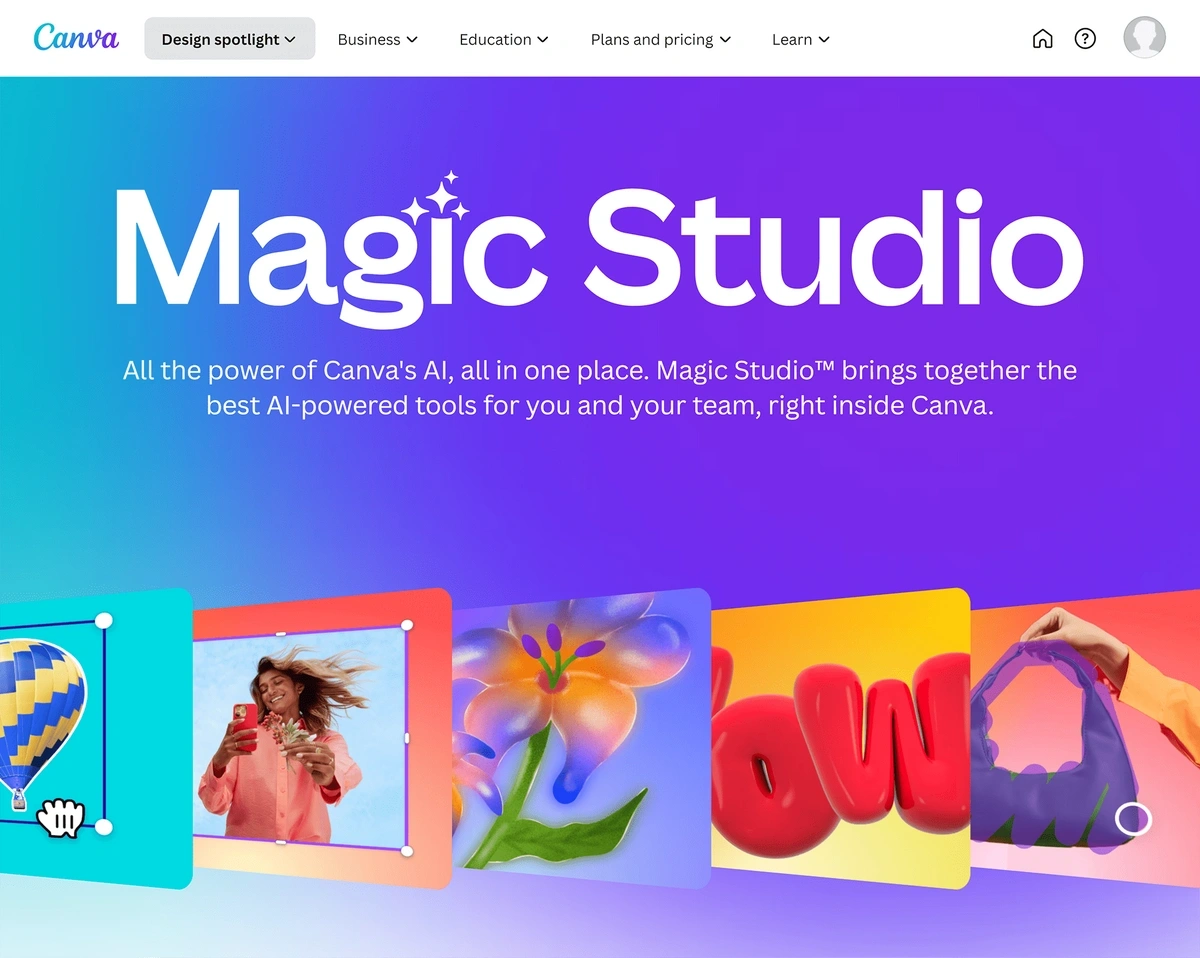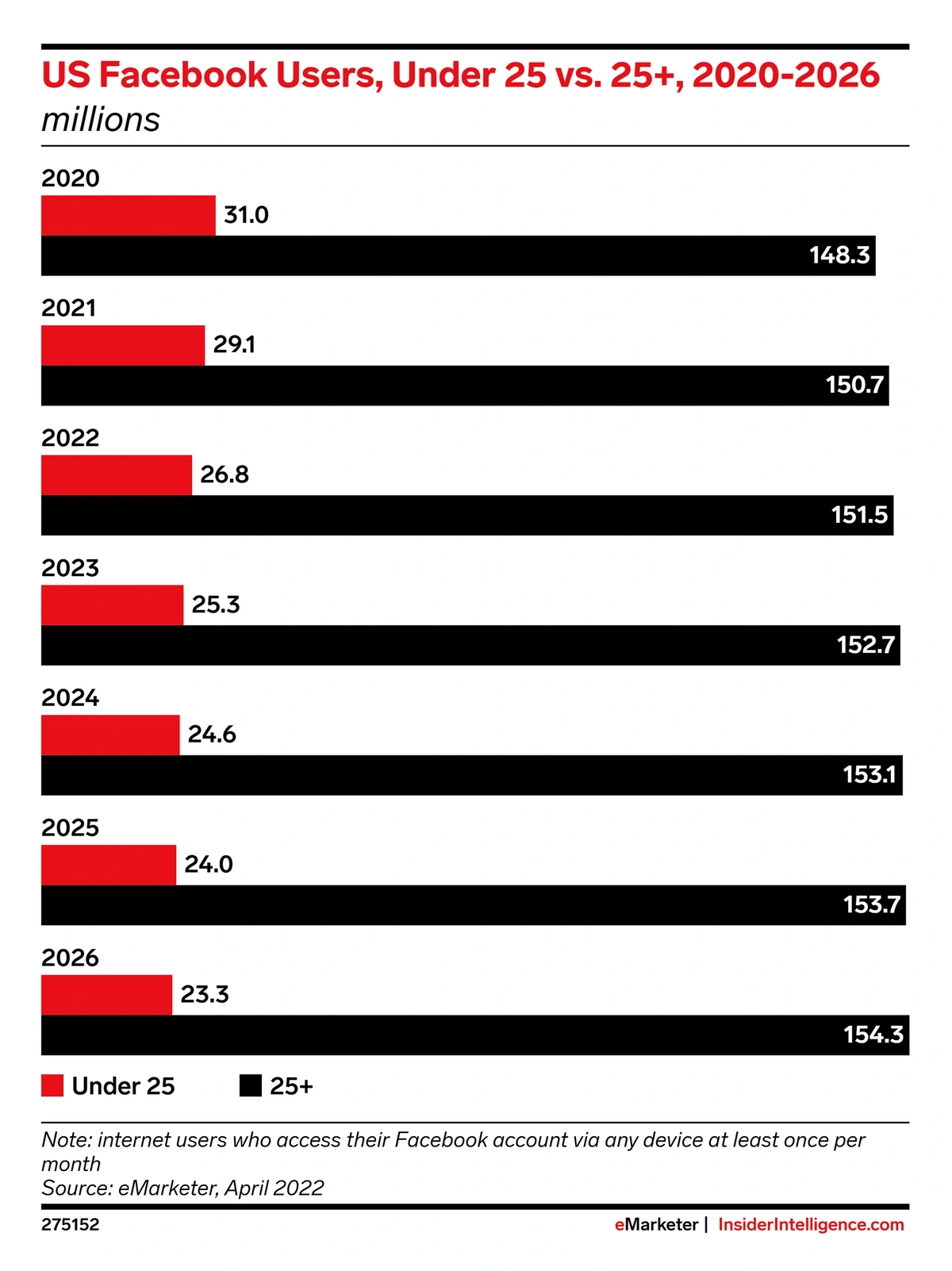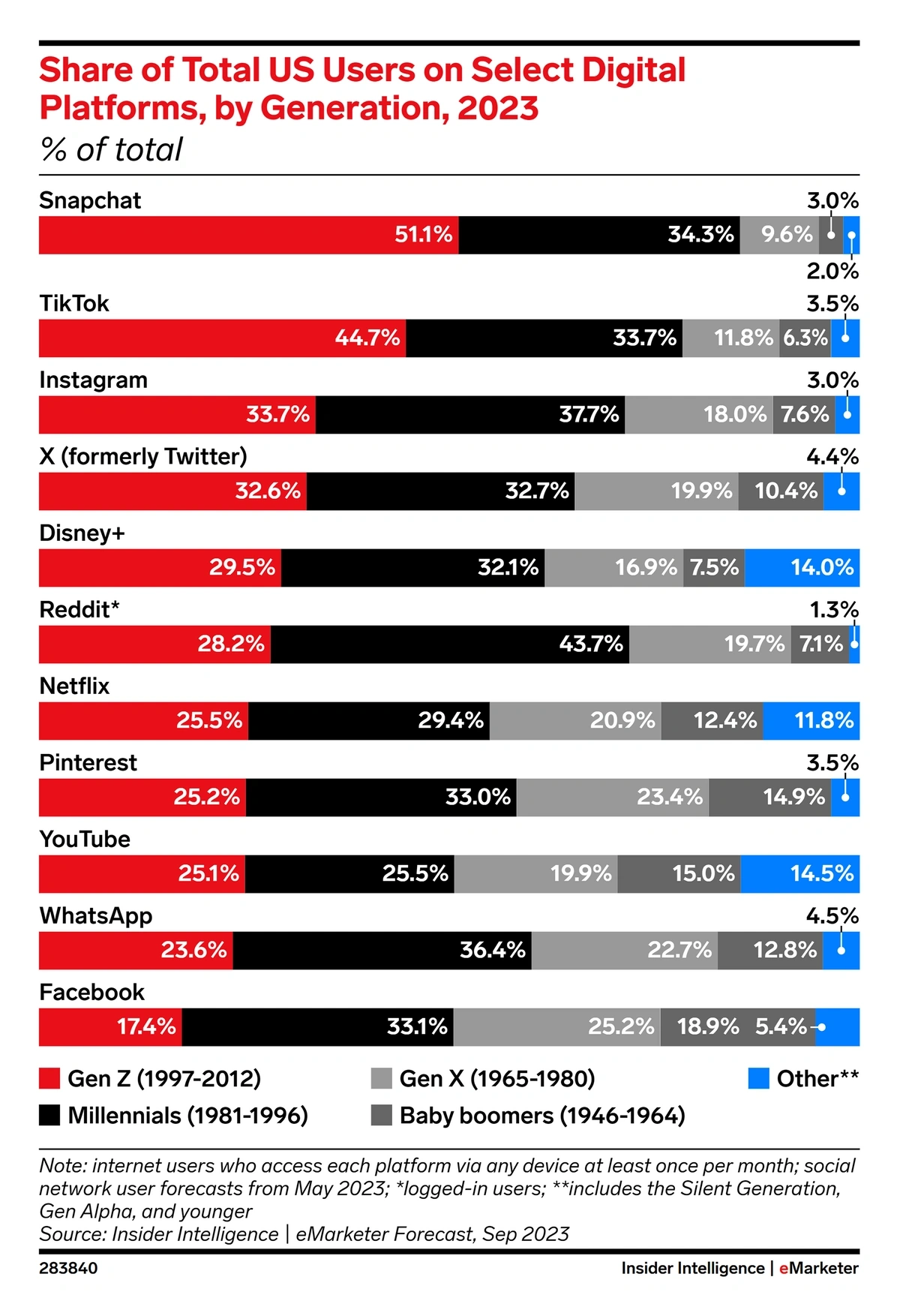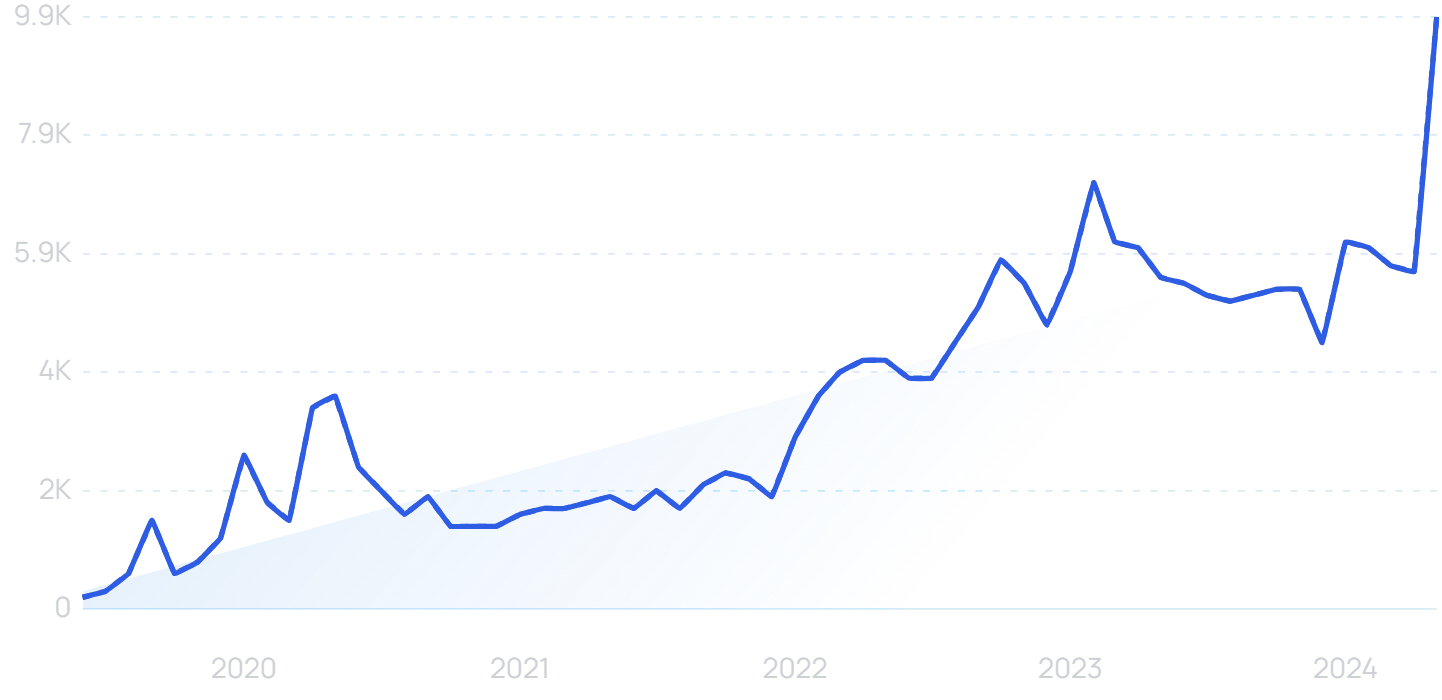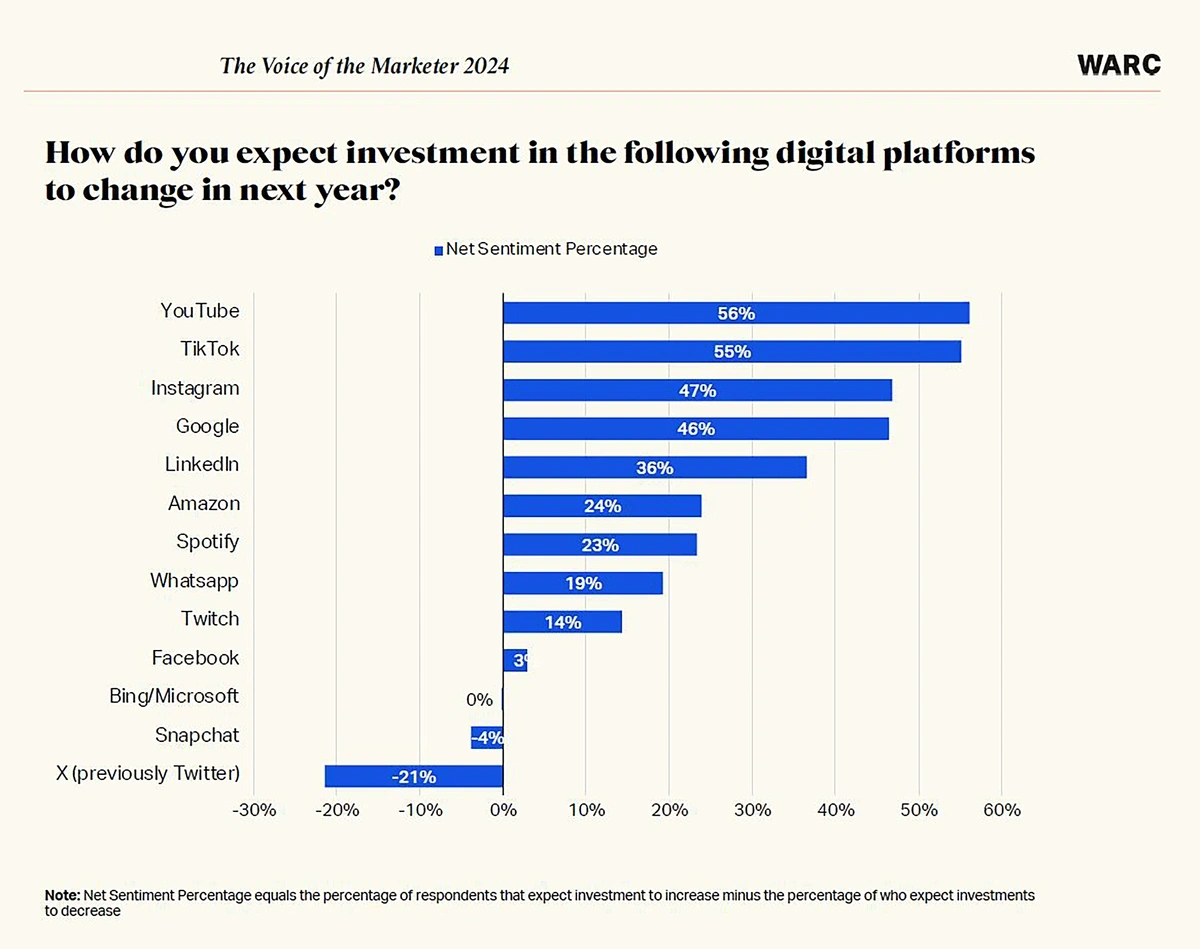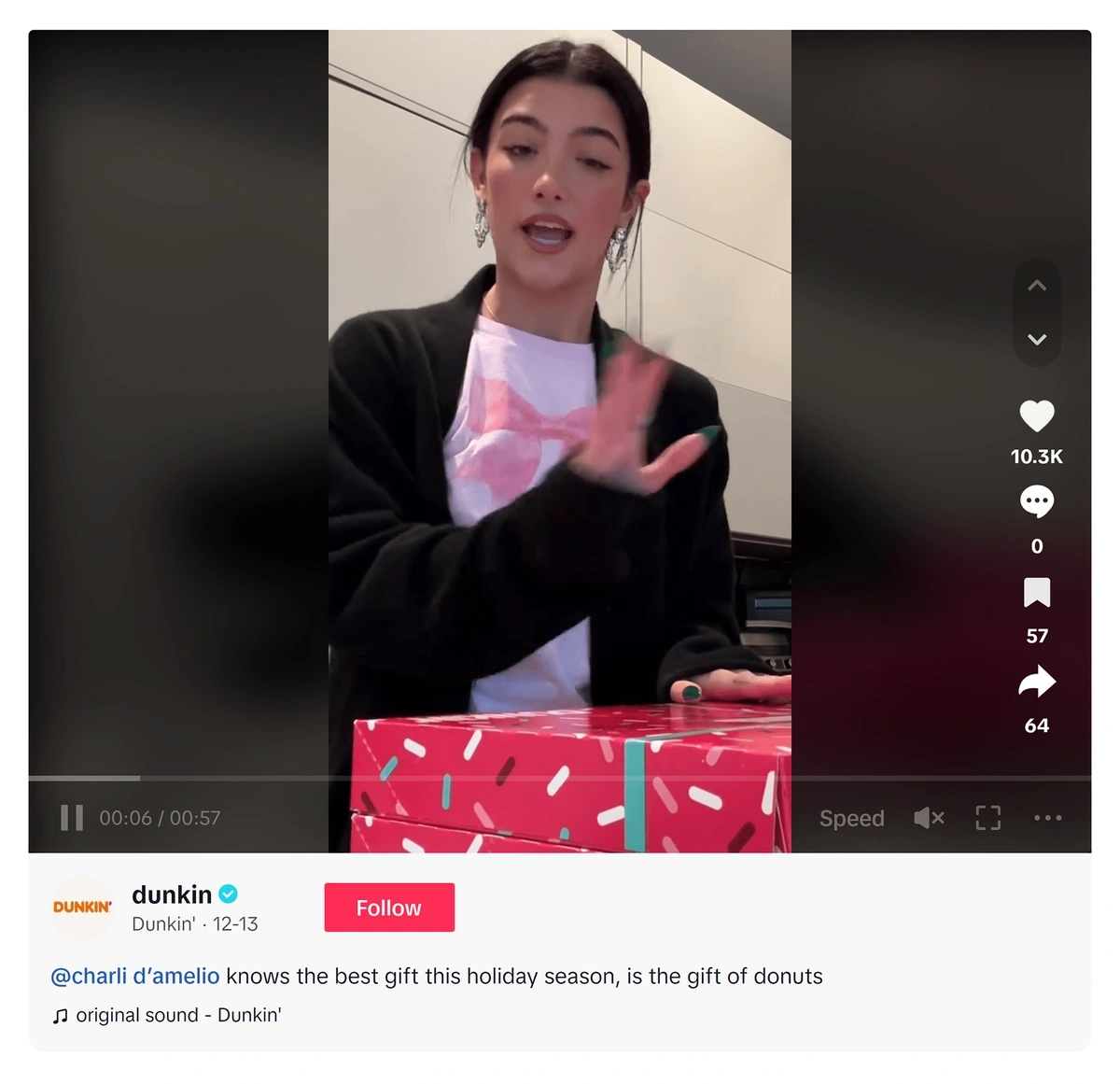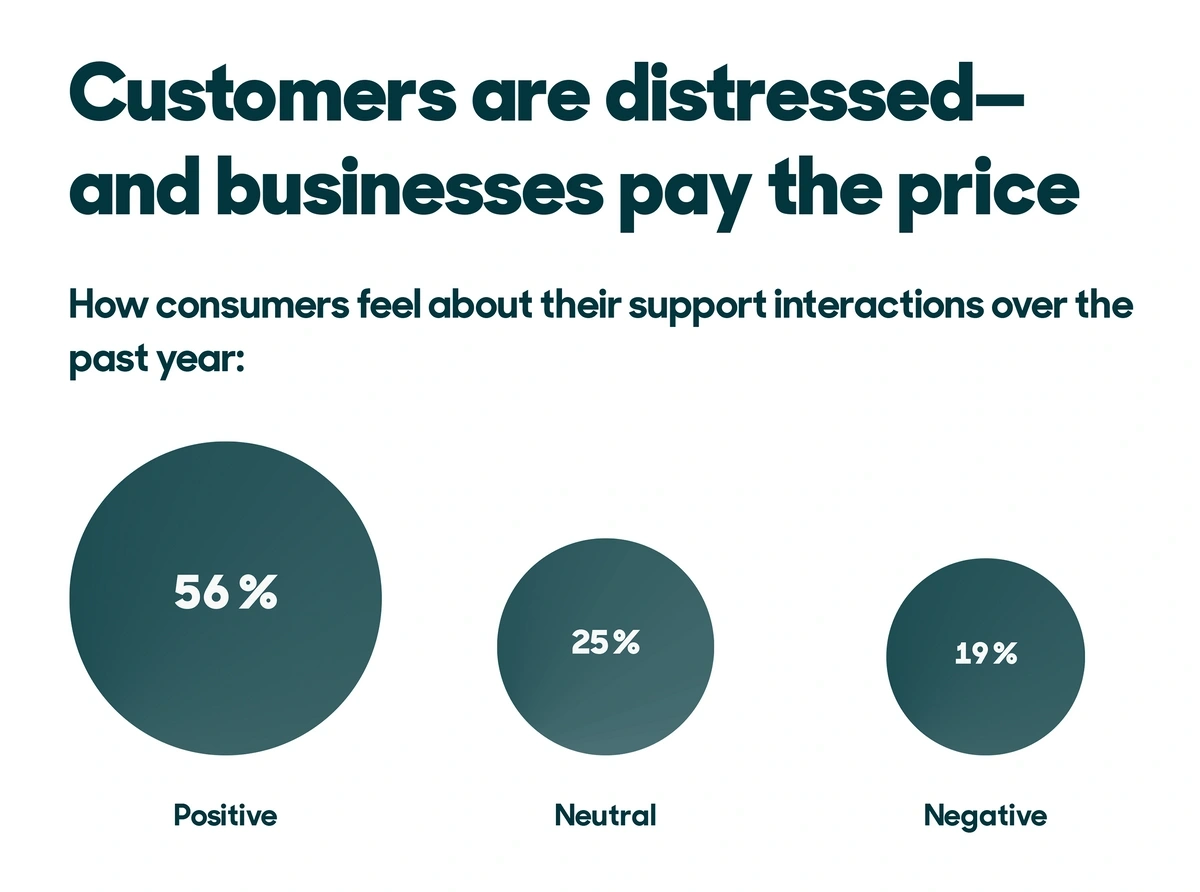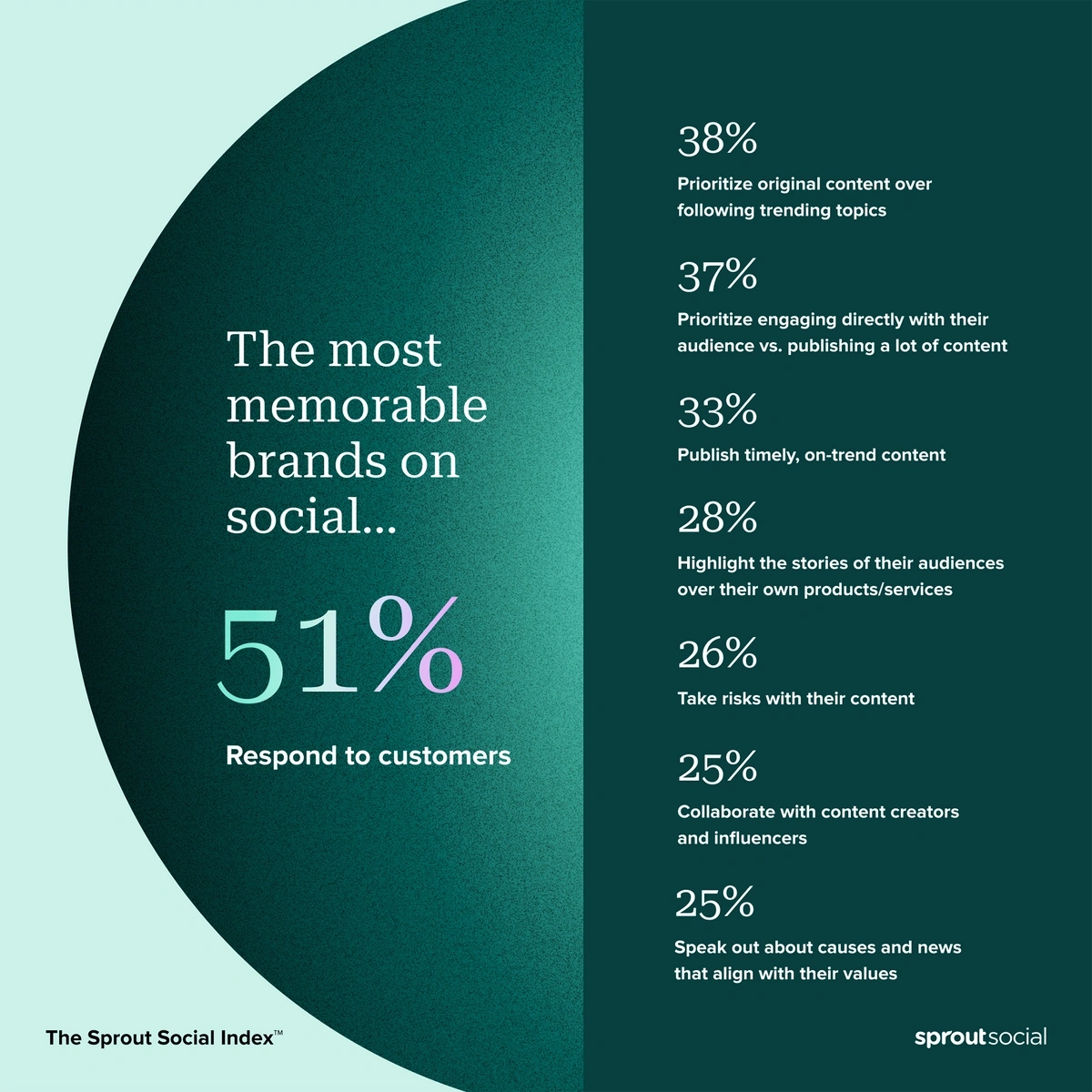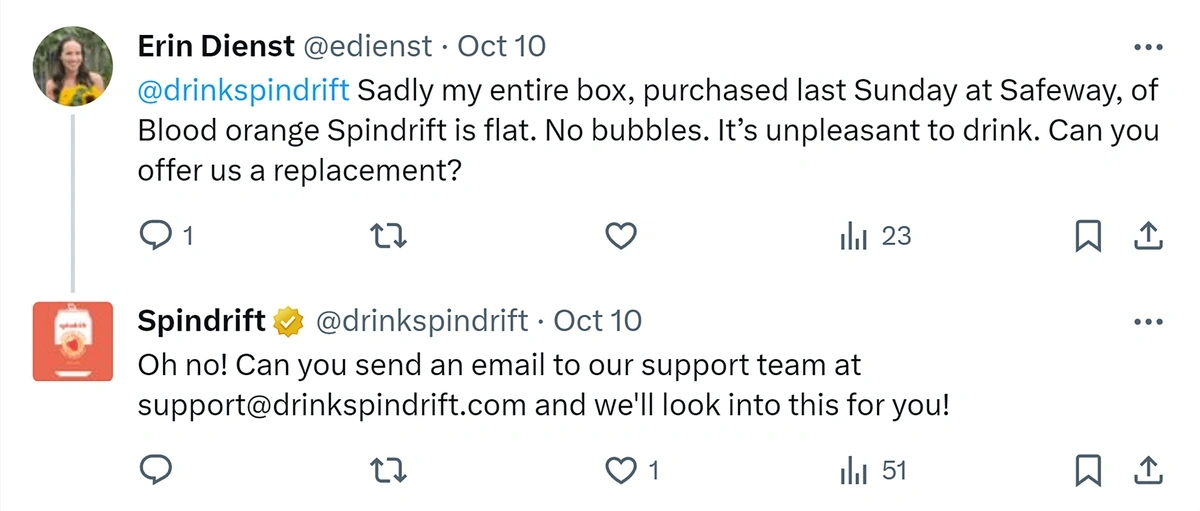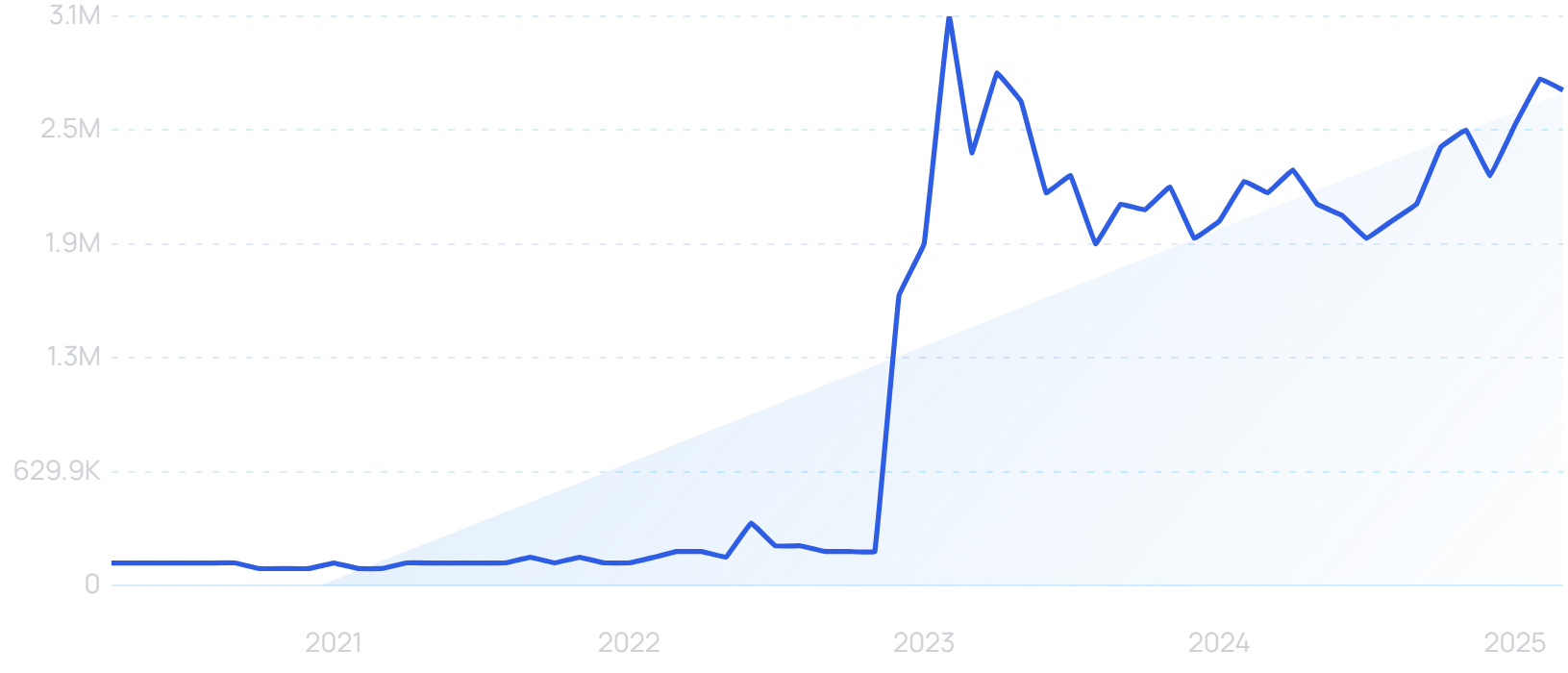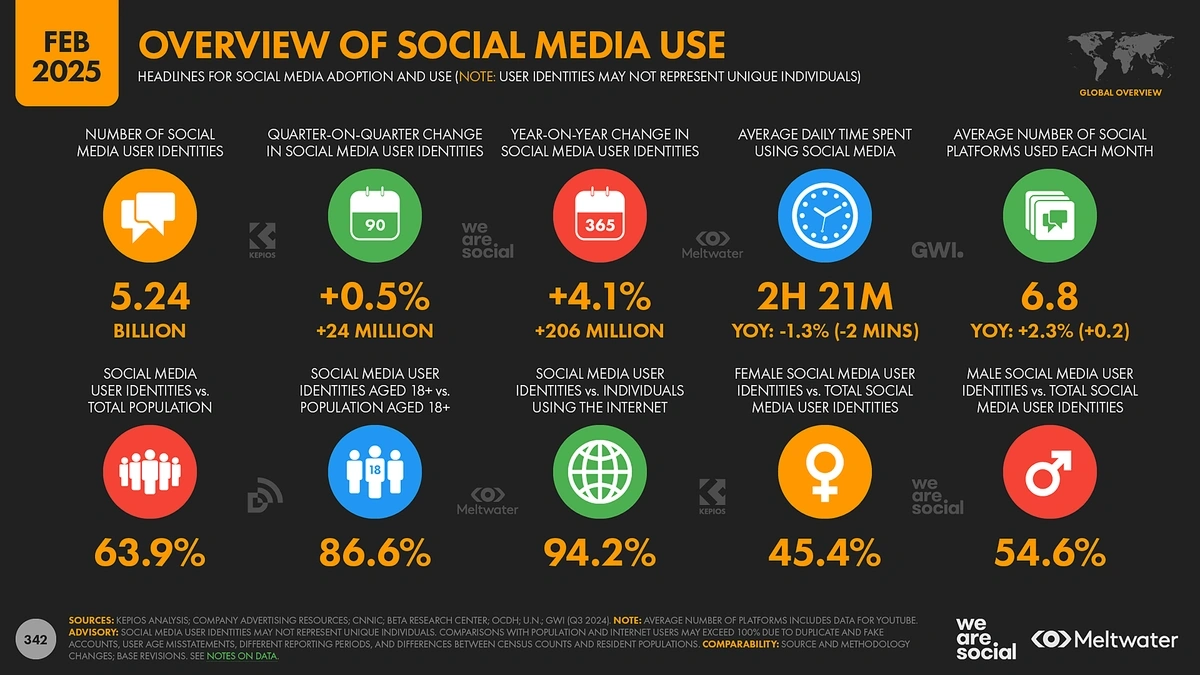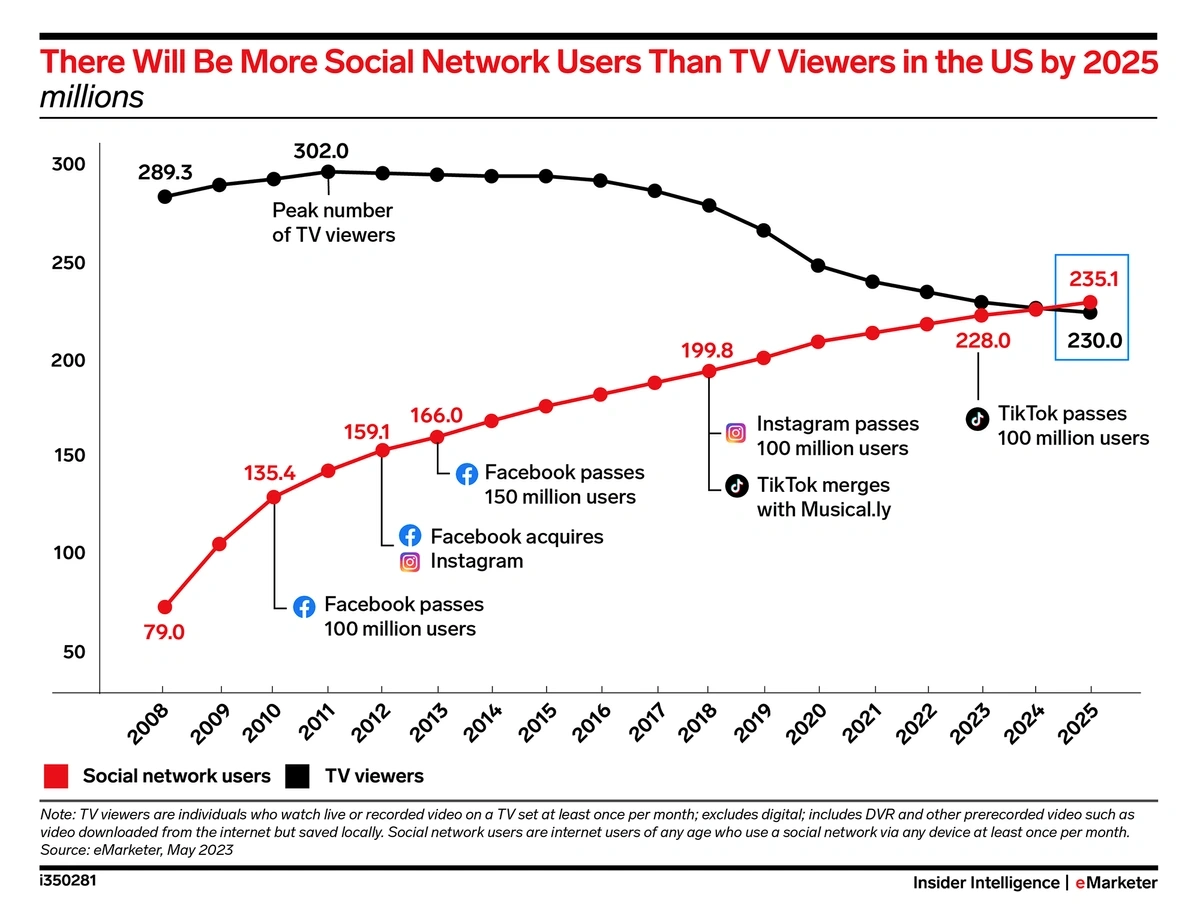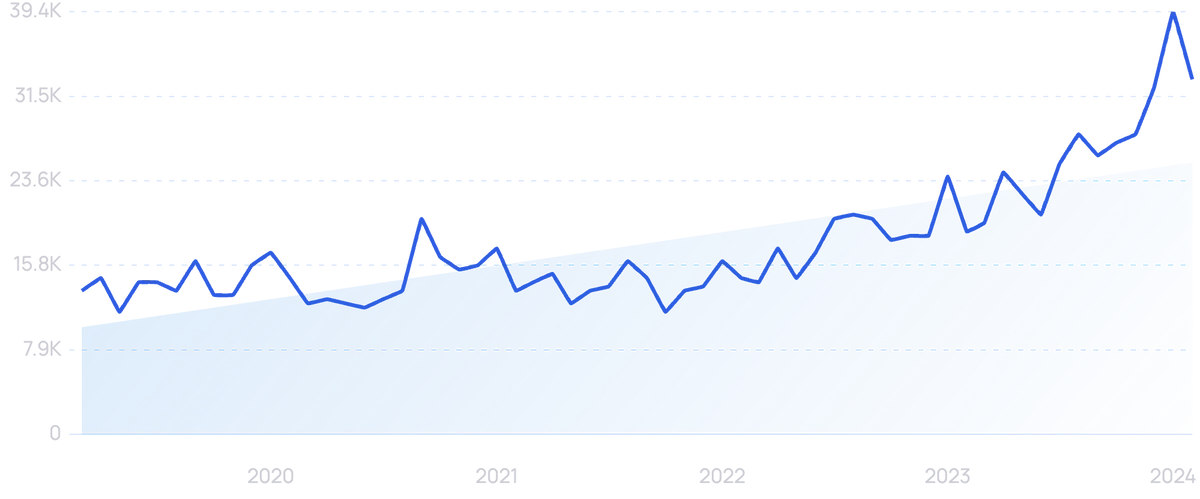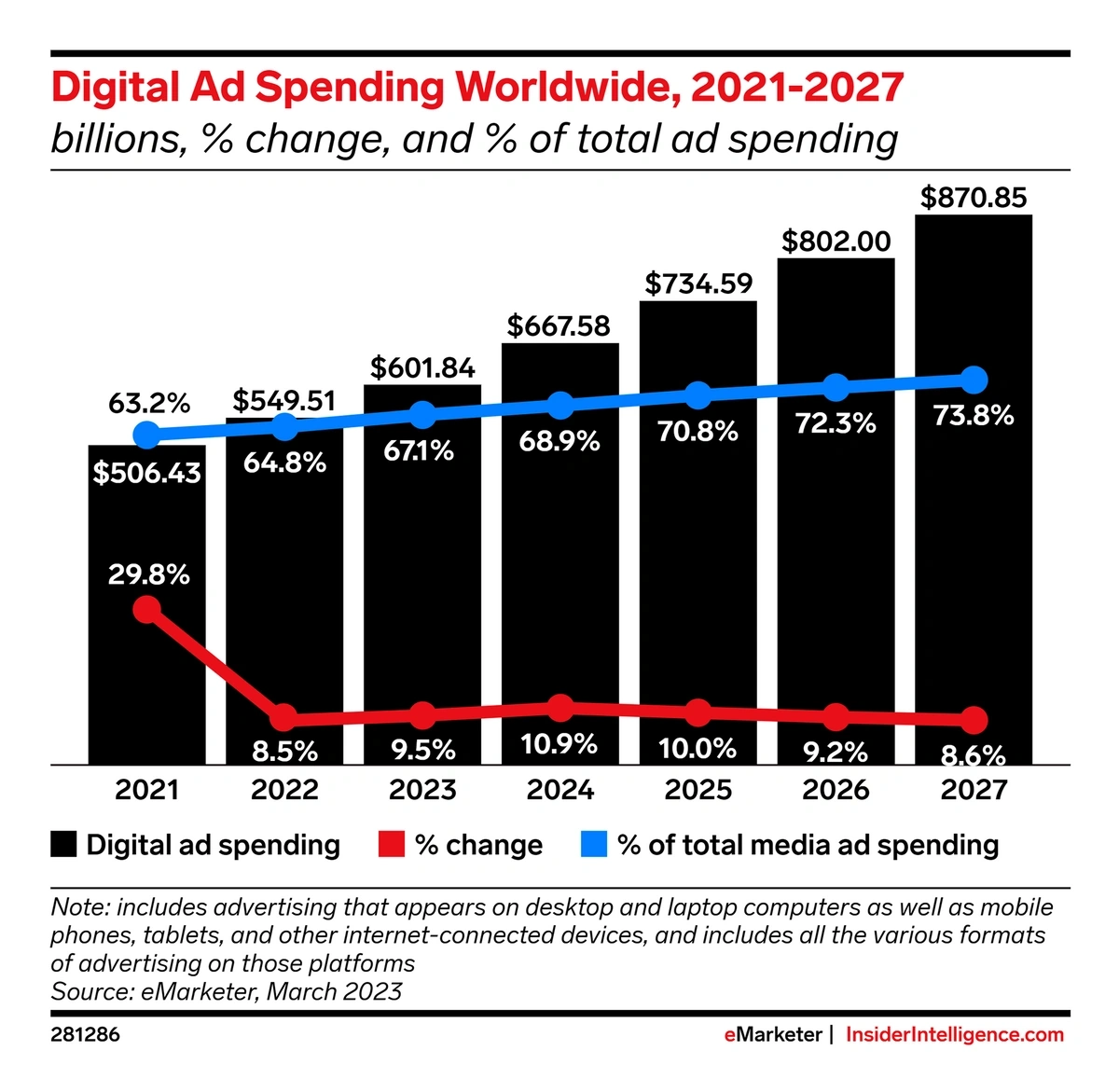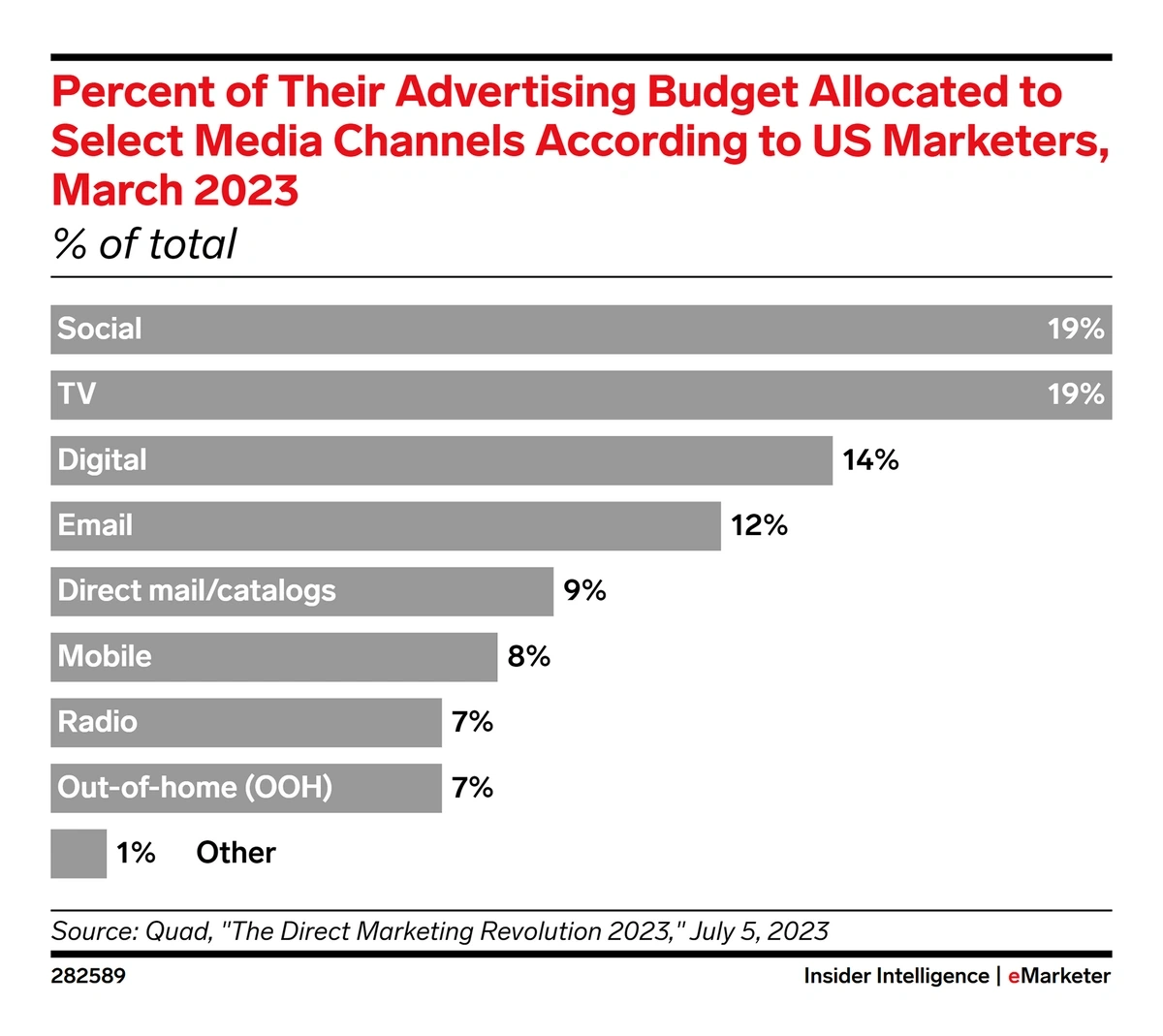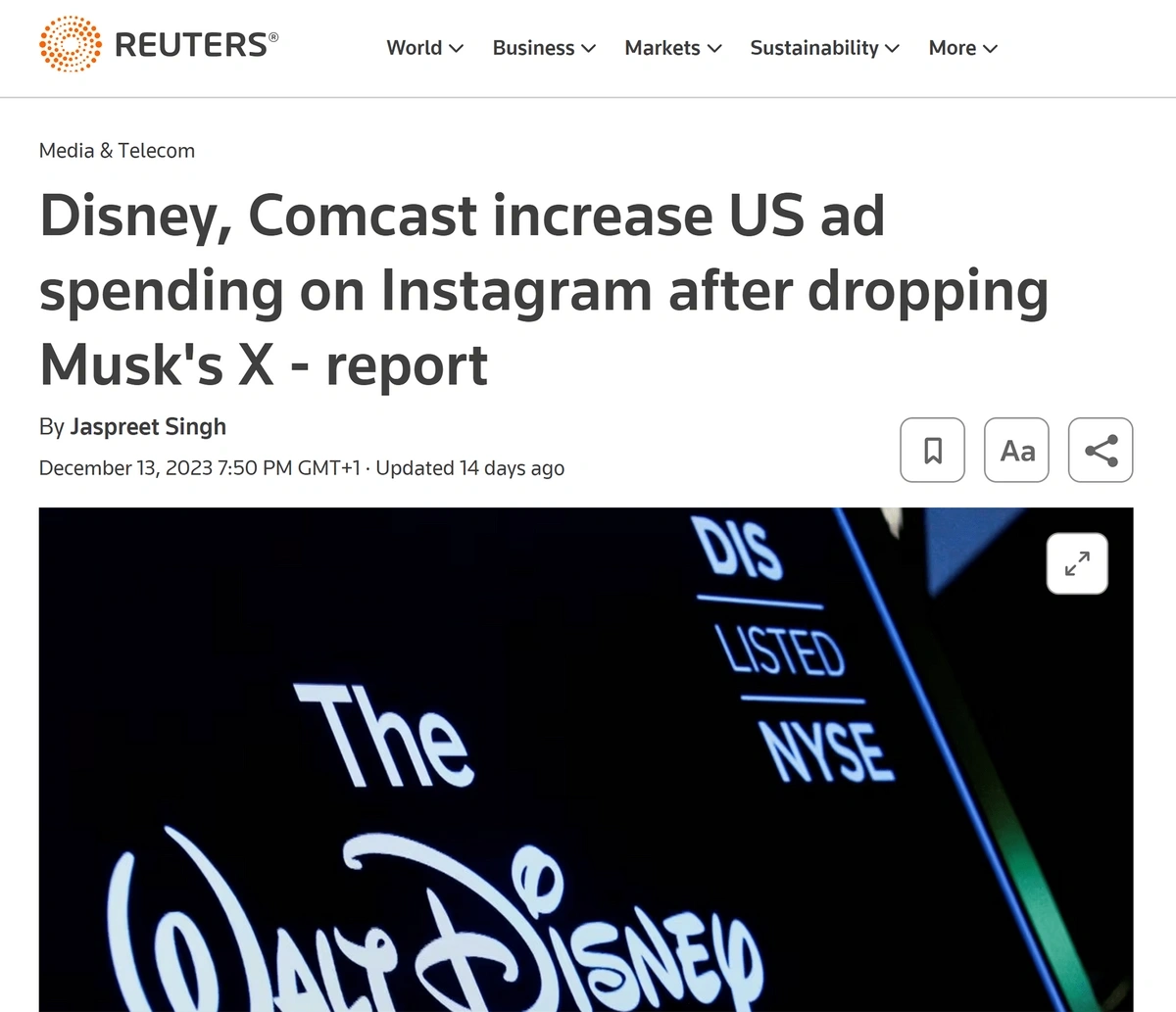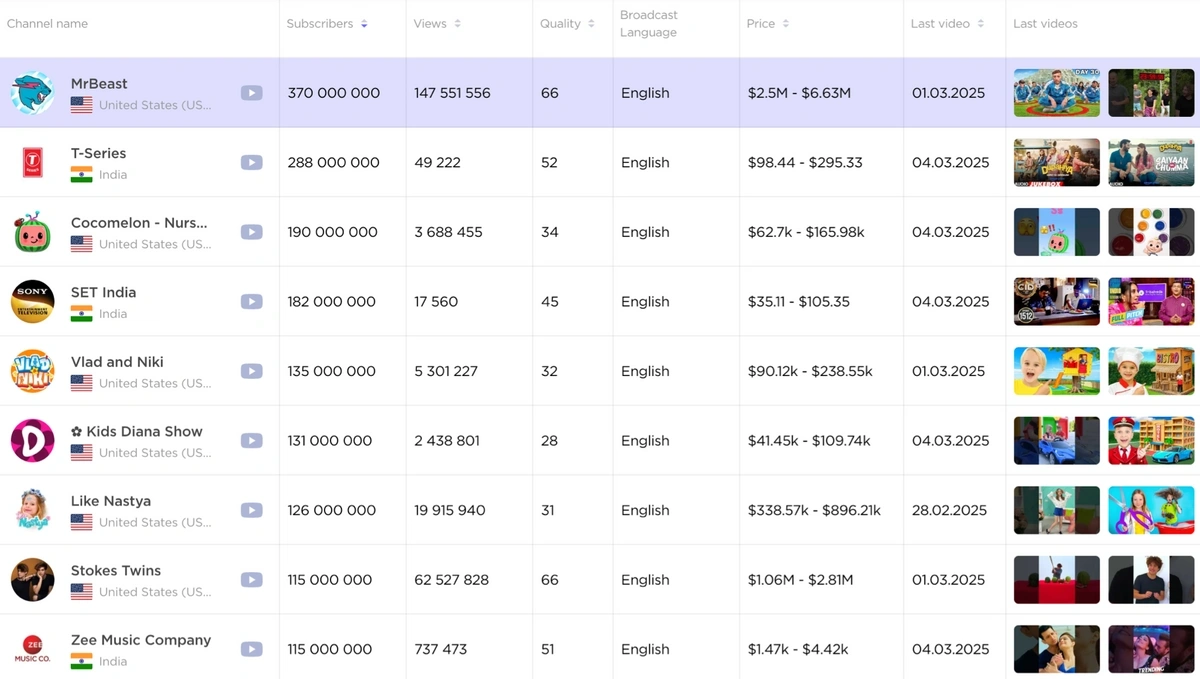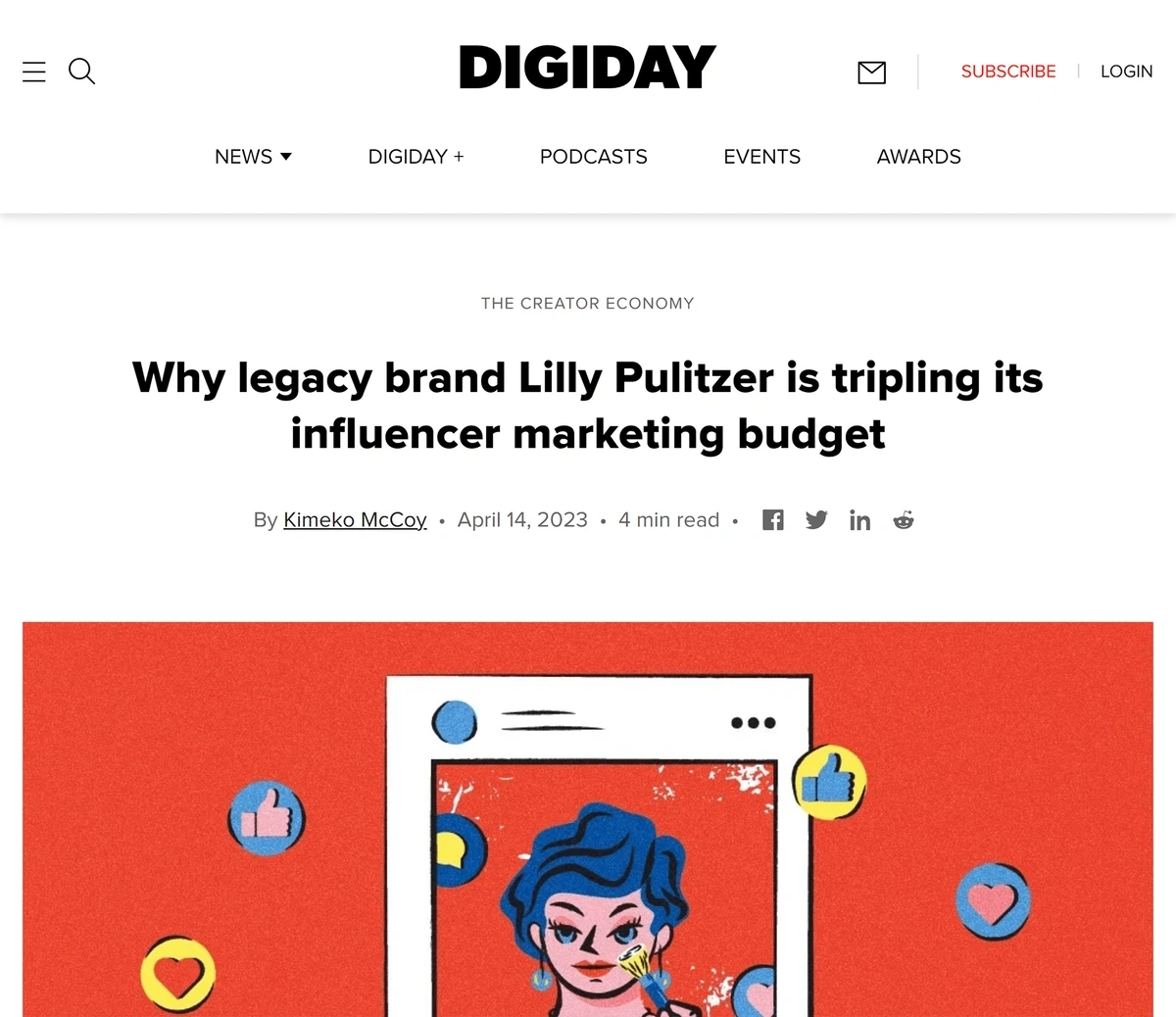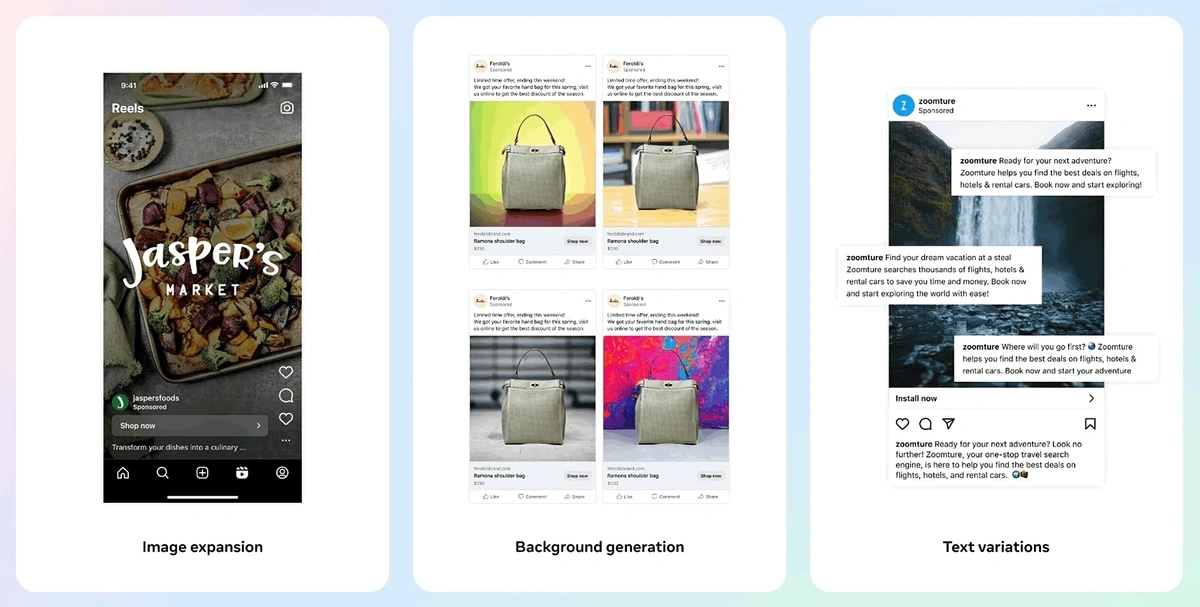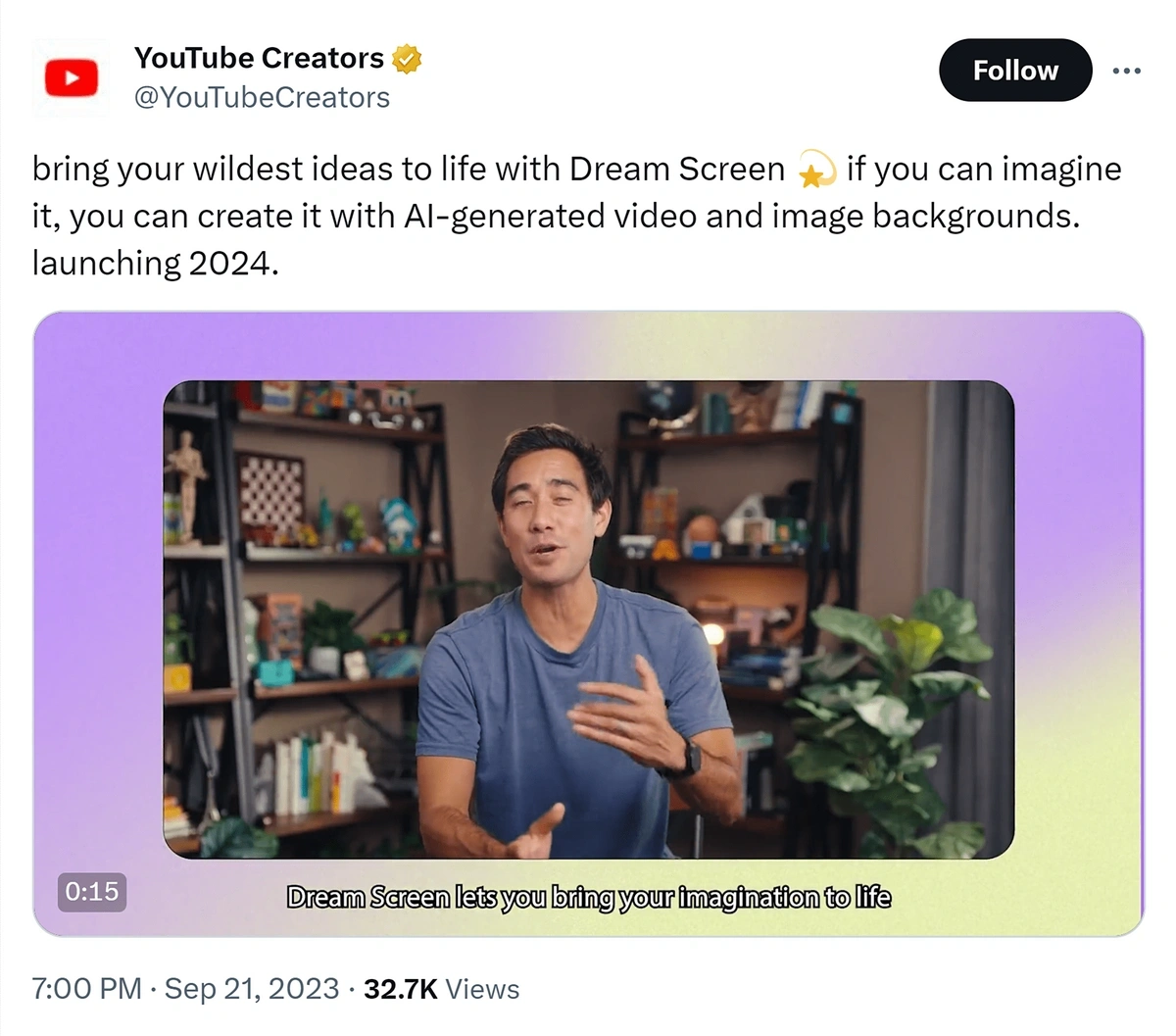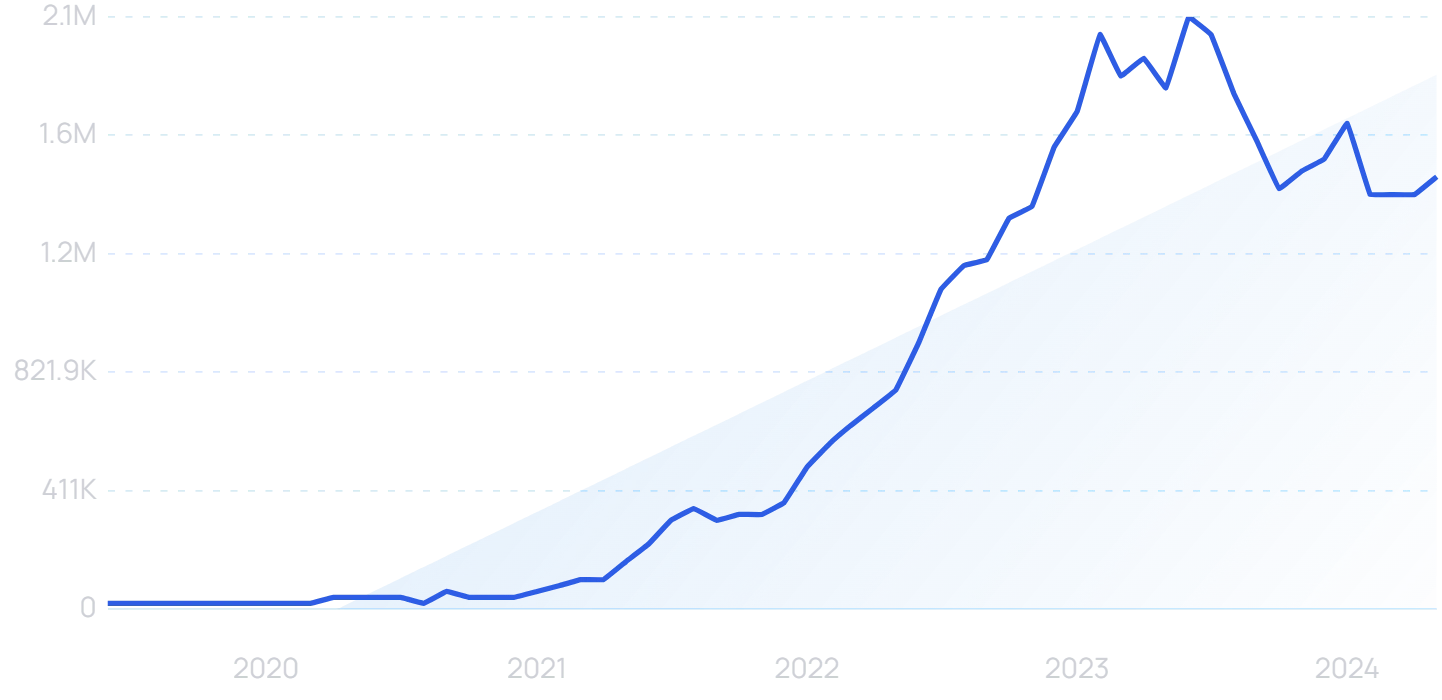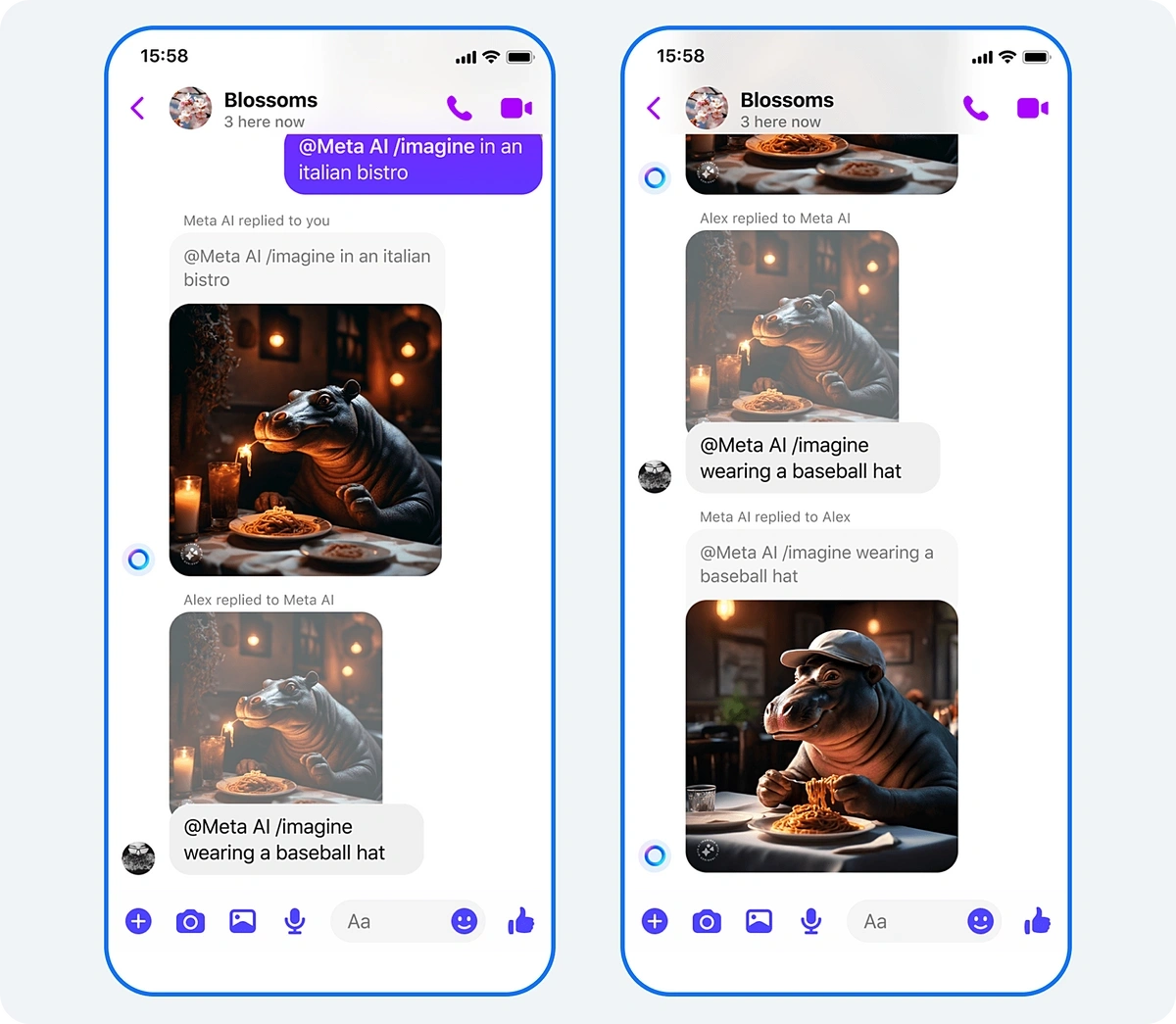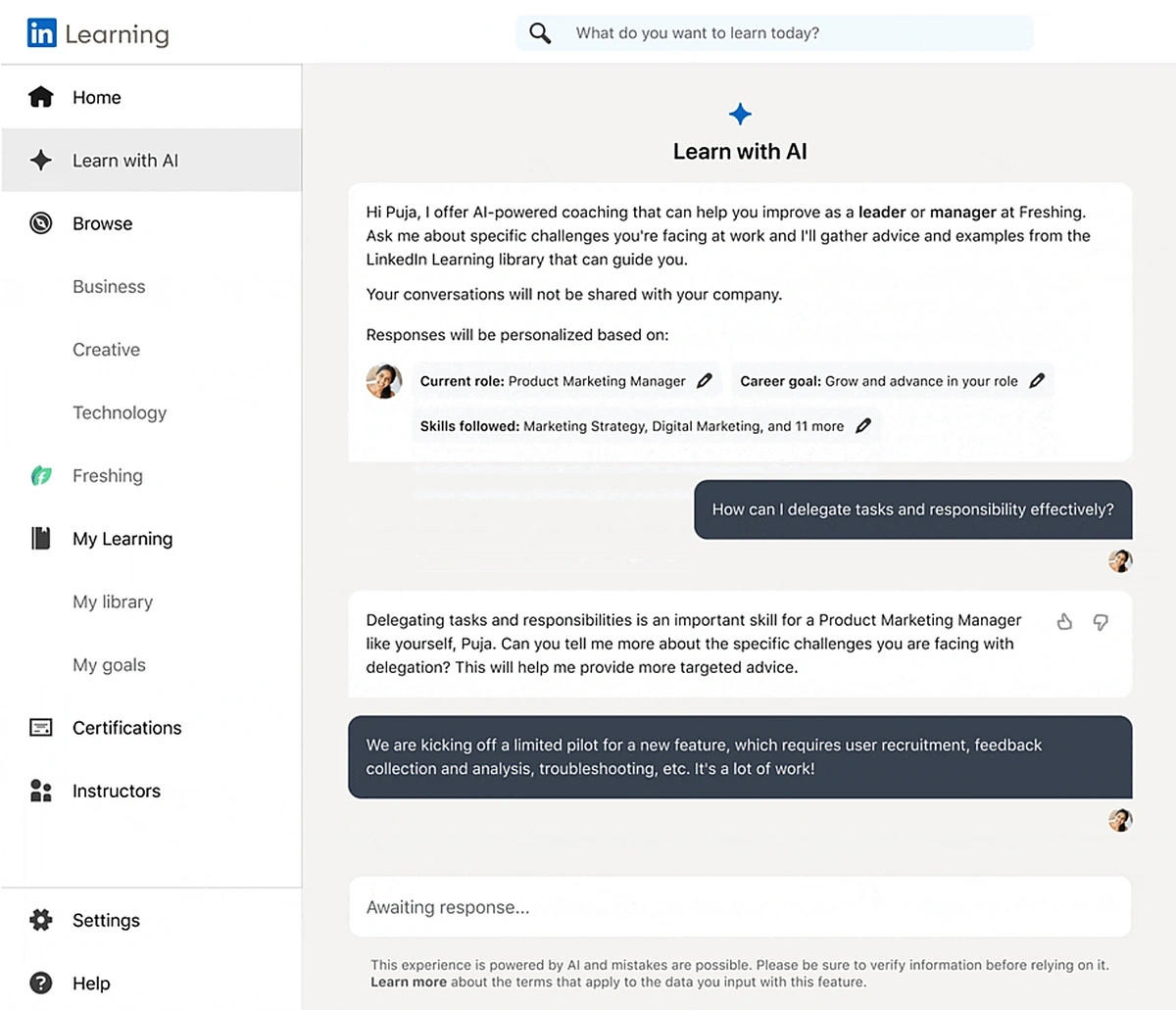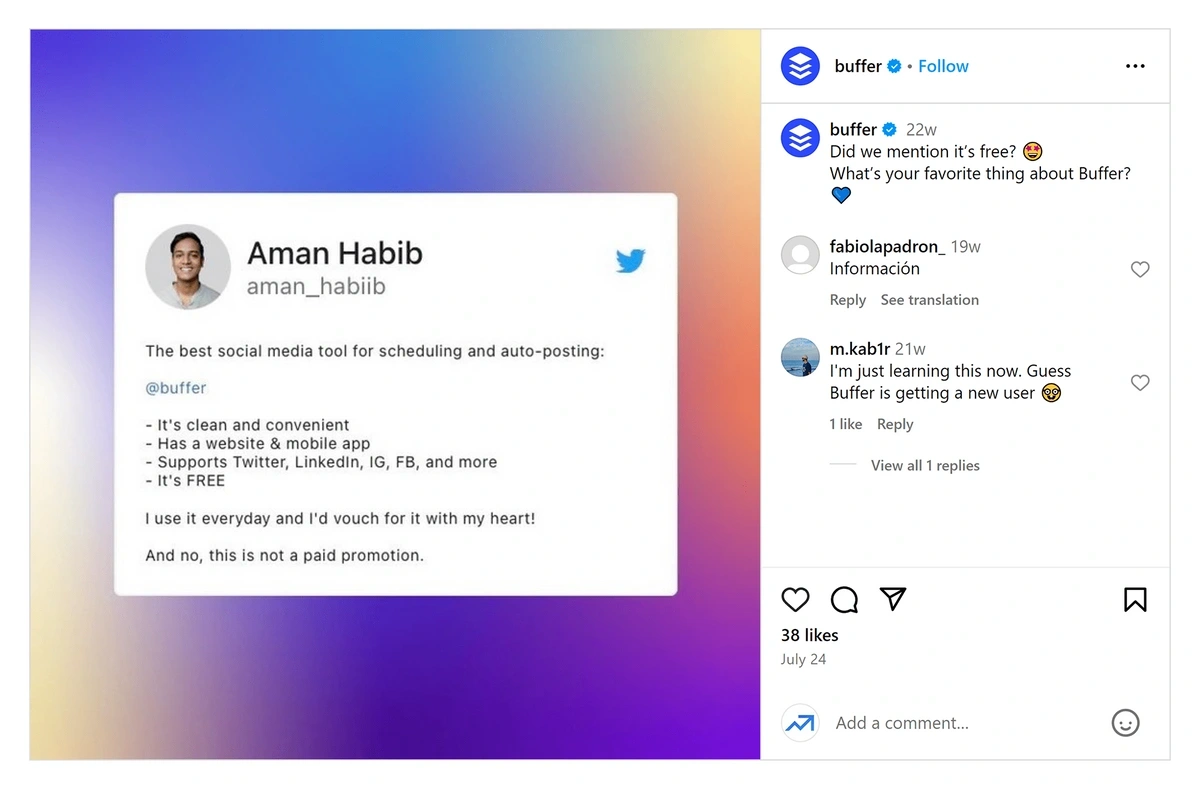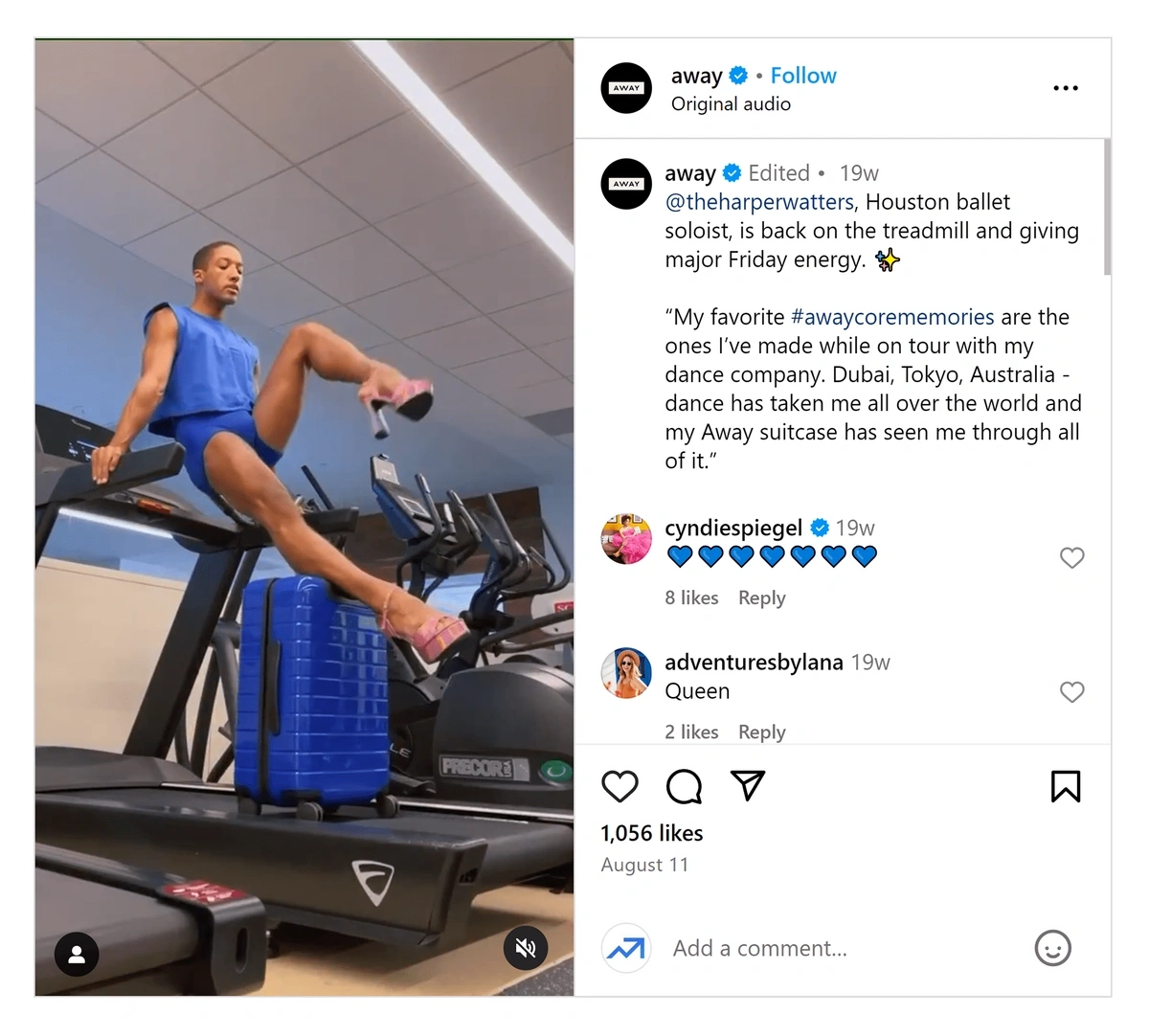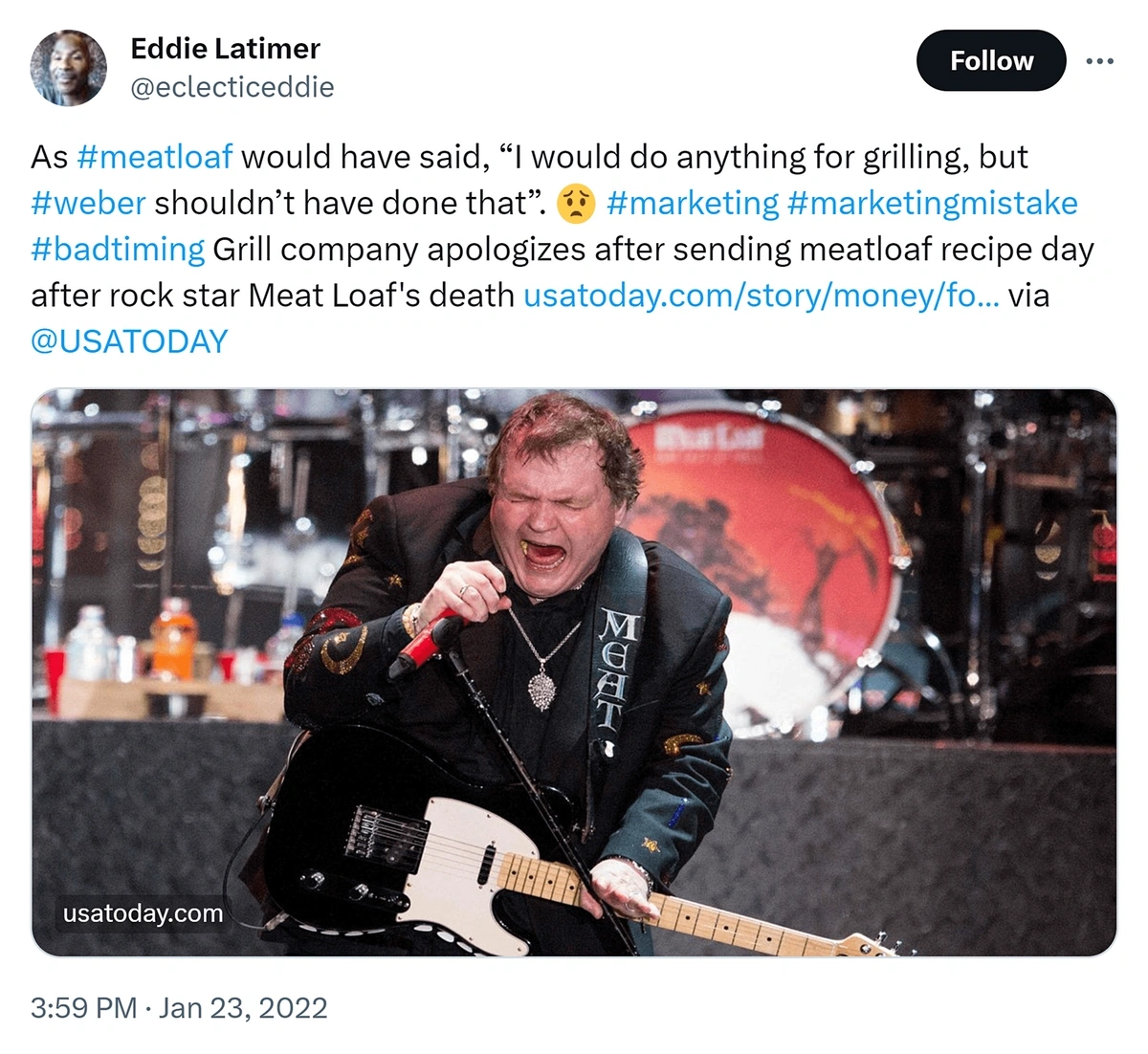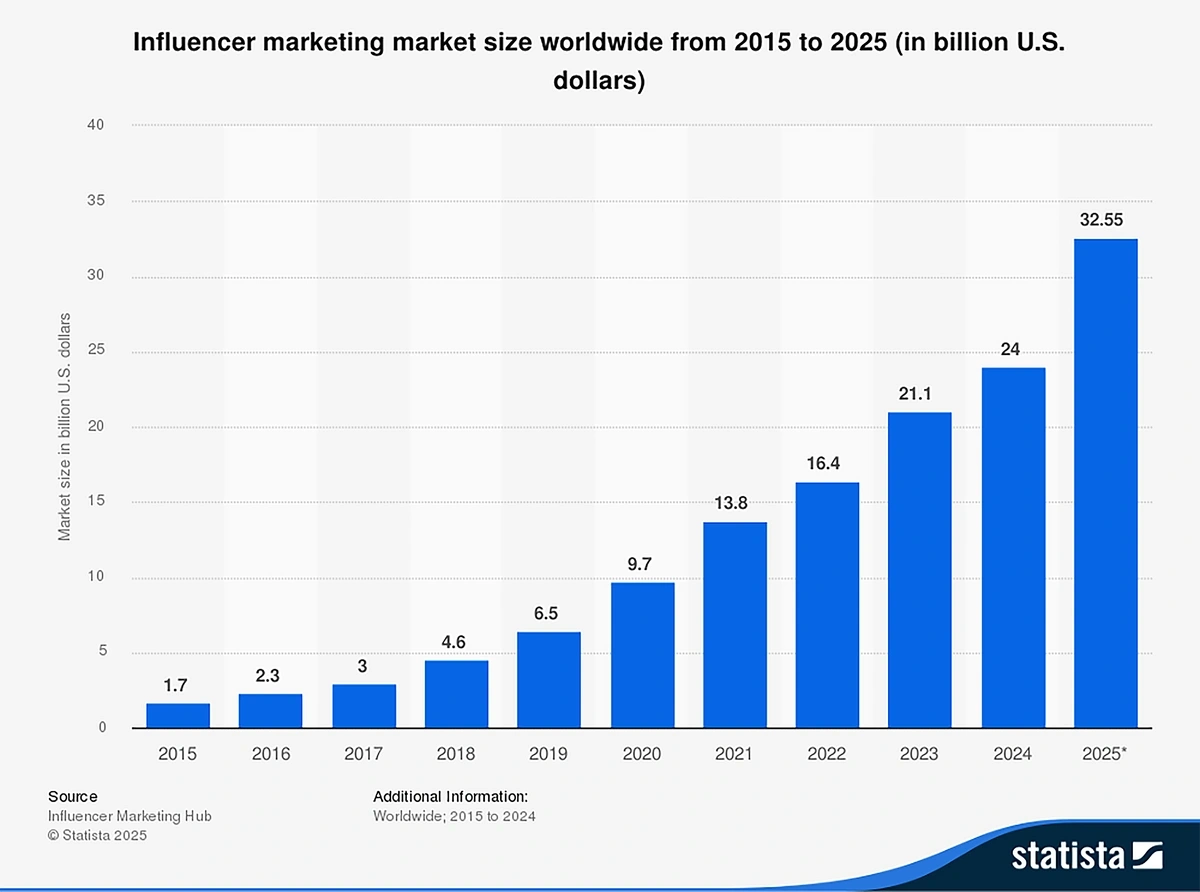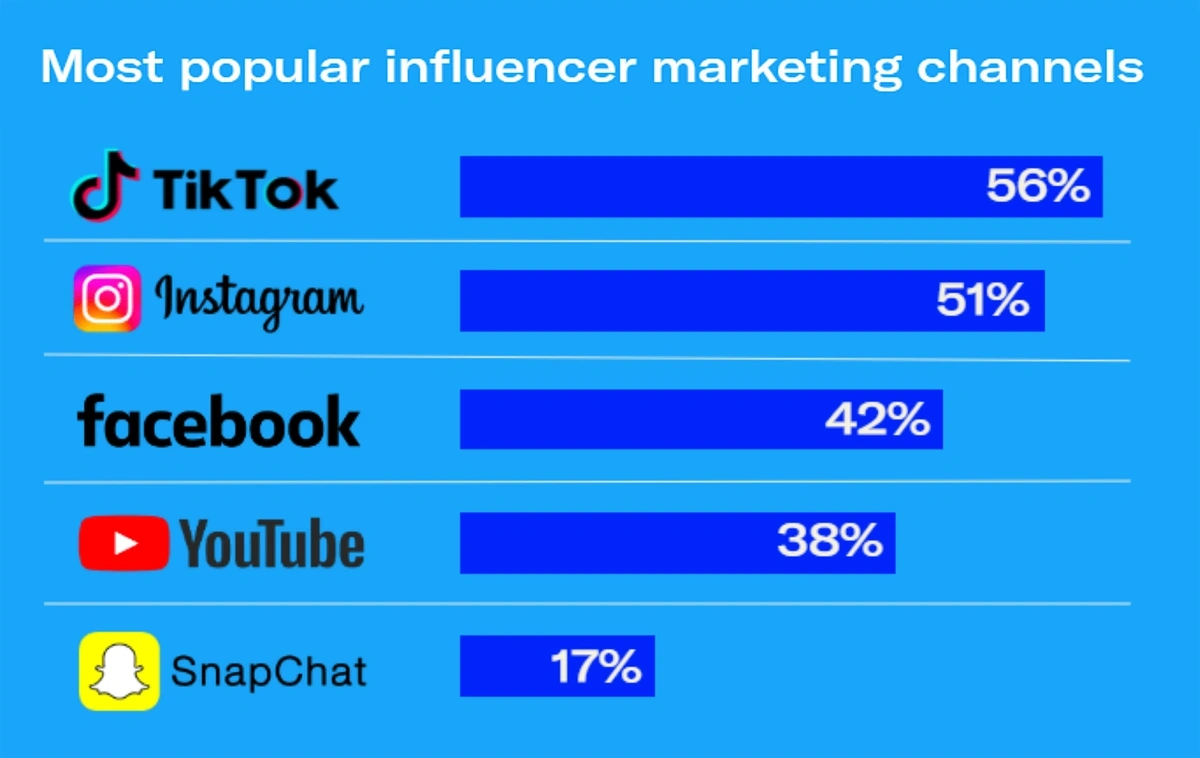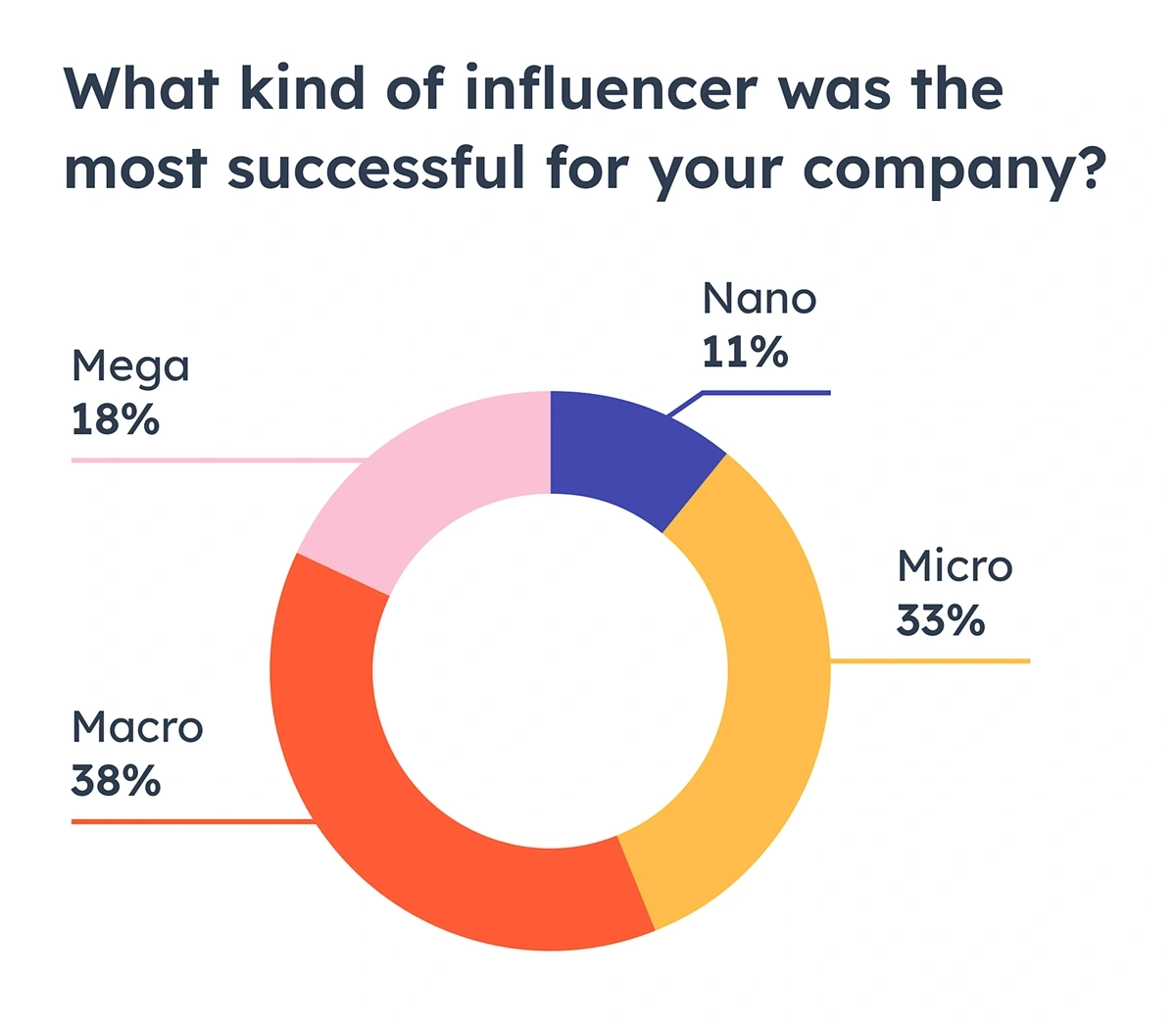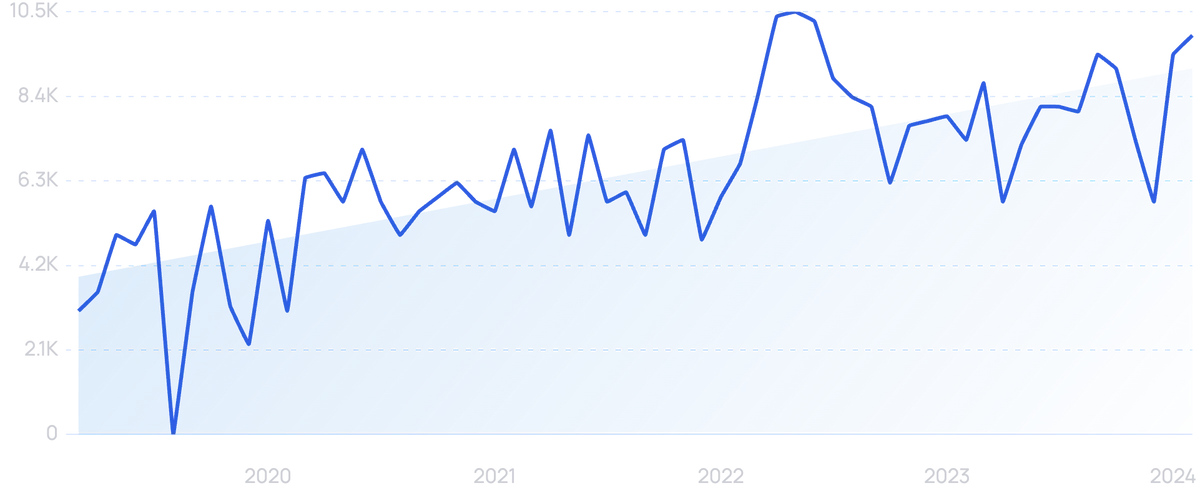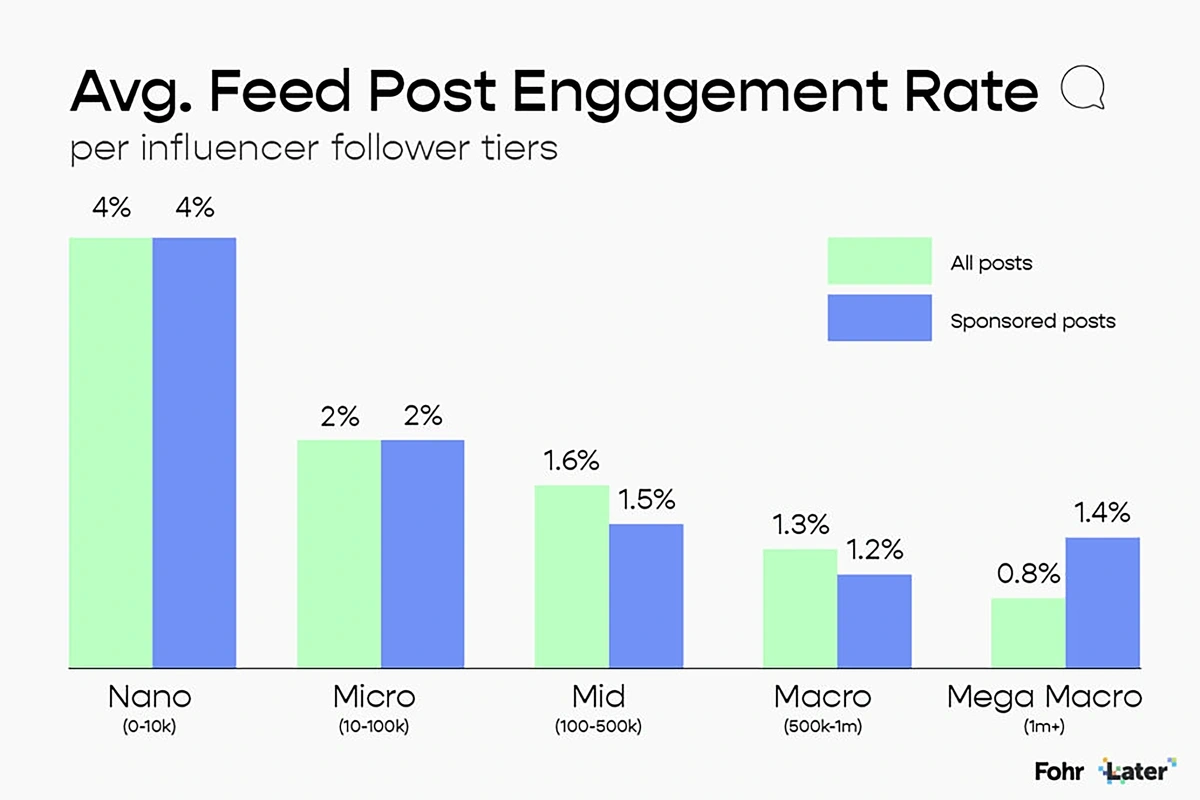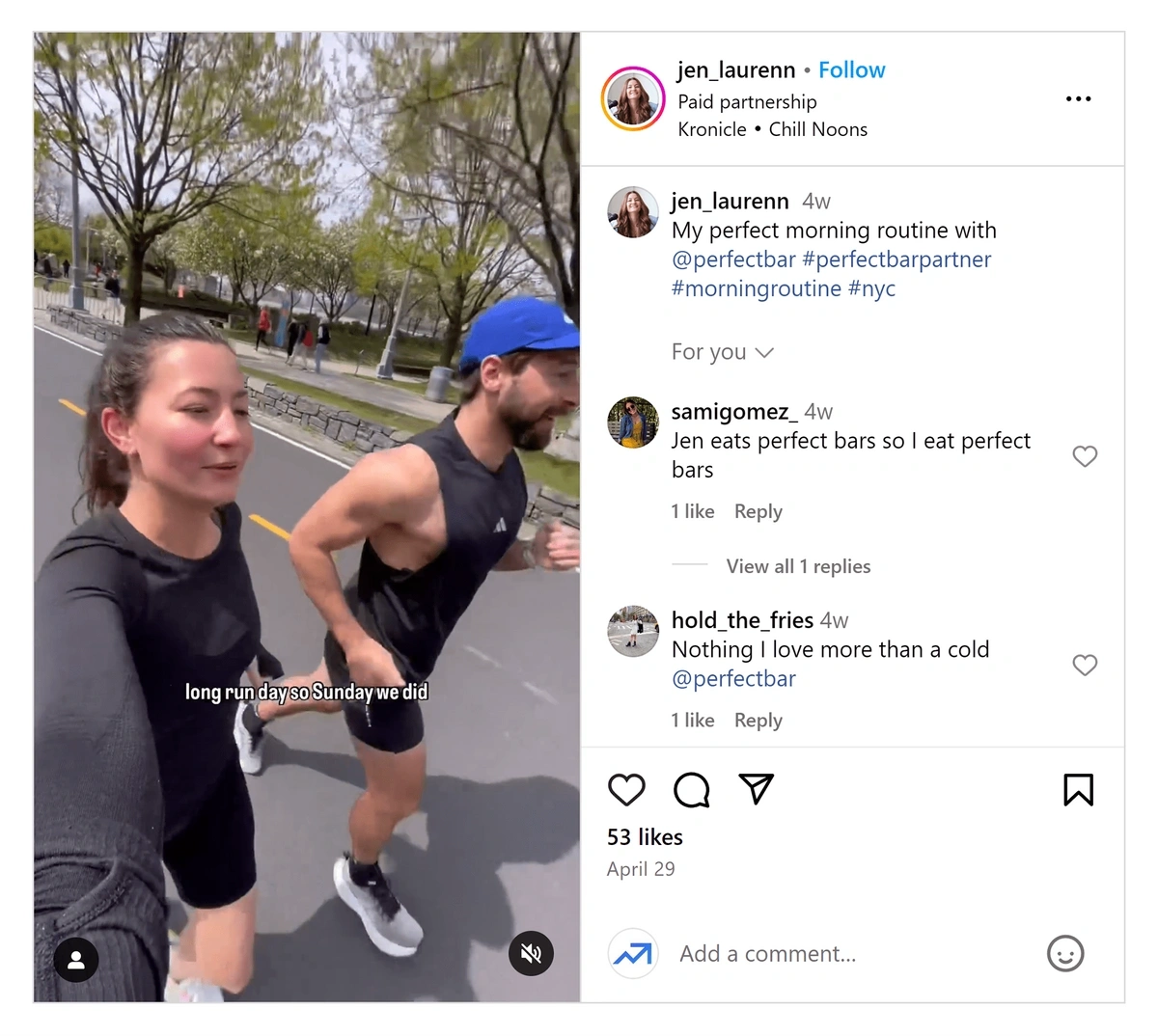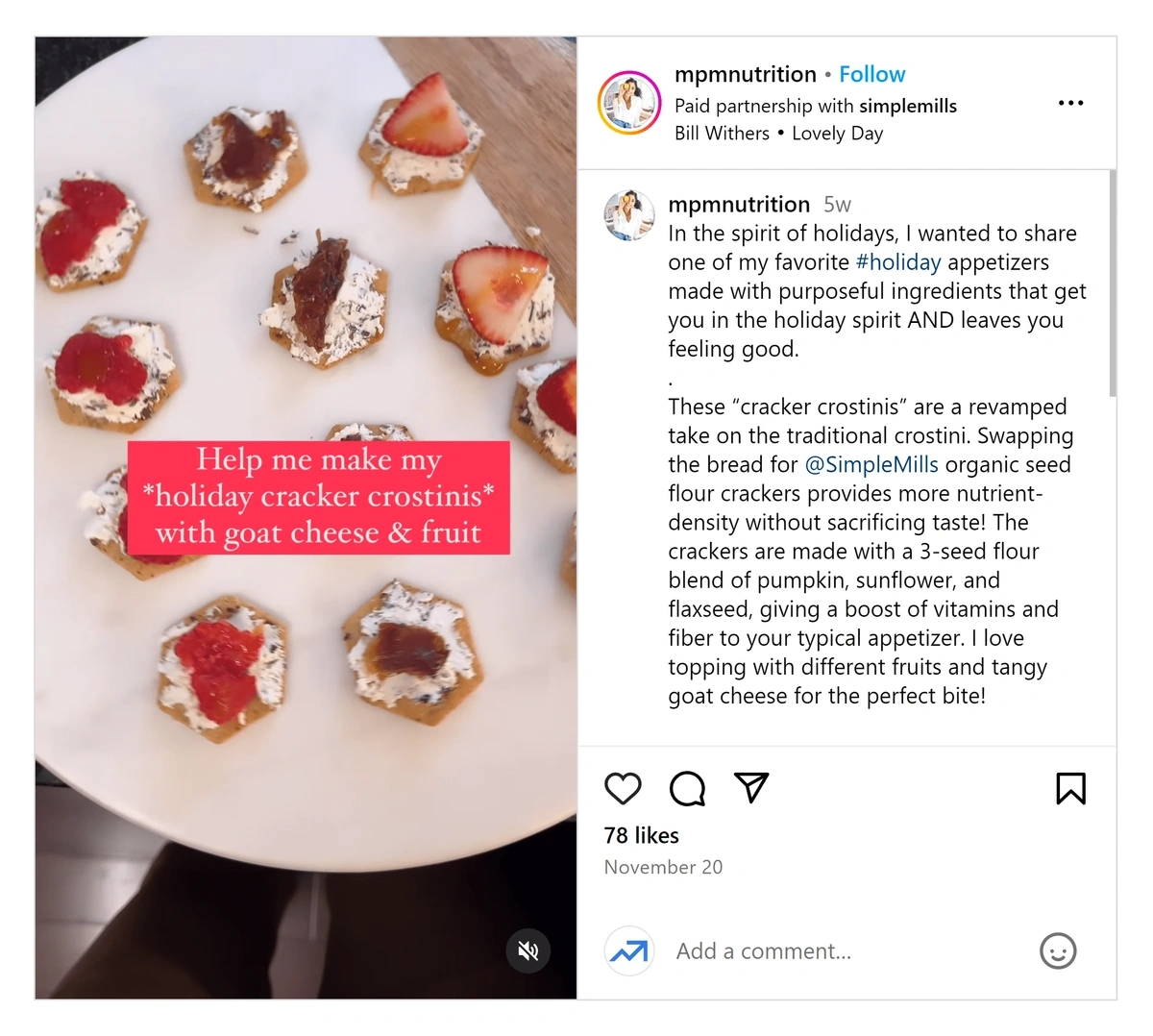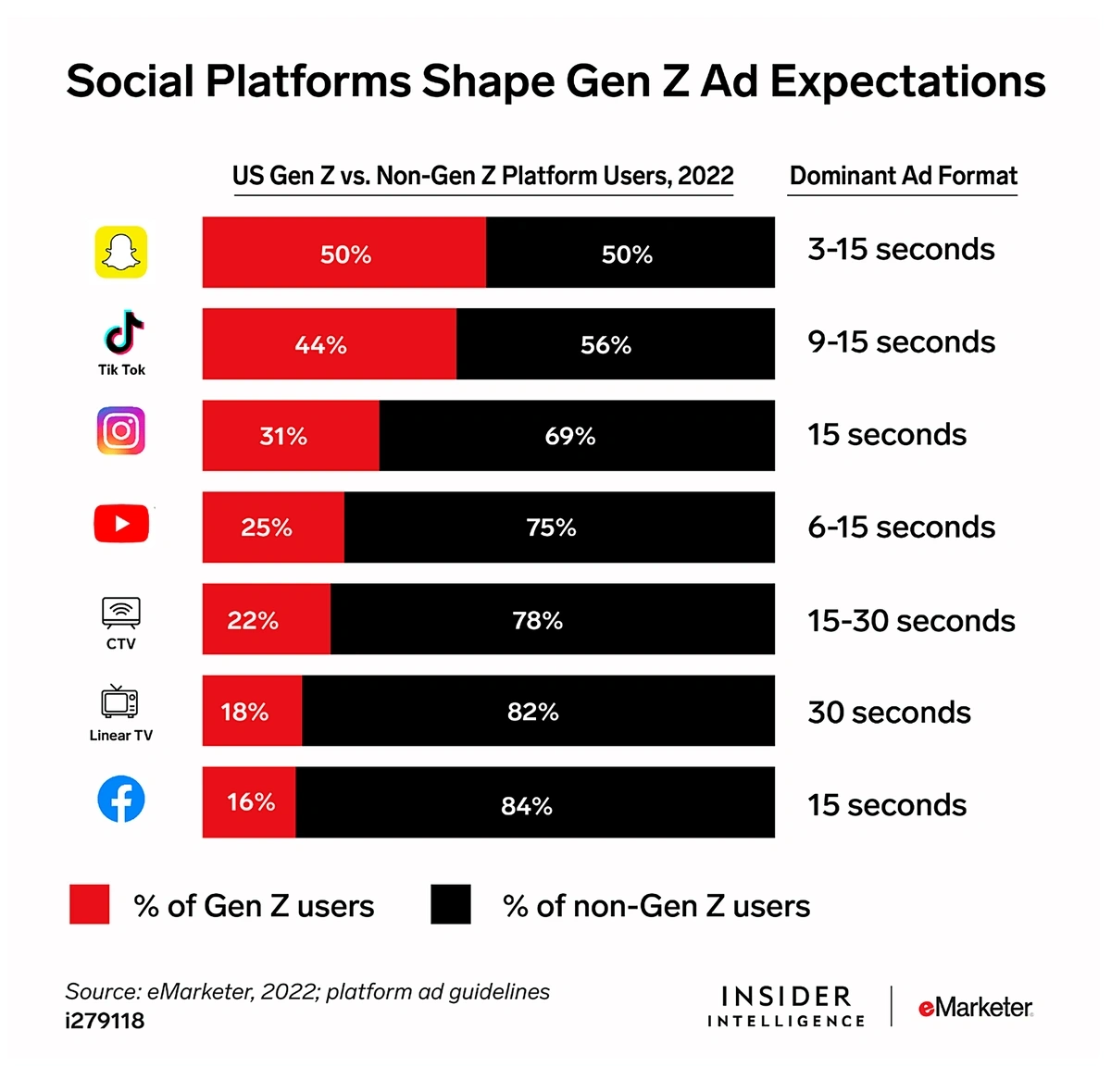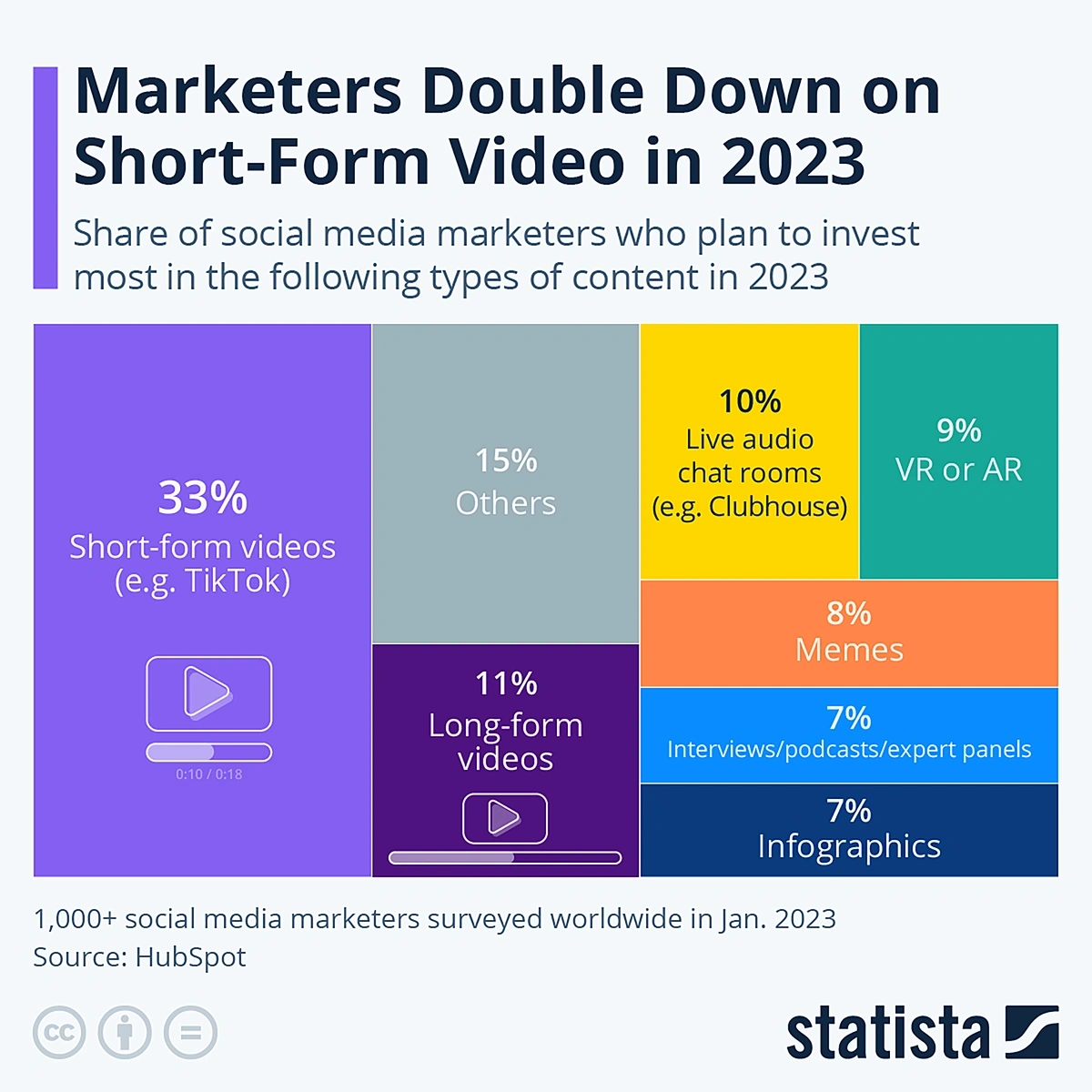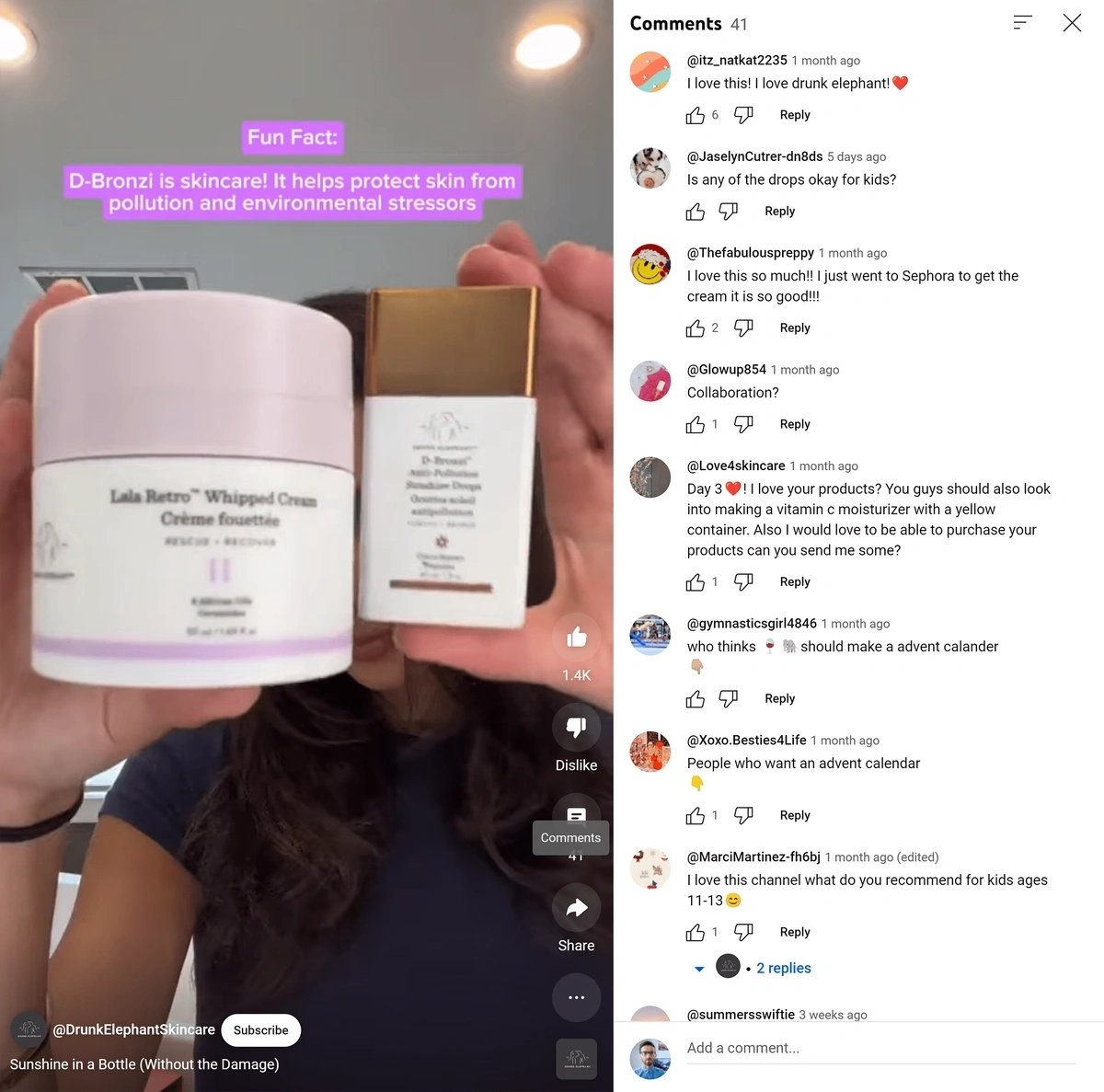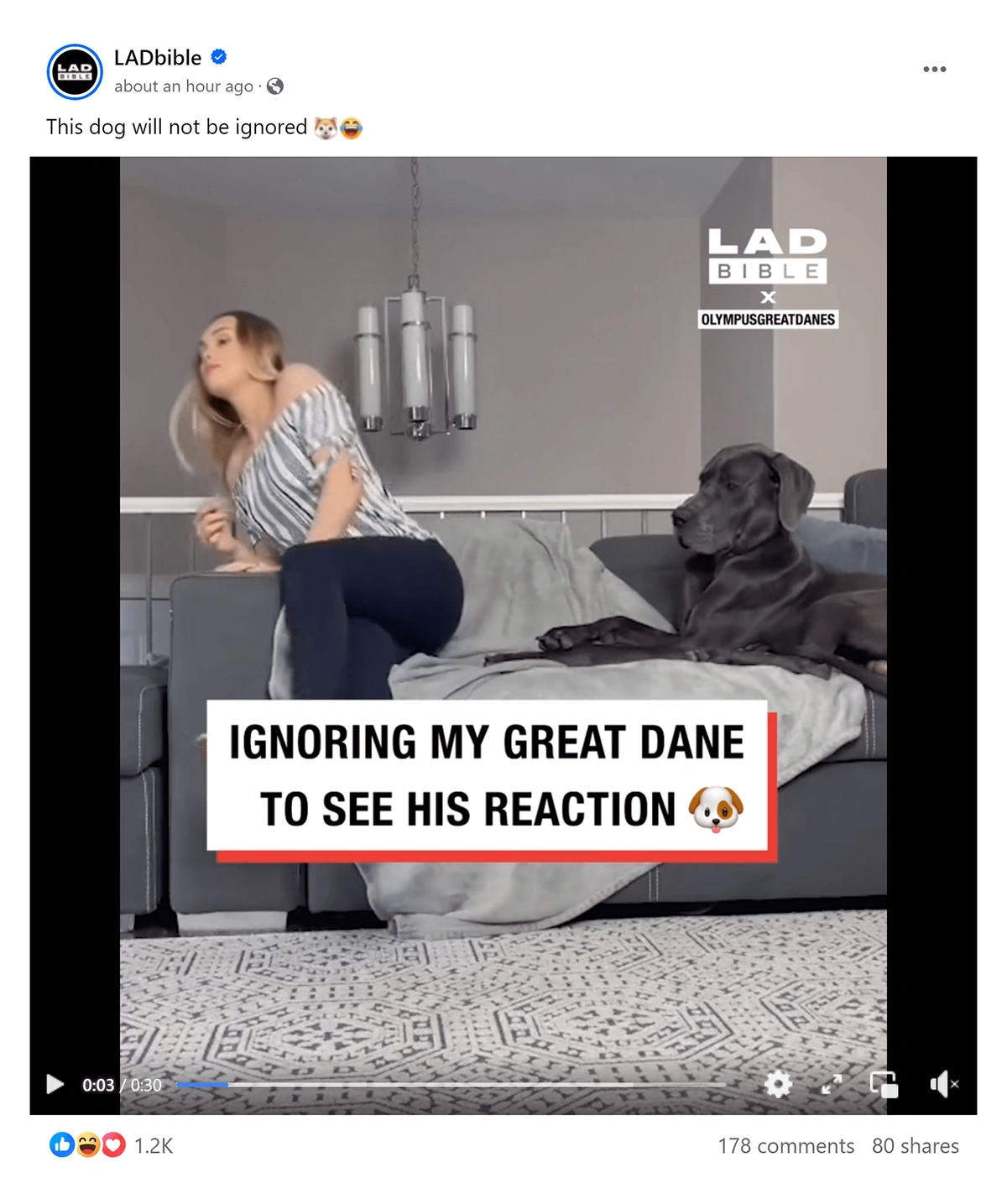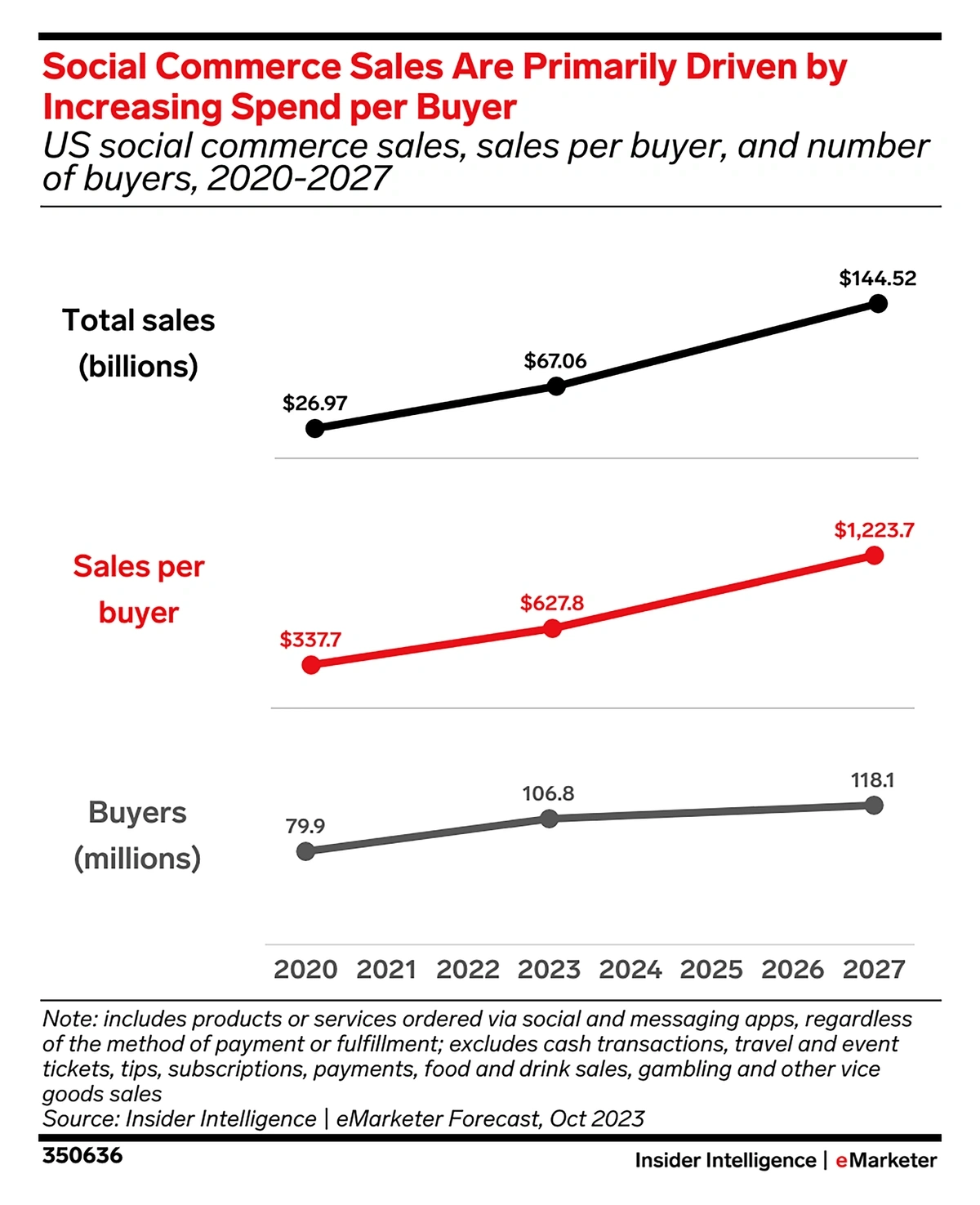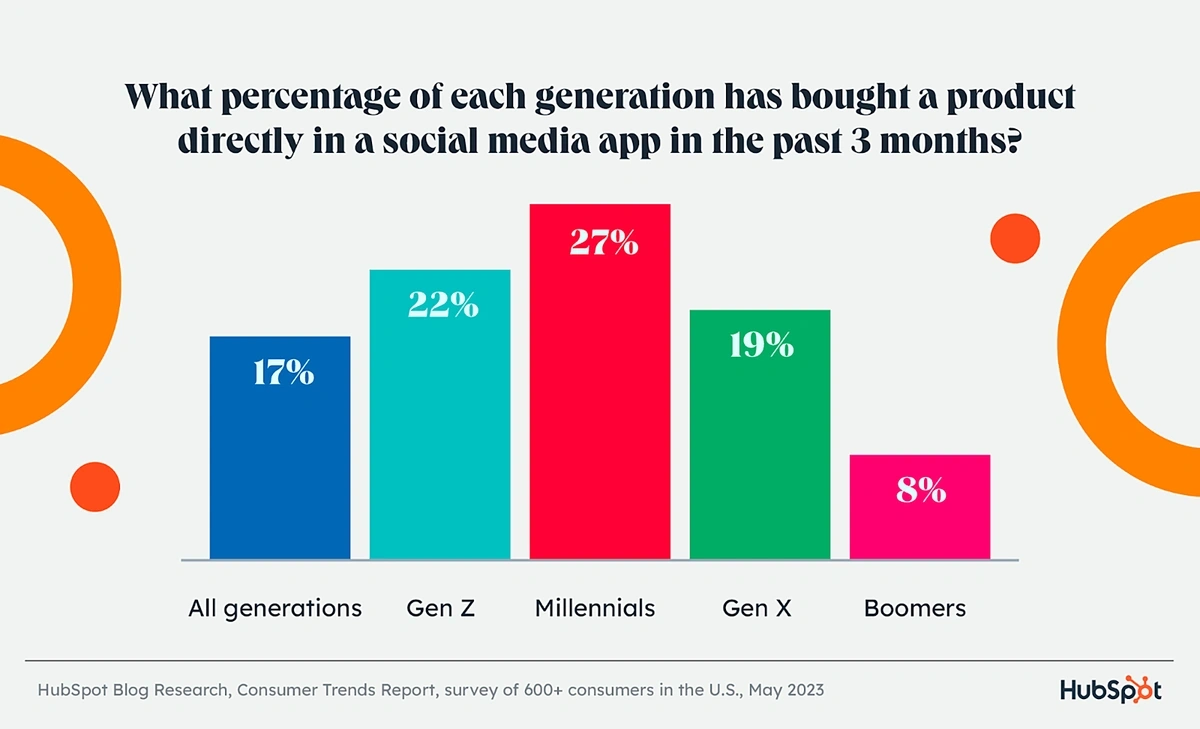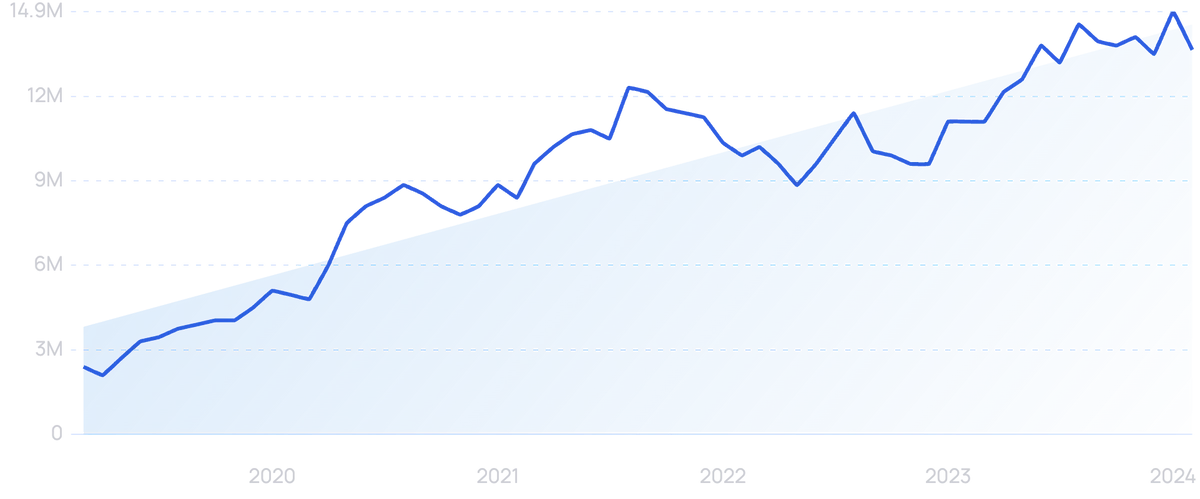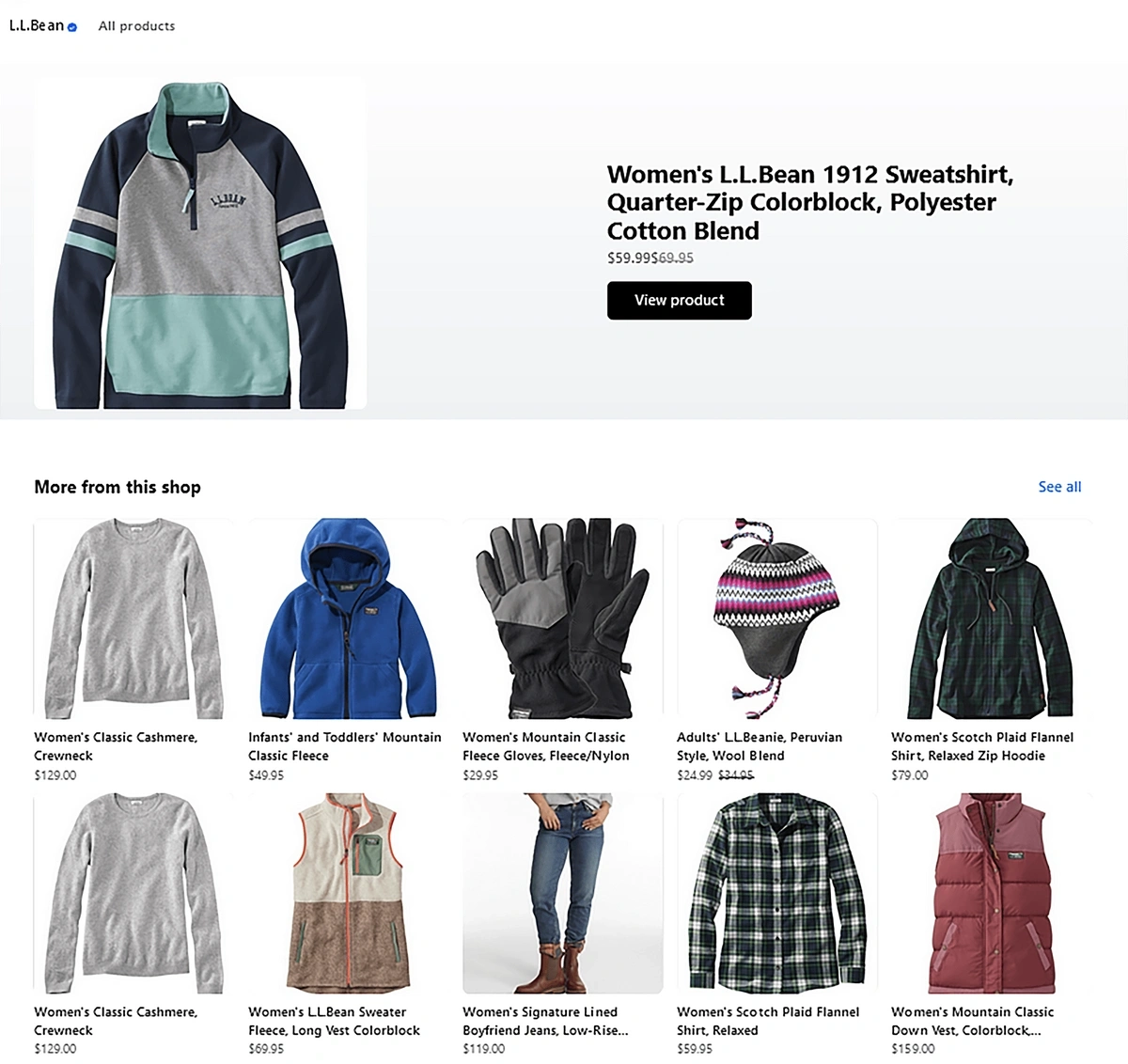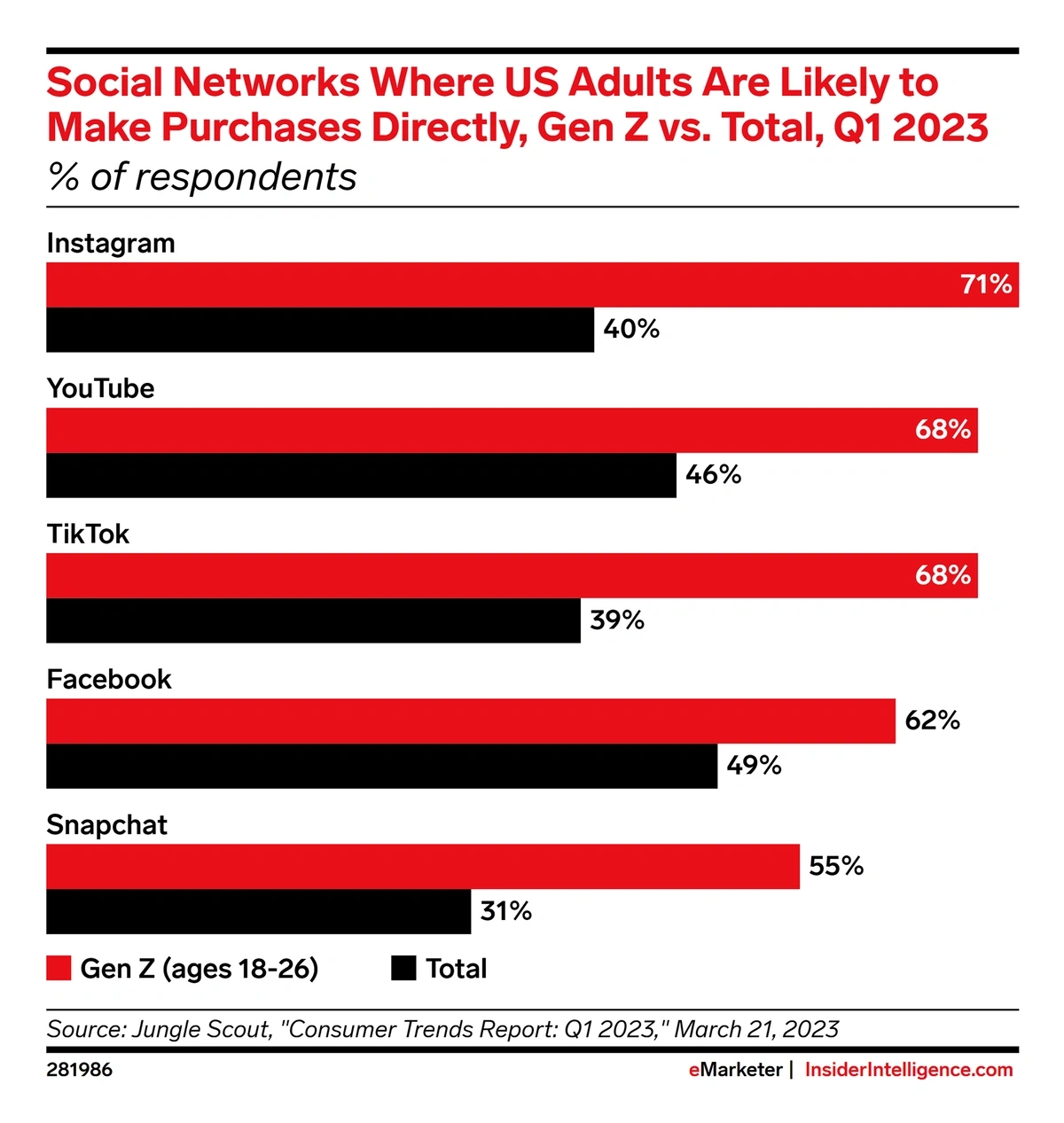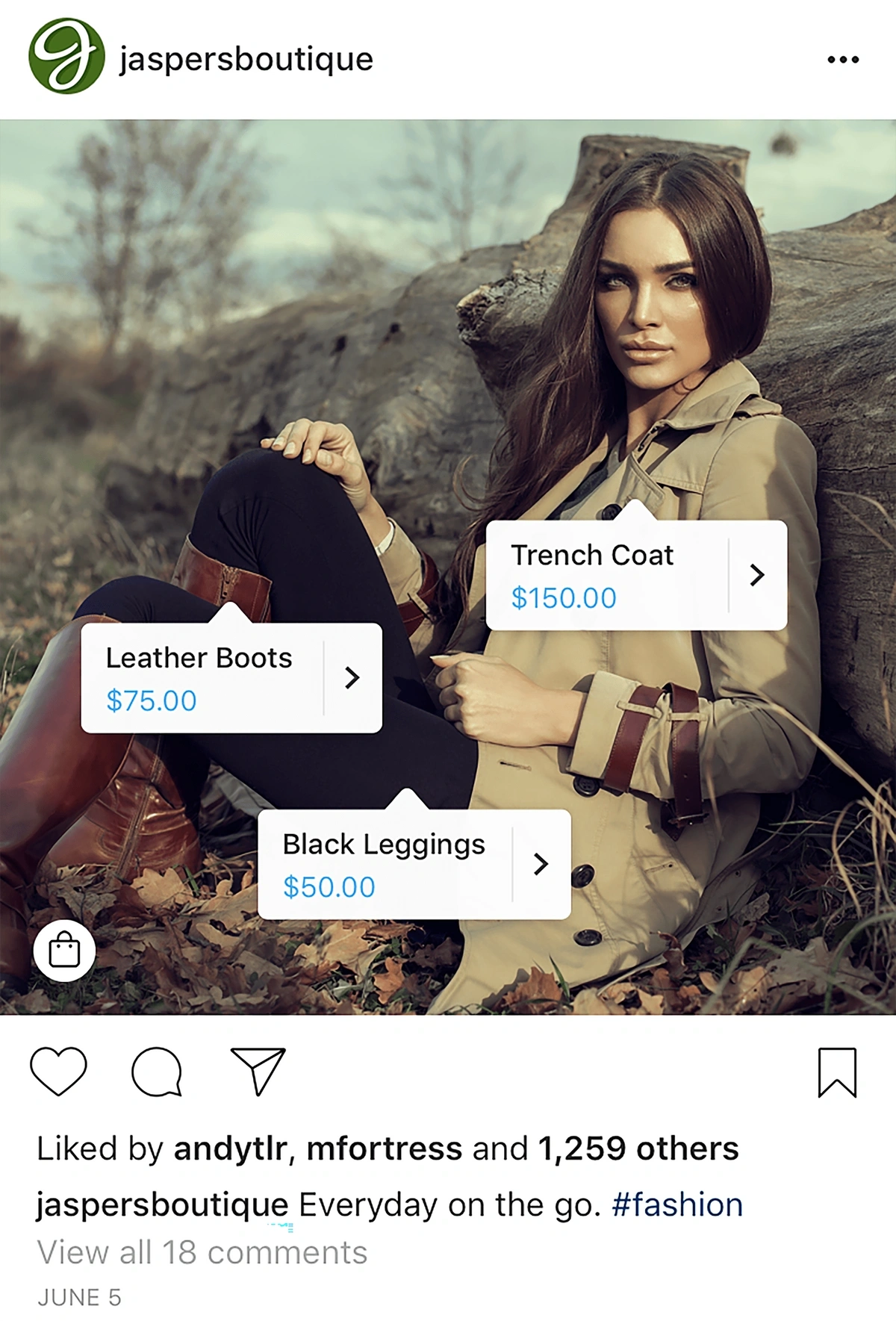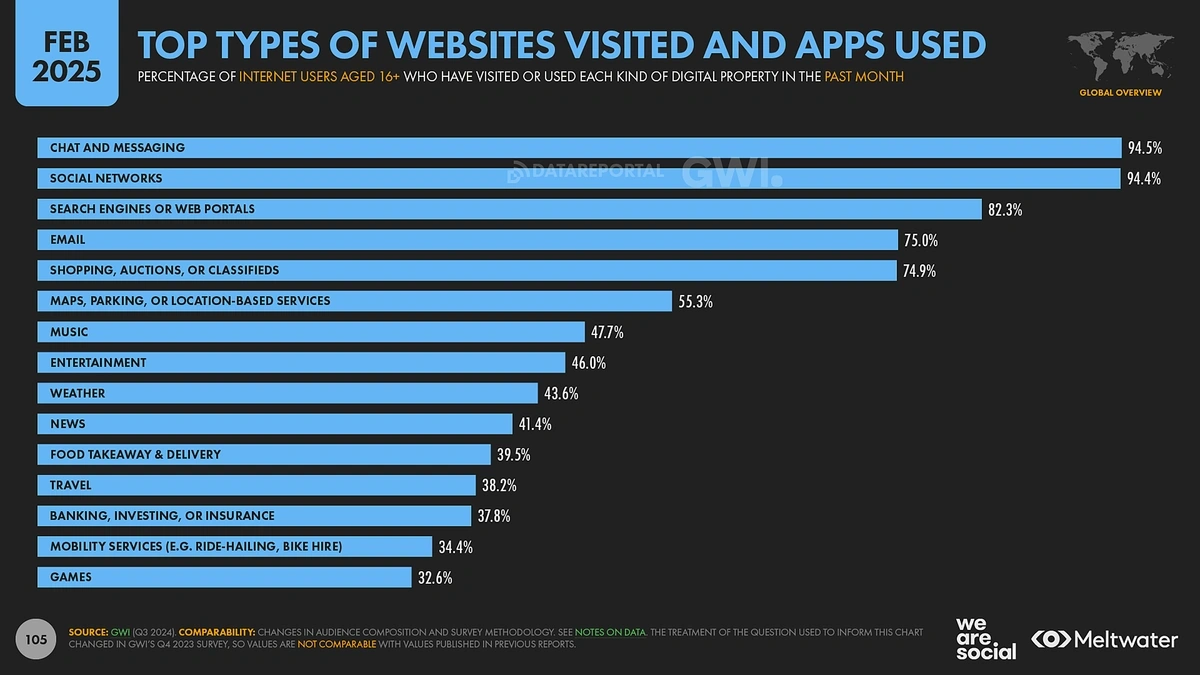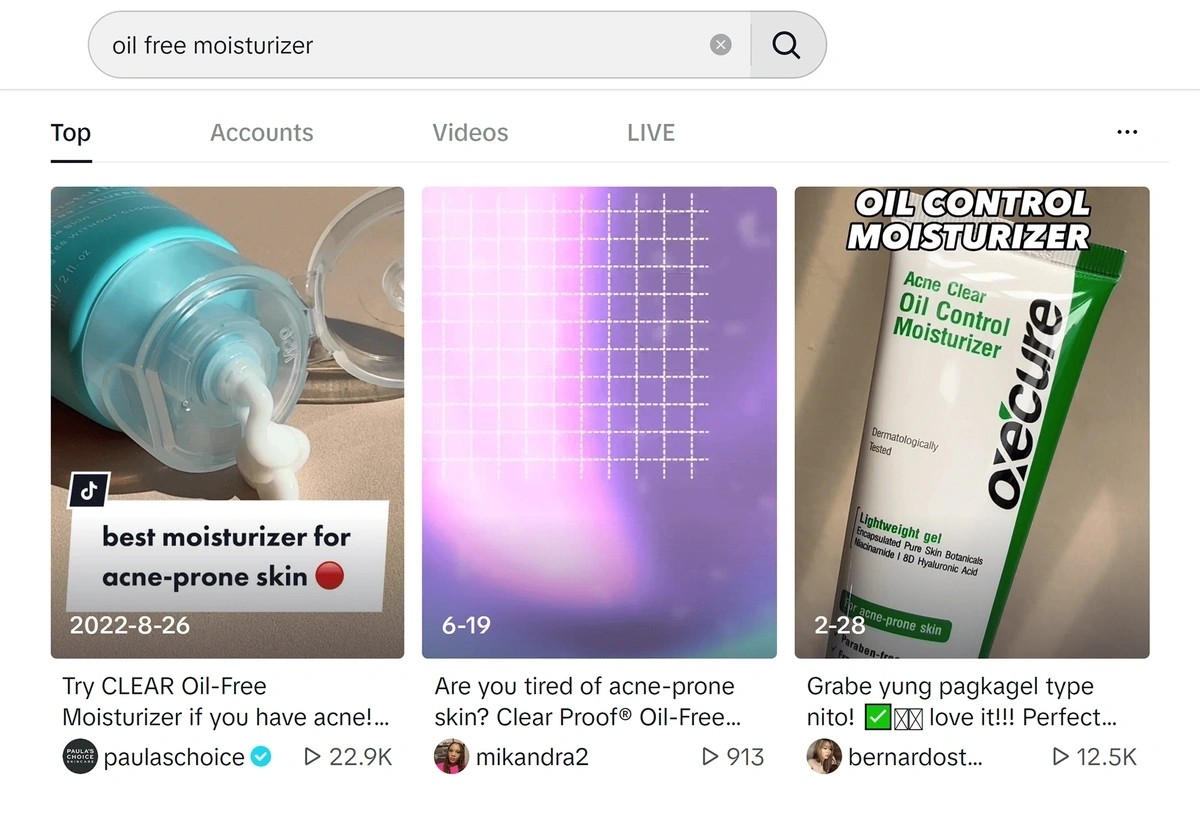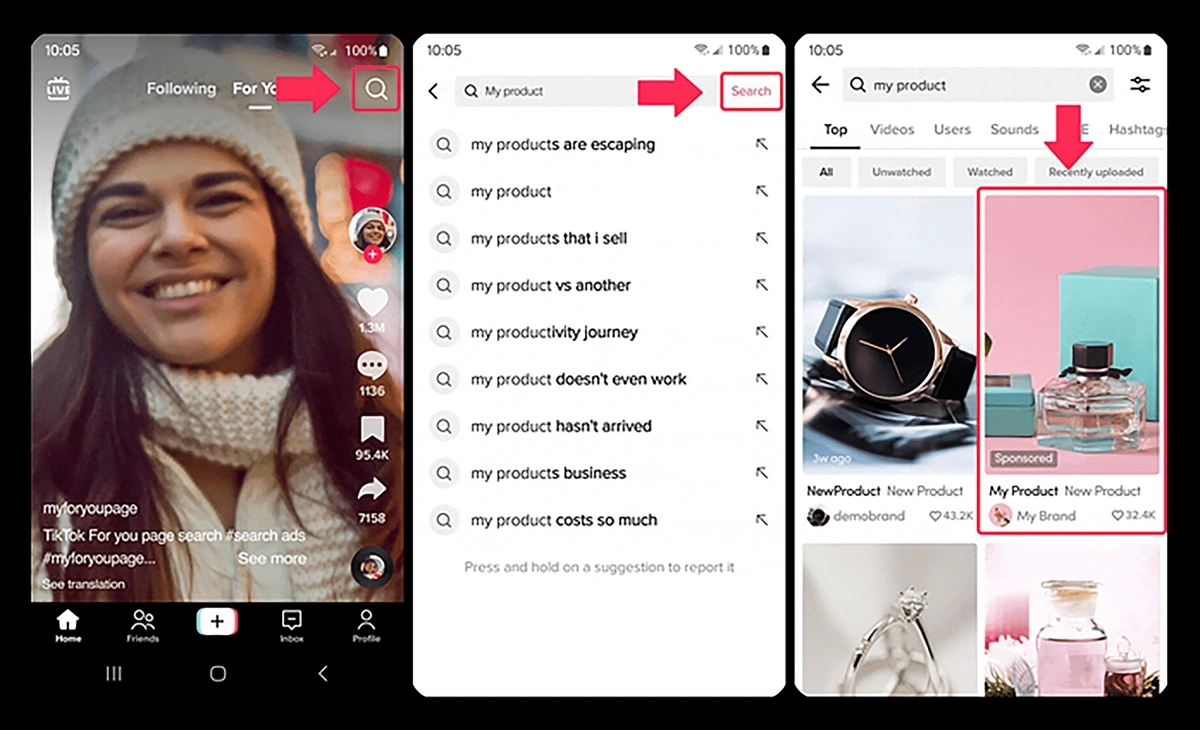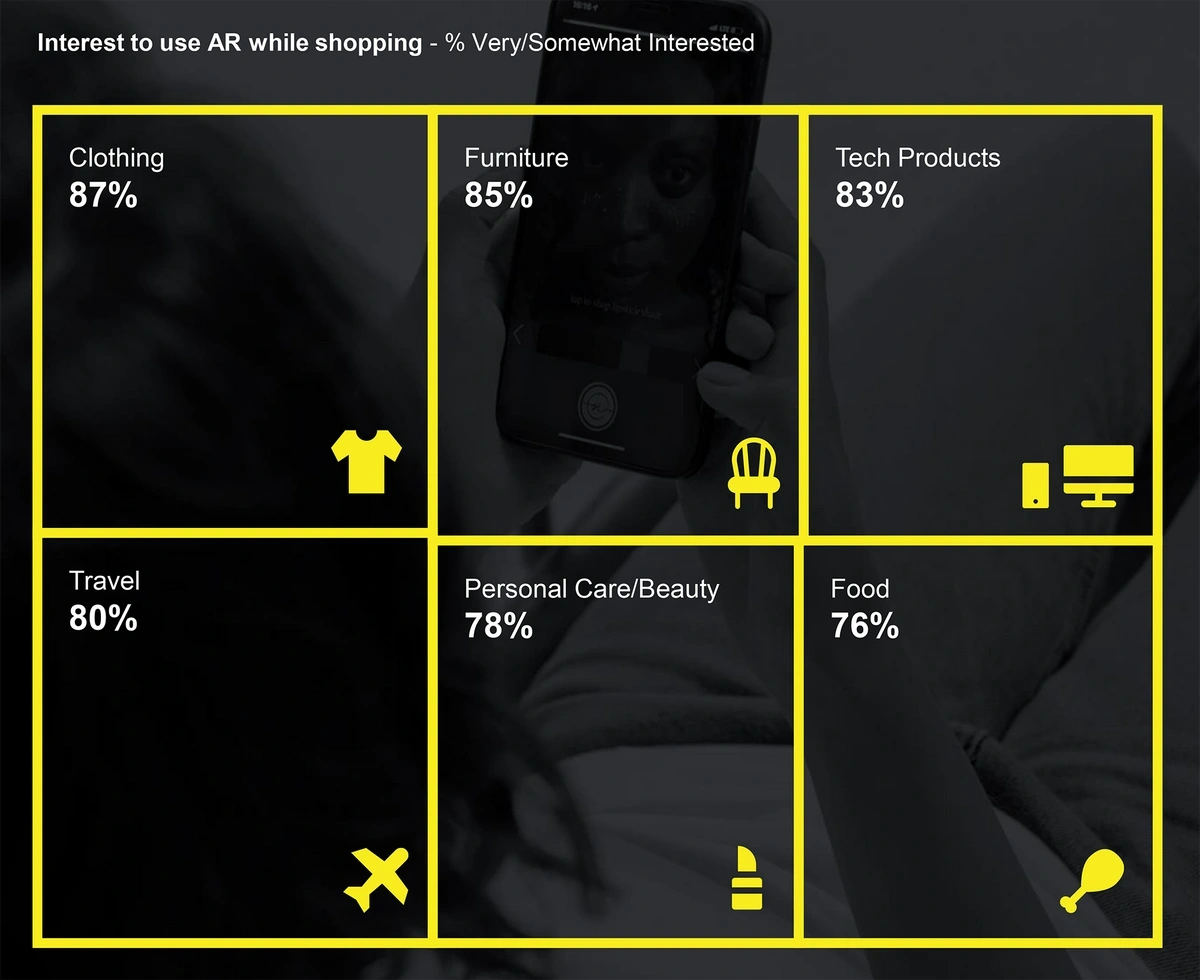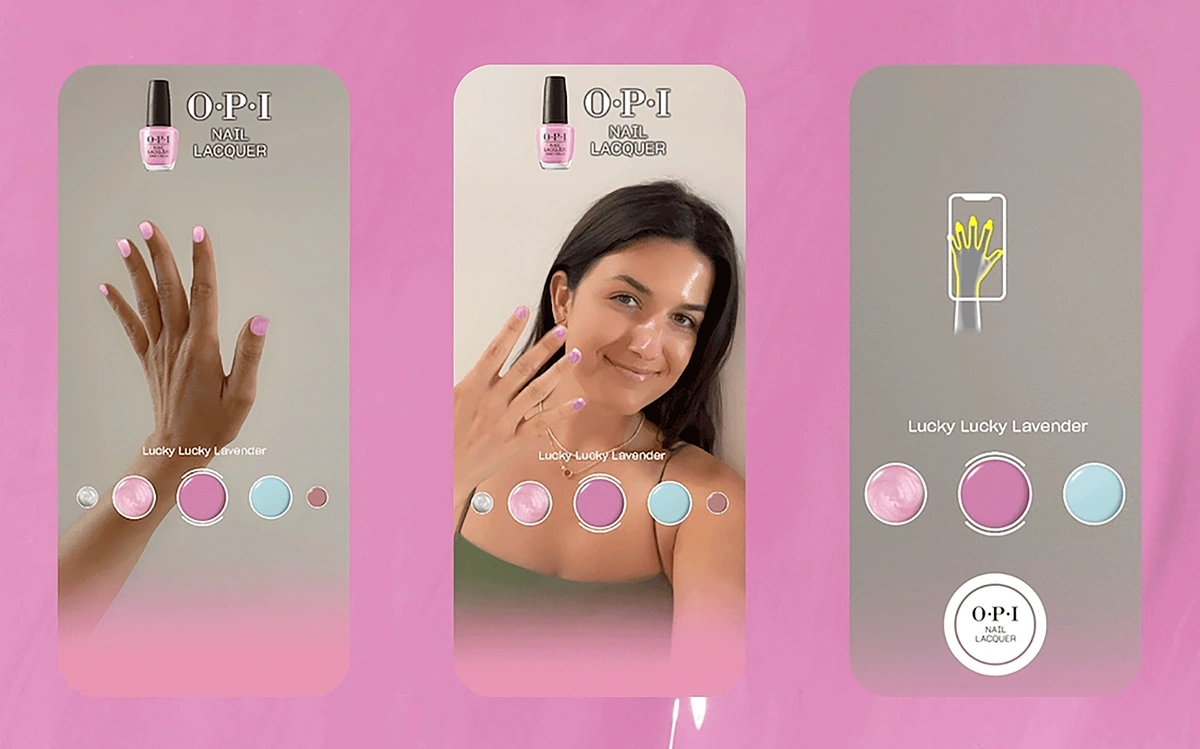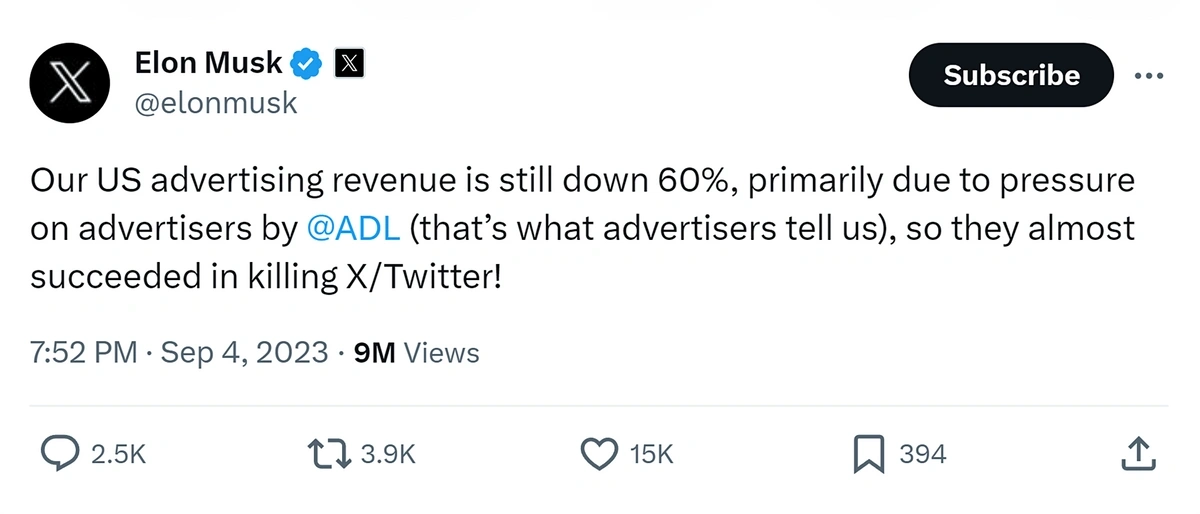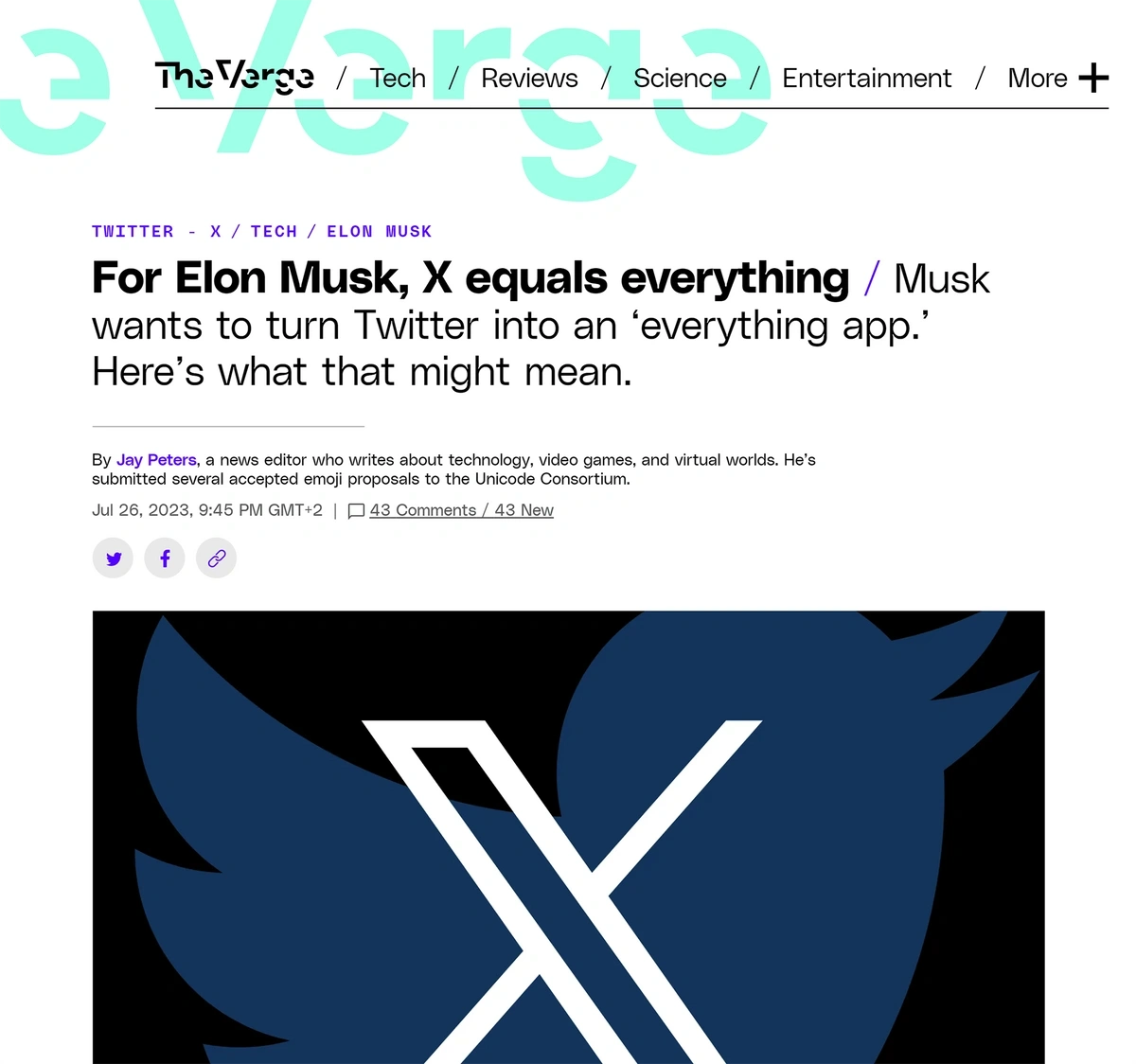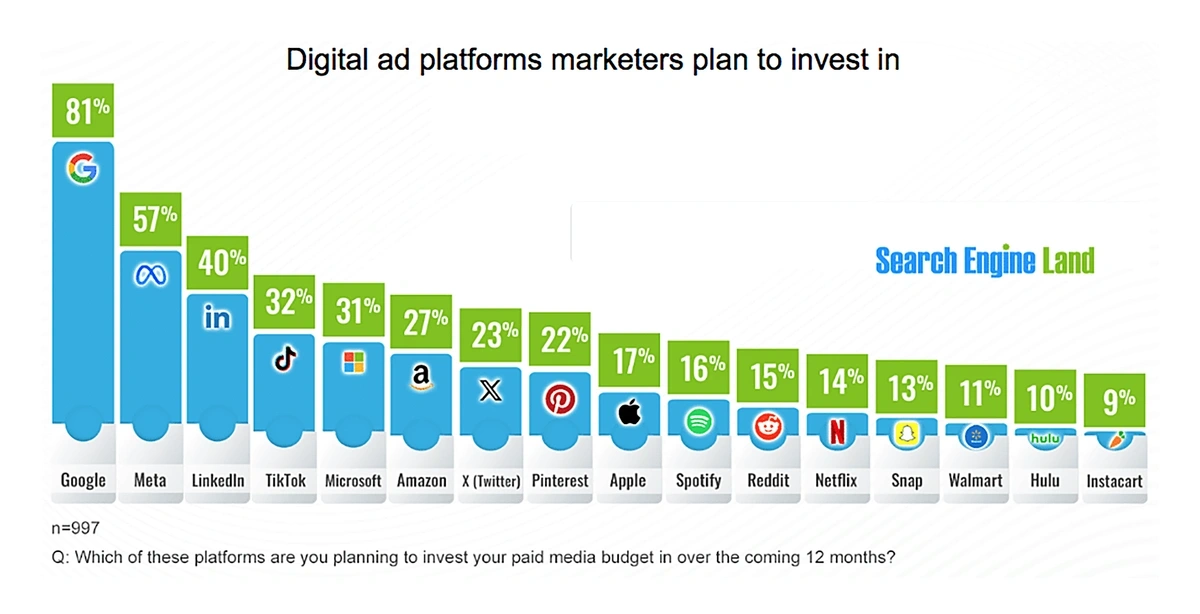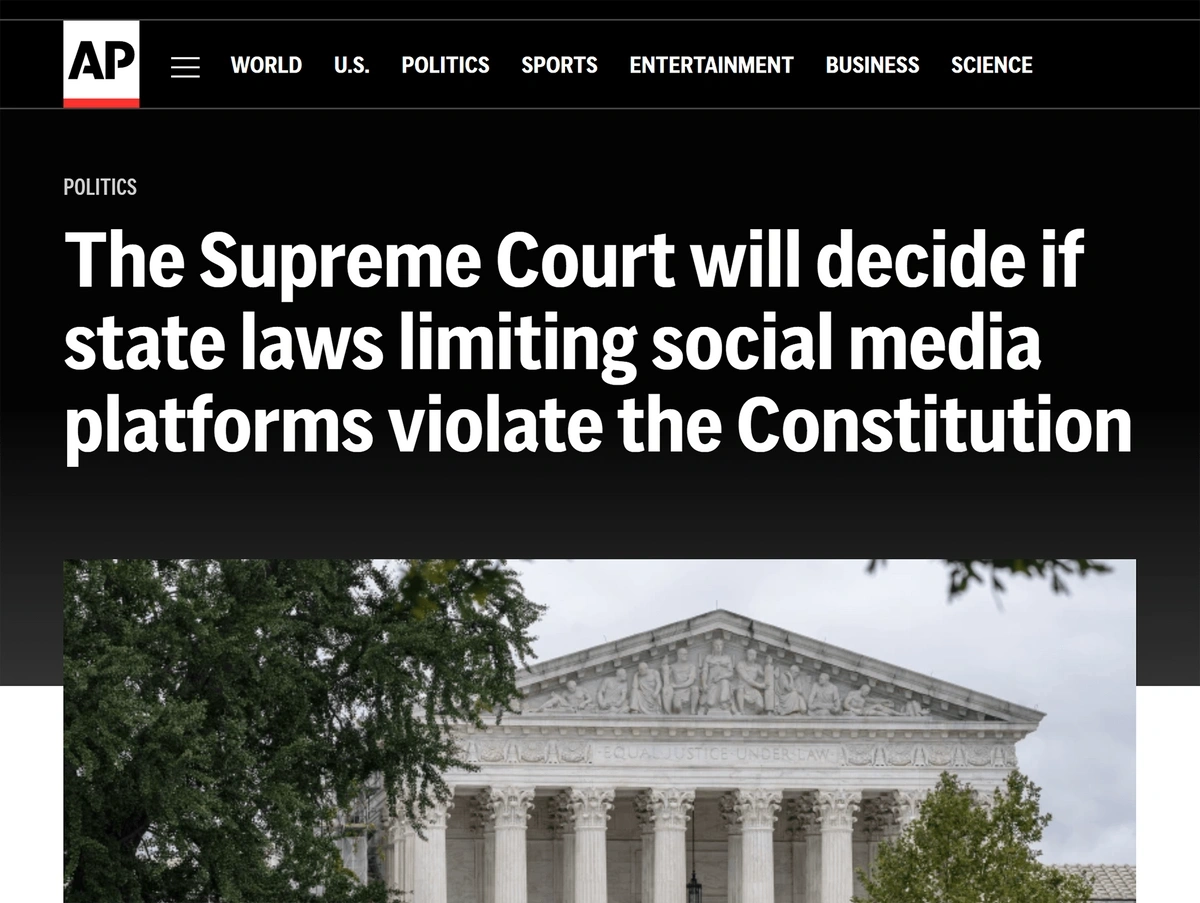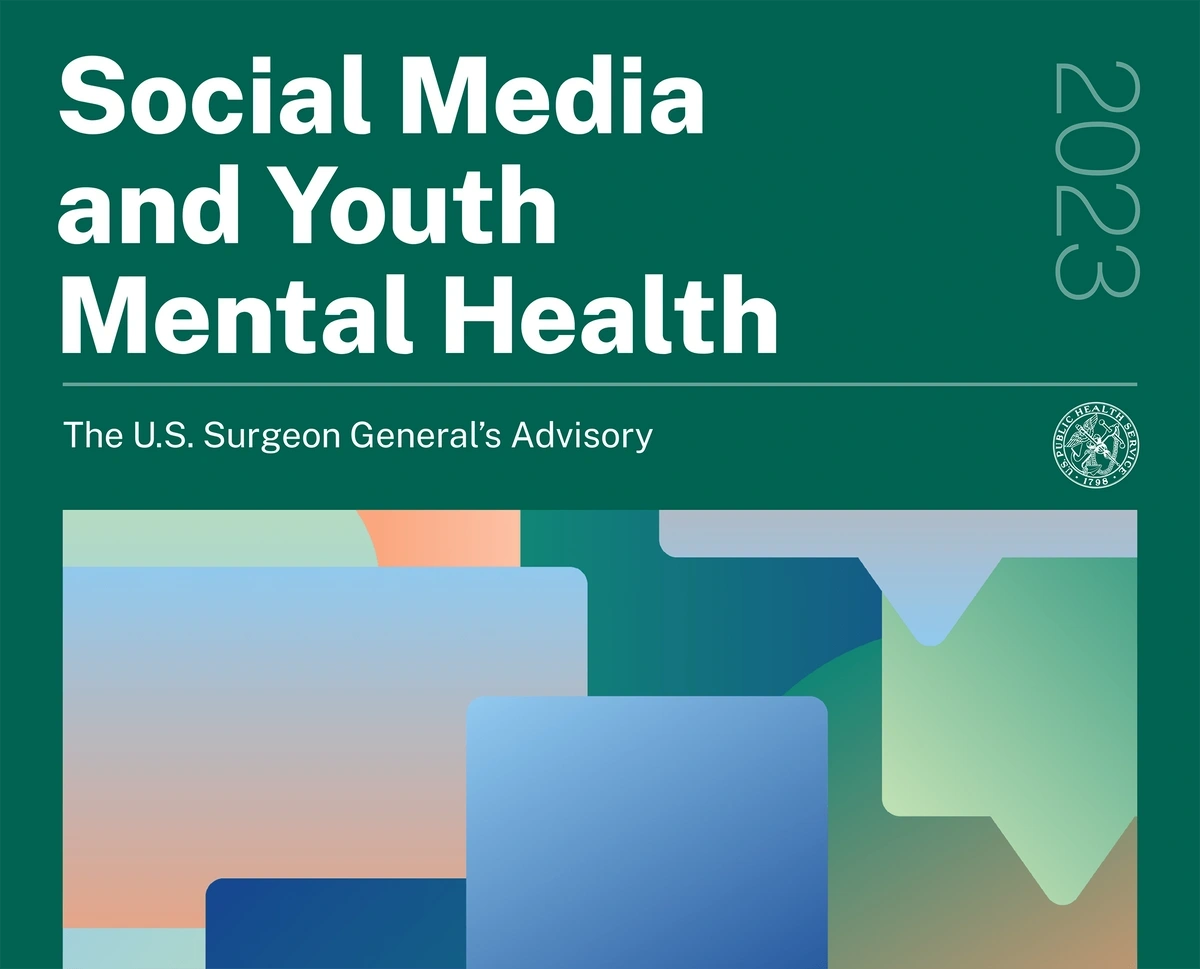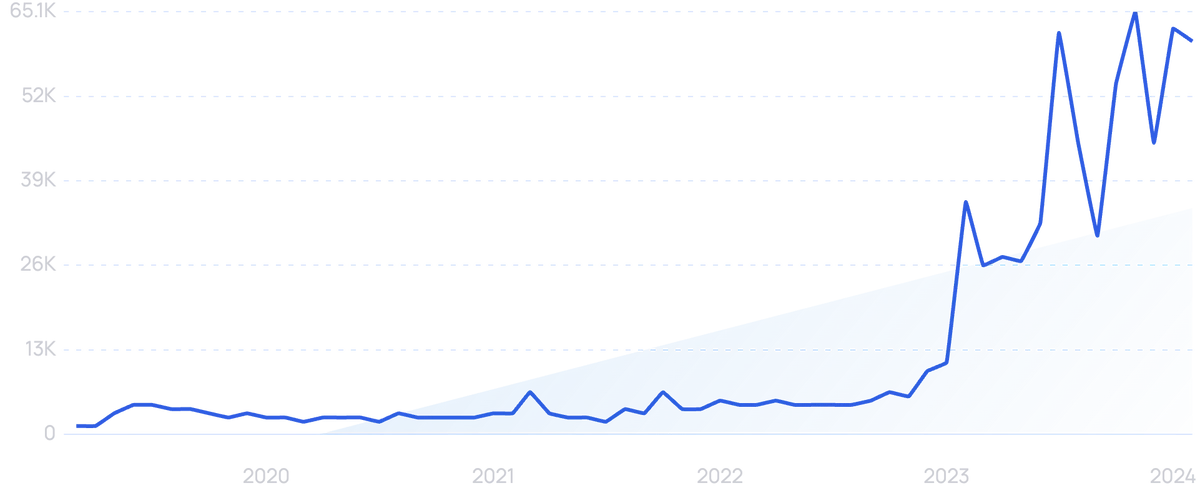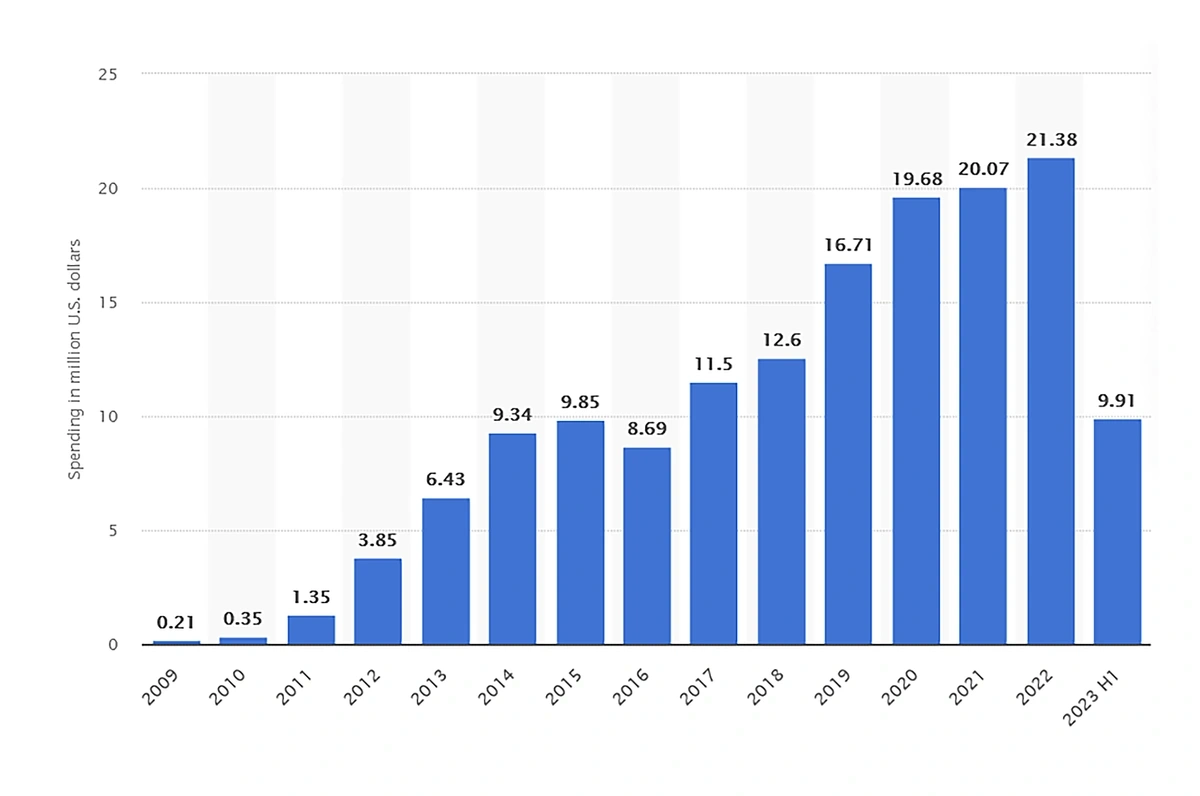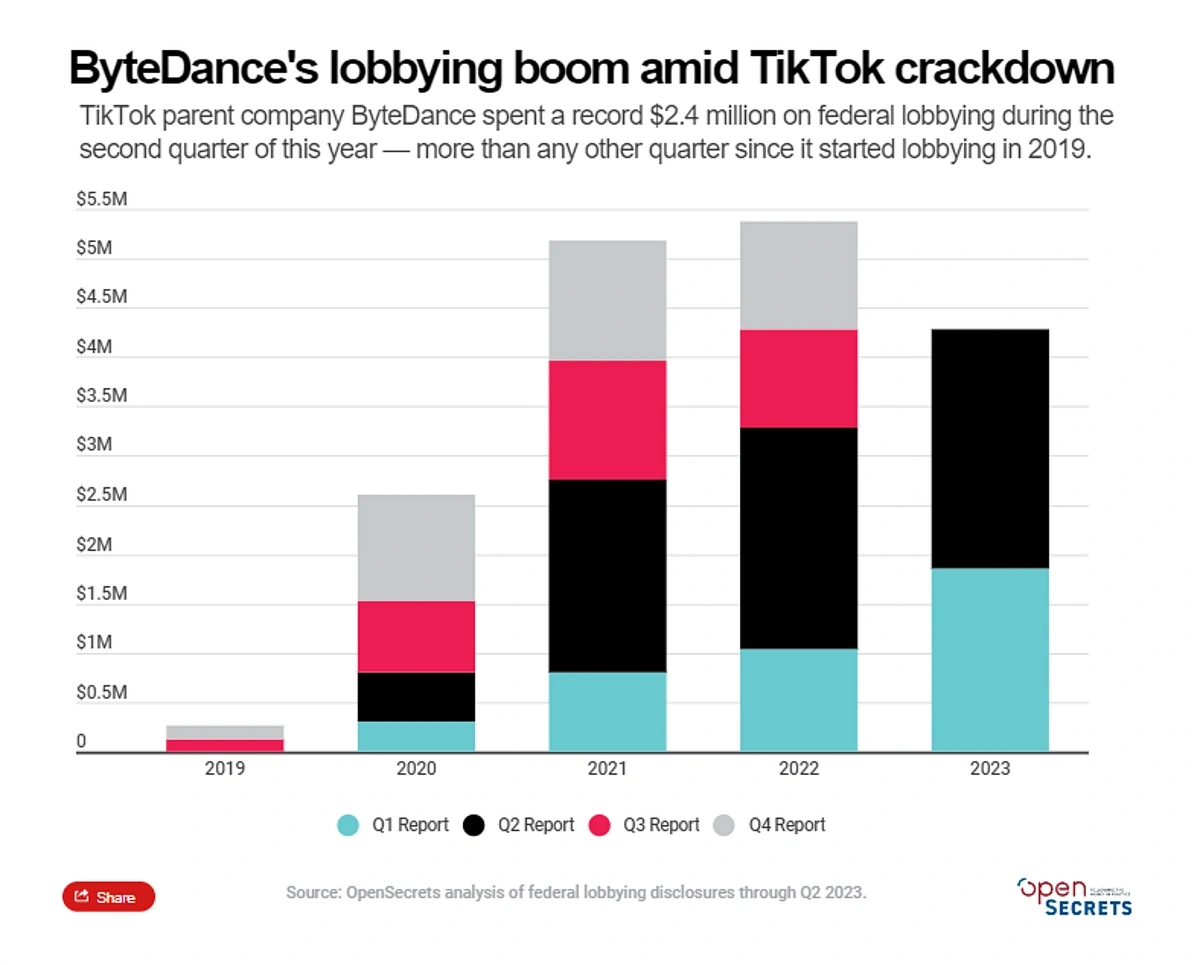
Top 14 Social Media Trends (2025)
Social media usage is at an all-time high.
However, the space is seeing seismic shifts right now.
AI is changing the way users interact with platforms. And many users are shifting to new platforms to find specific types of content.
In this report, we’ll take a closer look at the most important social media trends to keep an eye on.
1. Delegating Social Media Tasks to AI
More than 80% of marketers report that AI tools have saved time and created a more efficient workflow.
The number of marketers using AI applications has more than doubled or tripled in the last 12 months.
A 2024 survey from Hootsuite reported that 75% of social media marketers planned to use AI to completely revise and rewrite text that year. That’s up 103% over 2023.
In particular, a recent survey found that more than 40% of social media marketers are using AI to write captions.
Search interest in “AI text generation” has climbed nearly 7,000% in recent years.
Copy.ai is an example of a popular tool for caption generation.
With it, social media marketers can provide a prompt, select a tone of voice, and generate a caption.
Copy.ai has specific tools aimed at writing content for several different platforms like TikTok, YouTube, and Instagram.
Copy.ai has several text-generation features.
Hootsuite’s survey also found that 52% of social media pros planned to use AI to create images in 2024 — an increase of 136% over 2023.
According to the Hootsuite survey, image-focused applications of AI will be hugely popular in 2024.
Looking at search volume data, interest in AI image editing was even bigger than reported in Hootsuite's survey.
Latest Exploding Topics data shows search volume for "ai image enhancer" spiking massively through 2024 and continuing to rise even faster in 2025.
Search volume for “ai image enhancer” rapidly climbing since 2024 and spiking in 2025
Historical comparison in Semrush also shows Google ads appearing for "ai image enhancer" in 2025, although, there were none in December 2023.
This suggests companies offering AI image generation features are now ready to monetize their products more aggressively in response to rising demand.
(You can complete a free Google Ads competitor analysis using the Exploding Topics tool.)
Midjourney, DALL-E, and Stable Diffusion are the most popular image-generation platforms for social media pros.
These platforms create images in a matter of seconds, saving marketers a lot of time and money.
Sephora and Mint Mobile are two companies that have already launched campaigns designed by AI image generators.
Last year, Coca-Cola announced a partnership with OpenAI and DALL-E.
The company’s “Real Magic” campaign encourages users to create Coca-Cola-branded products with the help of AI.
TikTok users have been posting their Coca-Cola creations with the hashtag “Create Real Magic.”
Coca-Cola ran an influencer campaign focused on its AI image-generation tools.
In addition to creating images with AI, many marketers are planning to use AI to edit their existing images.
There are dozens of AI image editors, but Canva is the most popular.
In fact, Canva is #1 in our list of the most popular AI tools.
The canva.com website receives more than 209 million unique visitors every month.
Search volume for “Canva” has been climbing since 2020.
Canva offers a few AI-powered editing tools like background removal, image expander, object removal, prompt-based edits, and more.
Canva offers users several image editing tools.
Canva’s tools are especially easy to use because they’re built directly into the platform.
Users can edit their images at the same time they’re designing their social media posts.
Besides generating images and text, AI is also powering social media tasks like:
- Content scheduling
- Social listening
- Competition research
- Data collection and analysis
- KPI reporting
2. Popularity of TikTok Surges with Gen Z
Facebook is the most popular social media platform overall.
But TikTok remains the app of choice for Gen Z and Gen Alpha.
Semrush reports that the TikTok website gets more than 2.7 billion visits every month. 68% of these visits come from mobile devices.
The under-25 crowd on Facebook is dwindling.
eMarketer reports the percentage of Facebook users under 25 years old is now under 18%.
While 31 million Facebook users were under 25 in 2020, that number is expected to shrink to just 23.3 million users by 2026.
The number of Gen Zers on Facebook is falling.
Compare that to TikTok — 78% of Gen Z use TikTok and two-thirds of them used the platform daily.
And, nearly 45% of TikTok’s users are Gen Zers.
That’s higher than nearly any other platform. (51% of users on Snapchat are from Gen Z.)
TikTok has the second-highest percentage of Gen Z users.
On average, users aged 18 to 24 years spend 1 hour and 19 minutes per day on the platform.
Because Gen Z is the fastest-growing segment of consumers in the economy, this represents a valuable opportunity for marketers.
Search volume for “TikTok marketing” has grown 150% in the past 2 years.
According to one survey in 2024, 55% of marketers plan to increase their spending on TikTok through the year.
More than half of marketers said they planned to increase their budgets for TikTok and YouTube in 2024.
In addition, Forrester predicts that much of the ad dollars that have previously been allocated to reach young generations through TV advertisements will now be spent on TikTok.
That budget allocation is predicted to have an immediate impact.
One survey reported that 78% of small businesses have seen a positive ROI from TikTok marketing.
And most have hit this milestone within just six months.
Dunkin’ Donuts is one of the most well-known companies that’s marketing to Gen Z on TikTok.
The company has partnered with a few Gen Z influencers like Charli D'Amelio and Champagne Mike.
Charli D’Amelio is one of Dunkin’s best-known influencers.
Folgers Coffee and Panera Bread also ran notable Gen Z campaigns on the platform in 2023.
Of course, the ongoing threat of a TikTok ban could yet change the equation.
3. Social Media Provides Customer Support for Impatient Customers
Today’s consumers expect a response to their problems immediately.
Zendesk reports that more than 72% of consumers expect immediate service from the companies they contact.
But only 56% of consumers felt positive about their customer support interactions over the past year.
Nearly one-fifth of consumers had negative interactions with a customer support representative in the past year.
Another survey found that 90% of consumers feel that an instant response from customer service is either crucial or very important. About 60% of consumers say that “instant responses” come within 10 minutes of the initial contact.
This demand for speed and personal attention is leading many brands to offer customer service and support via social media channels.
And customers are noticing.
The Sprout Social Index found that 51% of consumers believe that the most memorable brands on social media are those that respond to their customers.
More than half of users say the most memorable brands on social platforms are those that communicate with their customers.
The survey also showed that 76% of social media users value the speed with which a brand replies to a message on social media.
Spindrift is one company that’s prioritizing quick replies on X.
A recent customer conversation on X.
Spindrift’s X account often posts a reply to a customer issue within minutes.
And the replies strike the right tone for the brand and their customers. The replies are always empathetic and often humorous.
For some businesses, providing 24/7 customer support on social media is a demanding job that stretches their customer service capabilities to the brink.
That’s why many are implementing AI-powered chatbots.
Searches for “AI chatbot” spiked in 2023. But remain high in 2025.
A survey from Hootsuite reported that 46% of social media marketers planned to use AI chatbots to respond to messages in 2024. That’s up 318% over 2023.
These chatbots use conversational AI to respond to posts, DMs, or chats on nearly any social platform.
For example, an Instagram food influencer used a bot to respond to thousands of comments and send a recipe to each person who commented. The chatbot used a mix of pre-determined comments so the responses would appear more human and less bot-like.
The chatbot’s actions were triggered by each user posting a comment that said “fudge”.
Chatbots were instrumental in quickly responding to users’ comments and promoting this influencer’s content on Instagram.
4. Social Media Use Continues to Climb
The number of social media users now totals nearly 5.24 billion. That’s more than 61% of the world’s population.
The average number of social media platforms used each month saw an YoY growth of 2.3%.
In terms of users, social media is on track to overtake TV viewers in 2025.
The number of TV viewers is predicted to fall to 230 million by 2025 while the number of social media users is expected to grow to 235 million.
Not only is the number of social media users growing.
The amount of time users are spending on social media platforms is growing too.
The average user spends nearly 2 1/2 hours per day on social media.
That represents more than a third of the total time online.
The world’s growing dependence on social media has fueled calls for social media detoxing and initiatives to reduce social media reliance, like National Day of Unplugging and digital minimalism.
Some users are even opting to go back to “dumb phones” to break their reliance on social media and other apps.
The TCL Classic is an example of a dumb phone.
These minimalist phones feature texting and calling but little else.
Search volume for “minimalist phone” has been climbing in recent months.
Rapper Kendrick Lamar released a limited-edition dumb phone in late 2023 and it sold out almost immediately.
Some analysts believe the penetration rate of dumb phones in North America could reach 5% in the next five years.
5. Social Media Becomes King of Advertising
Digital ad spending is soaring.
Spending on digital ads were estimated to reach $740 billion in 2024. And experts say that number could reach $802 billion in 2026.
In fact, digital spending now accounts for more than 65% of total ad spend.
Digital ad spend is predicted to climb nearly 10% every year.
Social media ads are a big part of that spending.
Last year, just five companies were in the race to pull in nearly 52% of all global ad revenue; two are social media companies (Meta and ByteDance).
In 2023, it was estimated that businesses spent $68.45 billion on paid advertising on social media in the United States.
Per company, that amounts to an average of 19% of an organization’s total marketing budget.
Organizations are spending approximately equal amounts on social media ads and TV ads.
But by 2028, organizations say the percentage of their budget devoted to social media will surpass 26%.
The most popular platform for social ads is Meta — estimated to have pulled in 64% of global ad spend on social media in 2024.
And that number may increase even further in 2025 and beyond as X loses ad dollars.
In late 2023, several large corporations like Disney and Comcast reported plans to pull ads from X and divert that ad spending to Instagram.
More than half of the top 100 ad buyers on X are no longer advertising on the platform.
Disney increased spending on Meta by 40% and Comcast increased its spending by 6%.
But it’s not just ad spending that’s increasing.
Companies are spending more on influencer marketing, as well.
Influencer spending is growing at a rate of 3.5x that of social media ad spending.
And it’s estimated to continue to grow by at least 14% every year through 2025.
Businesses spent an estimated total of nearly $2 billion on Instagram influencers in 2023.
And they're investing in dedicated influencer marketing tools like the Semrush Influencer Analytics app.
TikTok is the second most valuable influencer platform with an estimated spend of $990 million on the platform in 2023.
Lilly Pulitzer is just one example.
The company tripled its influencer marketing budget in 2023.
Lilly Pulitzer tripled their influencer marketing budget in an effort to modernize the brand.
6. Social Platforms Integrate AI Features
Social platforms have been using AI for years. The technology runs everything from recommending posts to populating feeds to targeting ads.
But as AI technology improves, the number of ways that platforms apply AI has been increasing.
For example, basic ad targeting is now super-charged on Pinterest thanks to AI.
In late 2023, the platform announced it had used AI-powered optimizations to increase its ad delivery model size by 100x. The expansion of their model means that businesses have even more targeting options when it comes to creating ads.
Our list of Pinterest stats shows the visual discovery network is reaping the benefits.
And, with AI, making social media ads is easier than ever.
Meta launched in-app generative AI tools for marketers late last year.
With these tools, marketers can use AI to expand images, create backgrounds, and re-write the ad’s text to create six new versions.
Social media marketers can use Meta’s AI features to build ads in less time.
Meta says using AI will save marketers five or more hours per week.
Social platforms are also rolling out AI features for users and creators.
In 2024, YouTube introduced an AI tool that creates backgrounds.
Generative AI powers YouTube’s Dream Screen.
In February 2025, YouTube “Dream Screen” was expanded with Veo 2, a new feature that lets you generate short video clips with text prompts and add to your shorts.
Search volume for “YouTube Shorts” has been climbing since 2021.
Meta recently debuted a host of AI features aimed at bringing users to their platforms. The company says they are testing out 20 generative AI tools.
One tool allows users to “reimagine” images that are sent to them through Facebook Messenger or Instagram chat.
Clicking on the image will bring up a box where users can type out a prompt. Facebook’s Emu image foundation model will then create the desired image.
Facebook and Instagram users can play with images in chat and use Meta’s AI tools to reimagine the images.
Meta also launched generative AI tools for creating and editing posts, comments, and videos, along with AI-generated stickers and chatbot characters.
LinkedIn is also hoping to attract more users by offering AI-powered features that are helpful to a more professional-orientated audience.
The platform released Recruiter last year, an AI-powered assistant to help HR officials find and hire the right talent.
For those looking for a job, the platform has LinkedIn Learning, a chatbot that provides advice based on a person’s current job, career goals, and skills.
LinkedIn Learning’s chatbot provides coaching to users.
As of May 2025, LinkedIn receives 1.4 billion monthly visitors.
7. Brands Engage Users with Authentic Content
The days of hard-selling, brand-forward promotions on social media are over.
People won’t connect with brands that only talk about themselves and their products.
People want useful information they can use in their lives. They want an emotional connection to a brand. They want to know that a brand is human and shares their values.
Today’s most impactful brands are tailoring their social content so it tells a genuine story and builds brand authenticity.
Search interest in “social media authenticity” is up more than 225% in recent years.
A few trends stand out when it comes to building brand authenticity.
The continued rise of user-generated content (UGC) is one.
This type of content is the most authentic a brand can get. It’s social proof that brands and products do what they say they do.
In one survey, consumers were 2.4x more likely to rate a brand as authentic when they published UGC as opposed to brand-created content.
For many customers, UGC is what will bring them back to a brand again and again.
A Sprout Social survey showed that 28% of consumers say that the most memorable brands on social media are the ones that highlight the stories of their audience over their own products and services.
Buffer is a company that’s become famous for their all-out transparency. The company is authentic on social media too, and often posts UGC to back it up.
Buffer posts positive reviews in their Instagram feed.
Another company that’s maximizing UGC is the luggage brand Away.
The company’s Instagram feed features UGC that’s on-brand and conveys authenticity.
For example, several of their reels call out the bold colors of their luggage — a feature that’s helped build the brand’s identity.
Away showcases their vibrantly colored luggage on their Instagram feed.
Another way brands are building authenticity is through honest communication via their social media channels.
Nearly 90% of social media users say that businesses can regain their trust during a crisis by admitting the mistake and being transparent about the steps they’re taking to resolve the problem.
On a relatively minor scale, Slack uses this type of communication to let users know about outages.
On a much larger scale, in early 2022, Weber found itself amid a crisis when the marketing department didn’t act quickly enough to stop a scheduled email from going out. The email featured a “recipe of the week” for meatloaf. The crisis? Meat Loaf, the singer, died on that same day.
The company was quick to send an apology email and subscribers went to social media to share it.
Weber’s social media team stayed ahead of the crisis with an immediate apology.
8. Continued Expansion in the Influencer Market
Influencer marketing is a billion-dollar business. The total value is predicted to surpass $32.55 billion in 2025.
The influencer market added approximately $3 billion in value between 2023 and 2024.
Nearly 60% of marketers work with influencers each year. Many say this type of marketing delivers the highest ROI of any of their marketing efforts.
A large part of that value comes from the authenticity of influencers.
Having a third party promote a product not only boosts brand awareness, it also builds trust and credibility with the audience — which can really pay off in terms of revenue.
According to one study, 70% of consumers are open to spending more money if a brand is authentic and trustworthy.
But the market is changing.
Instagram used to be the go-to platform for marketers and influencers, but now, it’s TikTok.
AdAge reports that 56% of influencers are using TikTok and only 51% are using Instagram.
TikTok has become the most popular platform for influencer marketing.
Here’s another change for brands to navigate: many audiences no longer view big-name celebrity influencers as authentic.
That’s why social media experts are looking for growth in the micro and macro tiers of influencers in the coming months. That means influencers with less than 99,999 followers.
In 2022, 33% of marketers said micro-influencers were the most successful for their brand and 38% said macro-influencers were the most successful.
Many brands are seeing success with small-scale influencers.
Nano-influencers, with 1,000 to 10,000 followers, are also on the rise.
Search volume for “nano influencer” has grown about 223% in the past 5 years.
Although these social media accounts have relatively small followings, they tend to have very engaged audiences.
In fact, data shows the engagement rate of nano-influencers is about 4%. That’s the highest of any influencer level.
Nano-influencers boast high engagement rates.
Plus, they’re affordable—the average rate is just $5 - $25 per TikTok post, for example.
Jen Lauren (@jen_laurenn) is one example of a nano-influencer on Instagram.
Her channel is focused on wellness, so it makes sense that she’d partner with companies like Athletic Greens (powdered supplement drink), Hilma (supplements), and F45 (fitness training).
Jen Lauren is a fitness influencer that engages users with authentic posts about fitness and wellness.
In another example, Marissa Meshulam (@mpmnutrition) is a micro-influencer in the food and nutrition space.
She’s worked with food brands like Simple Mills, Gutzy Organic, and Hu Kitchen.
This Instagram feed brings in users who are interested in organic food and natural wellness.
9. Shorter Attention Spans Result in More Bite-Sized Content
Yes, people are spending more time on social media.
But they're spending less time engaging with individual posts.
In the early 2000s, one researcher ran experiments tracking people while they were using electronic devices.
At that point, the average attention span while on the device was about 2.5 minutes.
The researcher recently re-ran the experiment and found that the average attention span while on a device is now just 47 seconds.
Other research says individuals’ attention span on social media is even shorter.
Gen Z loses focus on an ad after 1.3 seconds, recent data shows.
With short attention spans, Gen Z users prefer platforms with short ad formats.
Users also prefer quick content when it comes to their feeds.
According to TikTok data, nearly half of users say videos longer than 60 seconds are “stressful”.
Their data shows videos lasting 11 to 17 seconds are the most successful.
Instagram users prefer a similar timeframe — reels between 7 and 15 seconds are best.
When compared to other trends like VR/AR, live audio, and podcasts, short-form video is the clear winner for marketers — 33% of marketers are planning to invest most in short-form content.
Social media marketers are investing heavily in short-form videos.
With 2 billion monthly active users, YouTube Shorts is quickly becoming a go-to platform for short-form content.
Drunk Elephant Skincare is using the platform to feature its products with videos that are often 15 seconds or less.
Drunk Elephant Skincare emphasizes the texture and freshness of its products with posts on YouTube Shorts.
In another example, LadBible made a dedicated investment into short-form video in 2023 and it resulted in a 13% boost in social revenues.
The social publisher’s Facebook feed is followed by nearly 50 million people.
Most of their video content is 30 seconds and engagement is impressive. Most posts receive thousands of likes and hundreds of comments.
Short-form videos have increased engagement and revenue for LadBible.
10. Facebook and Instagram Propel Social Commerce Forward
Last year, 100 million Americans made a purchase via social media for a total of nearly $67 billion in sales.
By 2027, experts say total sales will more than double that amount to land at $144.62 billion.
Shopping on social media is driving billions of dollars in revenue.
Right now, the most purchased items on social media fall into apparel, beauty, and home goods product categories.
And when it comes to who is making most of these purchases, it’s clear that younger generations are leading the way.
Overall 17% of consumers have bought a product on social media in the past three months.
But when considering just millennials that number is 27% and when considering only Gen Zers it’s 22%.
Millennials are the most likely age group to shop on social media.
Facebook leads the way as a top choice for social commerce.
Search interest in “Facebook marketplace” has increased more than 469% in the past 5 years.
Facebook Shops boast more than one million monthly active users and Facebook Marketplace has more than one billion monthly users.
Facebook Shops provide a catalog of products directly on the platform.
But Instagram is popular, as well.
Nearly three-quarters of Gen Z list the platform as their favorite for social commerce.
Gen Z prefers to shop on Instagram while the general population prefers Facebook.
Nearly 45% of Instagram users are using the app to shop every week.
Instagram users can shop a brand’s post and be seamlessly directed to purchasing the items.
In the coming months, it looks like the social commerce trend will grow as individual buyers increase the amount they spend.
Insider Intelligence data shows that sales per buyer totaled $337 in 2020. By 2027, they predict that number to soar to $1,223 per buyer.
11. Search Moves Beyond Google
94.4% of internet users aged 16+ years old visited a social network site in February 2025.
In that same month, just 82.3% visited a search engine.
More internet users visited a social media site than a search engine in February 2025 .
Discovering products, researching brands, and getting advice are now tasks that can easily be completed via social media instead of Google’s search bar.
Social search is incredibly convenient for users because they’re already on the platform. Plus, the search results are updated in real-time as more users add content.
Search volume for “TikTok SEO” has grown by 4,400% since 2019.
In fact, 44% of Gen Zers and 33% of millennials get their product information mainly from social media.
Users are looking for educational content and tutorials too.
Brands are beginning to leverage this behavior and meet consumers where they’re at on social media.
It’s no surprise that nearly 90% of marketers say social search optimization is now an important part of their overall strategy.
They’re using hashtags, adding alt text, and placing keywords in captions to make their content easy to find.
A TikTok from Paula’s Choice appears in the search results for “oil-free moisturizer”.
Another way brands are appealing to social search users is using TikTok’s Search Ads.
TikTok Search Ads give businesses a chance to engage the consumer through search.
Launched in late 2023, these video ads appear within the flow of organic search results on the platform.
And TikTok says they boost performance — 70% of ad groups that were tested using Search Ads achieved a lower CPA than those that didn’t utilize Search Ads.
Beauty brand Clinique reportedly saw a 441% increase in conversions by utilizing Search Ads.
Instagram and Reddit have also released search ads, as well.
12. More Augmented Reality Options
The Augmented Reality (AR) market is still in its infancy.
But it’s projected to gain momentum in the coming years.
In 2022, the XR market, which includes AR, VR, and MR, was valued at $29.26 billion.
By 2026, predictions show market value could go as high as $100 billion.
Some social media networks are already getting in on the trend.
In fact, the number of mobile AR users is expected to hit 1.4 billion by the end of the year.
One of Meta’s most recent AR features was rolled out to promote the Rugby World Cup in September 2023.
Their platforms featured AR filters based on mascots and imagery from each of the participating teams.
Fans could access 20 “superfan” AR filters on Meta platforms.
AR can certainly drive brand identity and user satisfaction through fun applications like filters, but it can also drive revenue when applied to social shopping.
A survey by Google found that more than 90% of Americans already use AR for shopping or would consider using it in the future.
And, Google’s data showed that products advertised with AR/VR features had a 94% higher conversion rate than regular advertisements.
Research from MAGNA Media Trials shows that 64% of social shoppers are very or somewhat likely to use AR when they shop in the future.
Respondents showed the most interest in using AR for clothing and furniture.
Social media users are very interested in using AR to shop for clothing, furniture, and tech products.
In addition, nearly 65% of users in MAGNA’s survey said they’d be less likely to return a purchase if they could experience it virtually first.
Snapchat is one of the social platforms that’s already taking full advantage of AR features.
The platform recently built AR functionality for beauty brands like Supergoop and OPI.
Snapchat users can try on nail polish via an AR filter.
13. X Moves Ahead on Shaky Ground
Twitter transformed to X in October 2022 and, in the time since then, the platform has been faced with numerous challenges.
The platform’s overall value has dropped to around $15 billion, according to Fidelity.
In September 2023, company officials announced that ad revenue had fallen by 60%.
Elon Musk posted information regarding X’s advertising woes.
According to a HootSuite survey, 70% of marketers are now uncertain about the ROI potential for Twitter/X marketing.
That’s partly because of the loss of reach — daily active users on the platform are down 17.8% in the US year-over-year.
However, company officials still have the ultimate goal of making X an “everything” app.
Company officials have revealed several ideas about what “everything” might entail.
To that end, X has debuted a number of new features:
- X users can now make audio and video calls via DMs.
- X subscribers can now upload videos up to two hours long.
- Subscribers can also write longer posts — up to 10,000 characters.
- Company officials hope to launch a news service called XWire.
- Officials also hope to facilitate the sending and accepting of payments via the platform. X has been cleared for payment processing in 12 states.
Despite this progress, the platform is still viewed as a risky one by most marketers.
Last year, only 23% of social media marketers said they were interested in investing in X marketing.
Less than one-quarter of marketers wanted to invest in X in the next 12 months.
14. Looming Regulations for Social Content and Platforms
Issues like hate speech, disinformation, freedom of speech, privacy, and national security have increasingly become hot-button subjects for social media platforms.
Regulations have been proposed, but in many cases, these regulations have been politically charged.
In one survey, Democratic voters were twice as likely to favor strict social media content regulation than Republican voters.
Regulatory laws enacted in conservative states like Florida and Texas are currently under review by the Supreme Court. These laws seek to protect users from censorship.
The Supreme Court will decide the constitutionality of social media regulations.
One bipartisan call for regulation comes from the Platform Accountability and Transparency Act. The law would require social platforms to disclose data and information about how their algorithms work and how they regulate content.
Children’s safety on social media is another area of regulation that’s received support. This is partly due to a warning from the Surgeon General regarding the dangers of social media use among children.
The Surgeon General said, “There is growing evidence that social media use is associated with harm to young people’s mental health.”
The types of restrictions range from curbing the use of addictive features on social media to limiting the time frames in which platforms can send notifications to adolescents.
States like Arkansas, Texas, and Utah have already passed laws requiring minors to have the express consent of an adult in order to sign up on a social platform.
During last year's elections, there was also increased worry about the effects of disinformation and deepfakes being spread on social platforms.
Search interest in “deepfake AI” grew rapidly in 2023.
At the same time, social media platforms are attempting to protect their interests.
In 2022, for example, Meta spent more than $21 million on lobbying — the most ever in the history of the company.
Meta’s lobbying expenses have totaled more than $19 million per year since 2020.
The same year, TikTok's parent company ByteDance spent $5.3 million on lobbying.
ByteDance is spending millions each year to lobby the federal government.
In the European Union, lawmakers have already been successful at passing regulations. The main law, which went into effect in August 2023, is known as the Digital Services Act.
The law’s regulations are far-reaching and include rules to stop the spread of harmful content while ensuring privacy and free speech.
These regulations apply to 17 big-tech companies including Facebook, TikTok, Snapchat, and other social platforms.
Conclusion
That wraps up the top 14 trends impacting social media platforms and their users.
Social media usage is expected to remain on an upward trajectory over the next 2-3 years.
New technology, such as AI and AR, are ensuring that users stay glued to top social media platforms for longer periods of time each day. Brands are taking advantage by increasing their budgets for content creation, influencers, and ads.
This growing engagement is projected to continue to fuel social commerce and generate revenue for businesses. But that’s only for the brands that can communicate authenticity and true value to consumers.
You may also like:
Stop Guessing, Start Growing 🚀
Use real-time topic data to create content that resonates and brings results.
Exploding Topics is owned by Semrush. Our mission is to provide accurate data and expert insights on emerging trends. Unless otherwise noted, this page’s content was written by either an employee or a paid contractor of Semrush Inc.
Share
Newsletter Signup
By clicking “Subscribe” you agree to Semrush Privacy Policy and consent to Semrush using your contact data for newsletter purposes
Written By


Alison is an accomplished copywriter with proven success in editing, marketing, research, and management. Before writing for E... Read more

